- Home
- Blog
- 2 words game
- 2 words game
2 words game
Every Friday, discover an explanation of the game;)
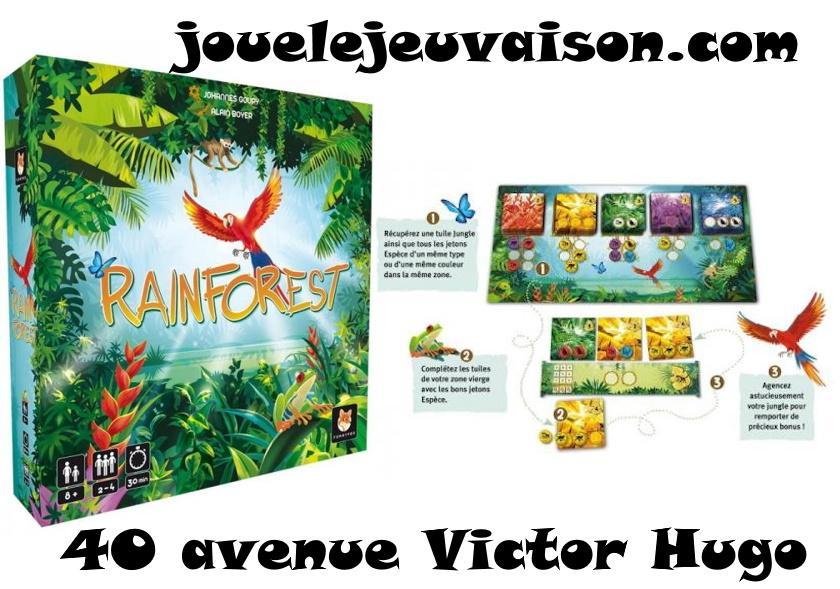
Hello everyone !
And today we’re gonna talk about Rainforest!
Go on an adventure in a lushed jungle, from 2 to 4 players aged 8 and more during 20 to 30 minutes, and save the animals !
In Rainforest, your goal is to create a jungle environment with a rich variety of vegetation, which will allow you to reintroduce and protect the region's iconic species: monkeys, frogs, butterflies and parrots. Don't forget to ensure the long-term survival of your totem animal, and you can earn valuable extra points. Will you be able to make your jungle a cradle of diversity?
Arrange your jungle as harmoniously as possible to help preserve certain animal species!
A game consists of a succession of game turns, during which players perform two mandatory actions in order:
– Take the first Jungle tile from a pile on the game board and place it in their blank area (under their personal board) or under the chosen pile if they do not wish to keep it.
– Collect all the Animal tokens of the same species or color found under the chosen tile and place them either in their reserve or on the tiles in the blank area in order to complete them. Some token locations require a specific color or species. When a Jungle tile is completely filled with tokens, it is placed in the Jungle (above the players' personal board) on the next location defined by the order given. Then, the active player checks if he meets the conditions to win one of the Bonus tokens (objectives for arranging tiles according to their colors). Finally, if an area of the game board no longer contains any tokens, tokens are added to the entire board to fill the empty spaces.
When a player validates his ninth tile, he triggers the end of the game. The final score to determine the winner takes into account:
– The points of the validated Jungle tiles
– The Species tokens corresponding to the player's Totem animal (defined at the start of the game)
– The tile arrangement objectives achieved (Protected Area and Balance tokens)
Good day and good game ;)
On 04/07/2025
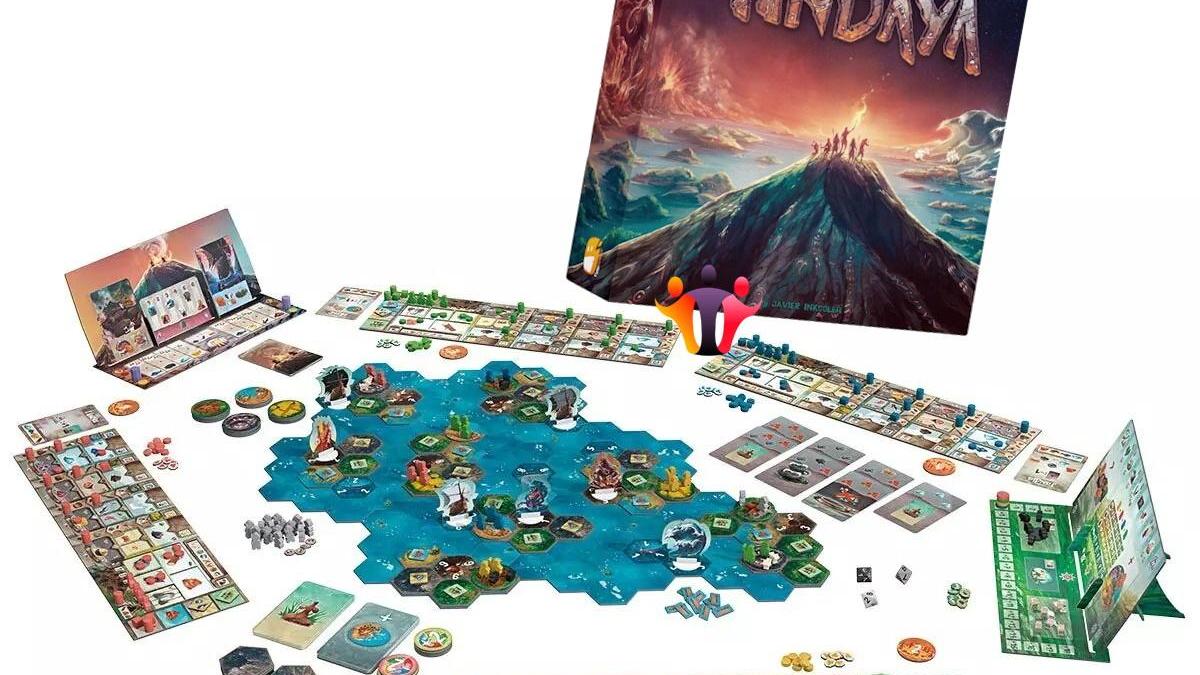
Hello everyone !
And today we’re gonna talk about Explora!
Let’s sail to Tindaya, from 1 to 4 players aged 13 and more during 45 to 120 minutes, and develop your tribes !
Tindaya is set at the dawn of the 15th century on the paradise known today as the Canary Islands. The conquistadors have just set eyes on it. Each player must lead an aboriginal tribe to survival in a world ruled by gods and shaped by natural disasters.
Tindaya is a theme-driven survival adventure with the soul of a eurogame. This environmentally conscious game offers two play modes to please any group: Cooperative (including solo) & Competitive, in addition to the Traitor variant for players avid of some old fashioned throat-cutting. Difficulty can be graded, and less experienced gamers can learn to play through a 3 game mini-campaign.
During 3 phases, natives will settle, progress, and battle invaders, all within a mythological setting ruled by two gods, Acoran & Moneiba. They will demand specific goods at each stage of the game. If the natives are unable or unwilling to provide them, their godly rage will be unleashed. But players are not alone; two seers will make predictions by reading the smoke of their bonfires. Tibiabin will see the disasters to come. Tamonante will predict where they will happen. Disaster markers will be placed on the board to signal what is to come.
In Cooperative mode, players will check if their collective mission has been achieved. If so, the gods will be happy, and all natives win the game. In Competitive mode, solidarity points will be granted to players that have given more to the community, used fewer resources, or achieved both collective and personal objectives. The player with more points will win the game.
Good day and good game ;)
On 27/06/2025
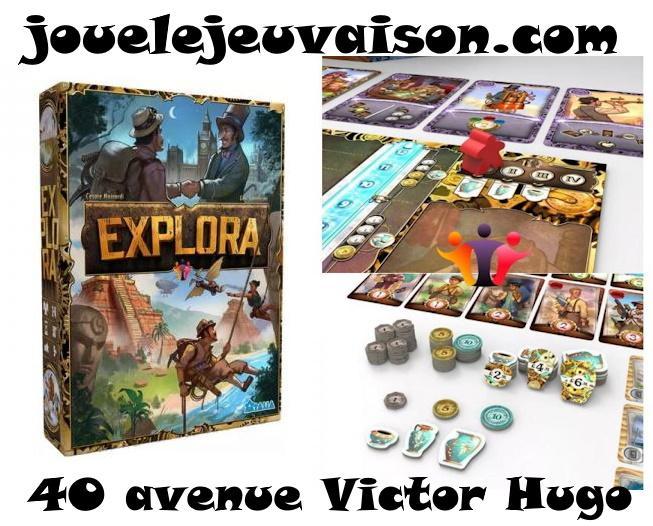
Hello everyone !
And today we’re gonna talk about Explora!
Take your auction game, from 2 to 4 players aged 9 and more during 20 to 40 minutes, to launch expeditions to mythical places !
Build the best team, bid wisely to acquire a good vehicle and be the first to reach El Dorado or Atlantis!
Unless you prefer to push the others to outbid to end up the richest...
Take turns to acquire cards at the market by offering the best bid.
Form two teams, each composed of an adventurer, a crew and a vehicle.
Be careful with the initiative track because the player who made the highest bid advances his marker while the one who made the lowest bid moves back.
This track will be very important in determining the allocation of prestige points for each exploration.
As soon as three cartographers are revealed, you can go on an expedition and choose the teams to send in order to earn reputation points.
The game ends after the fourth exploration.
The player who has earned the most reputation points wins the game
Good day and good game ;)
On 20/06/2025
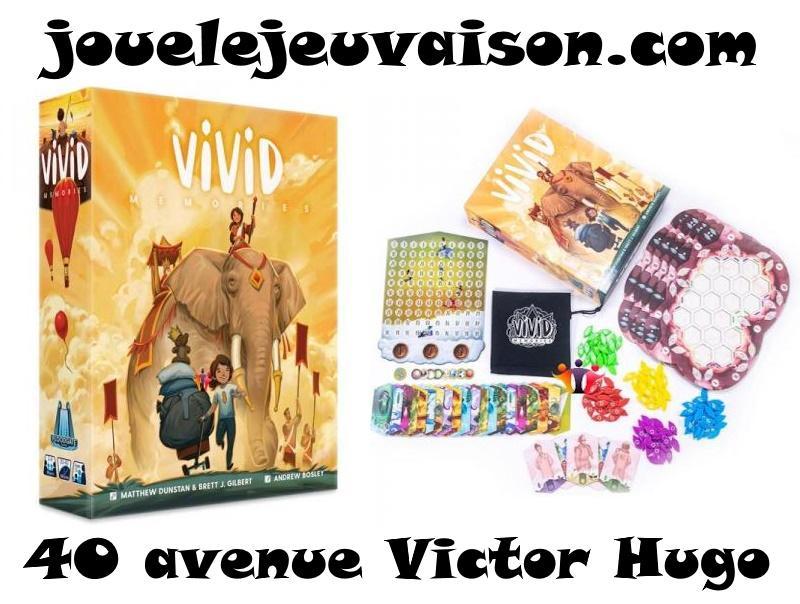
Hello everyone !
And today we’re gonna talk about Vivid Memories !
Collect fragments of childhood memories, from 2 to 4 players aged 13 and more during 30 to 45 minutes, and weave valuable memories !
Every stick is a sword. Every bike is a steed. Every memory is a possibility.
In Vivid Memories, you’ll take turns collecting fragments of childhood memories, weaving a tapestry of colored threads in your mind. Throughout your journey, you’ll store important moments in your memory bank -- gaining new abilities to help you score.
Cleverly create connections and earn rewards for completing core memories, matching the imagination behind each moment, and working toward your lifelong aspirations for victory.
During the game, players take turns collecting fragments of memories from moment tiles, placing them in their "brain" board to weave a tapestry of colored threads.
Using abilities at the end of each round to cleverly create connections, players are rewarded for how they store memory fragments while working toward completing “core memories”, which give repeated benefits each round.
Through their journey, players store important moments in their memory bank -- gaining new abilities and new opportunities to score -- all while working to collect fragments and moments that match what they aspire to be.
Good day and good game ;)
On 13/06/2025
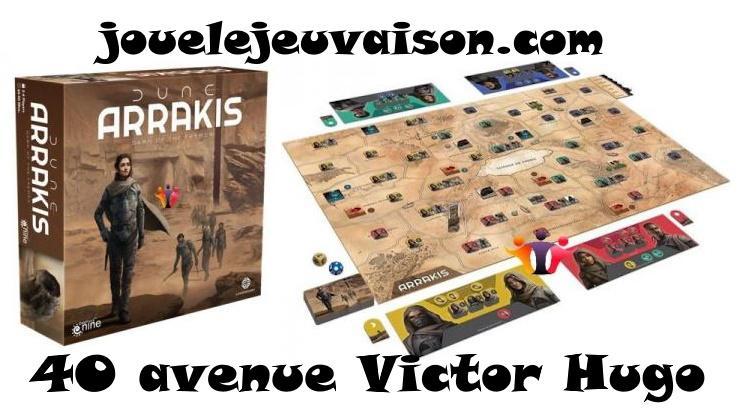
2 words game Dunes Arrakis Dawn of Fremen
Hello everyone !
And today we’re gonna talk about Dune Arrakis !
Take control of the sietches, from 2 to 4 players aged 14 and more during 60 to 90 minutes, to win the village’s dominance !
Arrakis Dawn of the Fremen takes place more than a hundred years before the events recounted in F. Herbert's first novel and the arrival of the Atreides on the planet. Players embody Fremen tribes who must learn to adapt to this inhospitable land. Players will have to make choices, collaborate, fight, negotiate to survive and build the first troglodyte sietches (Fremen villages).
To win the game, a player must be the first to control 3 sietches at the end of an action phase (or 5 if he has allied himself with another player). At any time, by decision of the council (all the players), a player can be declared the winner if his opponents unanimously recognize that they will no longer be able to win the game. A way to allow players to end a game at any time where a player has irremediably taken the upper hand. Conversely, players can also decide to modify the number of sietchs to control if they want a longer game.
The game takes place on a large board representing the Arrakis desert, divided into territories. Each player takes command of a tribe. Randomly, players designate a 1st player. In the opposite direction of the turn, they start by placing rock barriers between the territories, at each player's choice, then 12 production sites (water, food, spice and worm tooth) at random on the board without looking at them. Then, the 12 sites are revealed: each site will produce the resource indicated each turn which will be recovered by the player who controls the territory. Players finish the setup, in the opposite direction of the turn, by deploying a warrior on a territory, until all the territories are controlled by a player. Finally, each player places a worm in a territory that he controls.
Players play in phases. The development phase where players can spend resources to obtain a distillate, a krys or build a sietch. The production phase where players' territories develop resources depending on the full moon, twin moons or crescent face.
The trade phase where players roll the Arrakis die. On a storm face, the phase is not resolved; on a vote face, it is the players who decide; on a 1st player face, it is the 1st player who decides; on all other faces, the phase is resolved. If the phase is resolved, successively, players can propose an exchange (resources and/or cards) to another player. The exchanged resources must be placed in a controlled territory.
The expedition phase where players can move one or more resource tokens from one territory to an adjacent territory. If the player has a distillate, a worm or other elements granting a movement bonus on his territory, he can move his tokens over longer distances! He can very well deposit tokens during movement and recover others, within the limit of his total movement value.
This phase is essential to cleverly group his resources. The possibilities are numerous by recovering/depositing tokens during his movement!
The action phase where the players will successively resolve two actions among search or attack and dispatch or attack.
To Search, the player draws a Search card and obtains the indicated bonus: resource, development object or new capacity.
If he wishes to attack, he designates his target. The defender calculates his defense value equal to the sum of his defense present on the territory.
If the defense value is higher than the attack value, the latter fails and the player must target another territory or perform another action. On the other hand, if he wins the fight, the attacker takes control of the territory with the tokens present (resources, sietch, distill, ...) and gains an additional water resource.
The council phase where players unanimously decide to modify victories or immediately declare a winner.
At any time, two players can decide to officially ally, with the approval of the other players. In this case, to win the game, they must control 5 sietches and can exchange territories or cross alliance territories. An alliance can be broken by unanimous decision of the council. Players can even decide at the beginning of the game to play in alliance (2 vs 2).
The game ends by decision of the council, or as soon as a player controls 3 sietches or an alliance 5.
Good day and good game ;)
On 06/06/2025
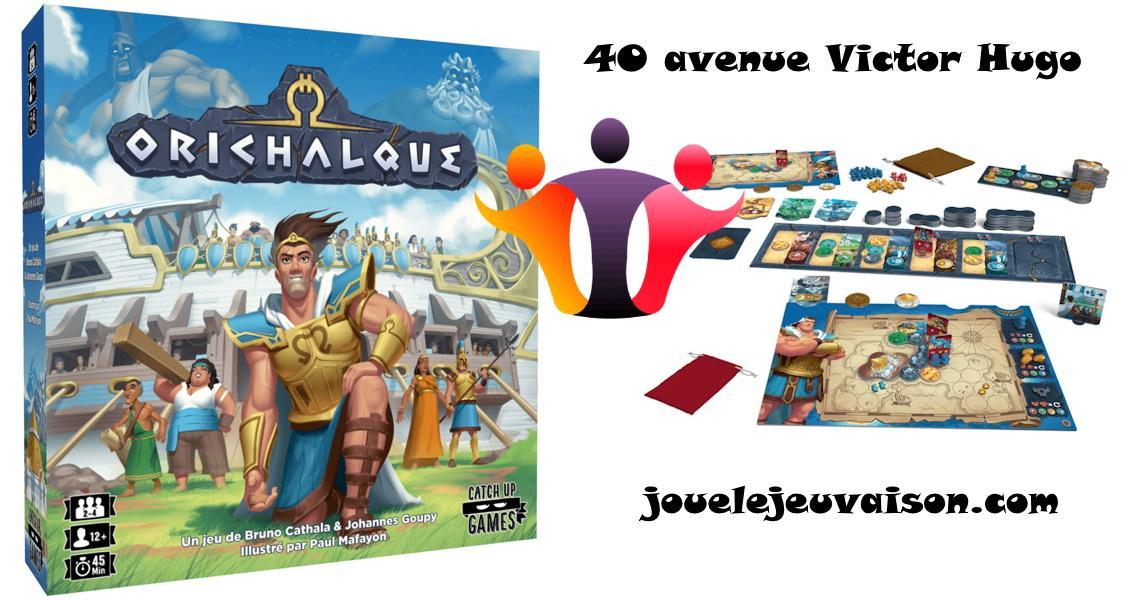
Hello everyone !
And today we’re gonna talk about Orichalcum !
Warriors it’s up to you, from 2 to 4 players aged 12 and more for 45 minutes, to save Atlantis.
The prophecy of Atlantis is coming true, the cataclysm is coming! You have been sent in search of a new homeland. Explore the island, exploit its resources and rid it of the monsters that infest it to prepare for the great exile!
Build temples, forge Orichalcum medallions and attract the attention of the titans to be the first to obtain 5 victory points and win the game!
You will have to explore the island, produce resources, develop your base camp and confront the creatures that populate the island.
On Atlantis, thunder rumbles, the ground trembles and entire sections of land disappear under the waves! The Oracles are unequivocal: the prophecy of the ancients is coming true and the entire island is going to be swallowed up.
Faced with the imminent cataclysm, the king has sent his explorers in search of a new land that can welcome the Atlantean people. The survival of your entire civilization depends on it! You are leading an expedition.
You must be the first to find a welcoming land for your people!
Orichalcum is a race... against your opponents. The winner will be the one who is the first to accumulate 5 victory points above their board AND have eliminated all the Creatures on their island!
There are three ways to win victory points: attract the attention of the Titans, build Temples and forge the precious medallions of Orichalcum, this legendary ore whose secret the Atlanteans hold.
You begin each of your turns by selecting an Action card from those available in the center of the table. This choice has two consequences: it determines the Terrain tile that you will place on your island and the action that you can perform during this turn.
The 4 actions of the game will be valuable to be declared the winner. You will be able to Capture the Creatures populating your island. Recruiting Hoplites will be essential to fight but also useful to have more choices when selecting your Action card.
Building will earn you victory points by forging Orichalcum medallions or erecting Temples. And the Buildings you build will give you the abilities to develop your civilization.
Finally Producing Orichalcum will be essential if you plan to forge the precious Orichalcum medallions to win!
Good day and good game ;)
On 30/05/2025

Hello everyone !
And today we’re gonna talk about Thorgal !
Be smart enough, from 1 to 4 players aged 10 and more for 30 to 45 minutes, to escape.
Experience Thorgal's adventure! Players embody Thorgal and his companions. Together, they leave the Viking country and cross the great ocean to reach the country of Qâ, a continent at war. There, they face the troops of Ogotaï, a demigod who wants to declare war on all of humanity...
Each turn takes place in several phases: the heroes' fitness, the Hero's Turn (each in turn) then the Ogotaï phase.
A Hero's turn is divided into 3 successive phases: A. Destiny Phase B. Chaams Phase C. Action Phase.
The game ends as soon as a Hero reaches the Laboratory at the end of the Location card track and spends 6 identical Skill cards of his choice to defeat Ogotaï. He must do this before Ogotaï wins the game.
Unfortunately, the latter wins the game if he reaches the top of the pyramid, if Chaam cards are already placed on each discovered location card, or if there are no more cards in the Chaam draw pile when one must be drawn.
Good day and good game ;)
On 23/05/2025
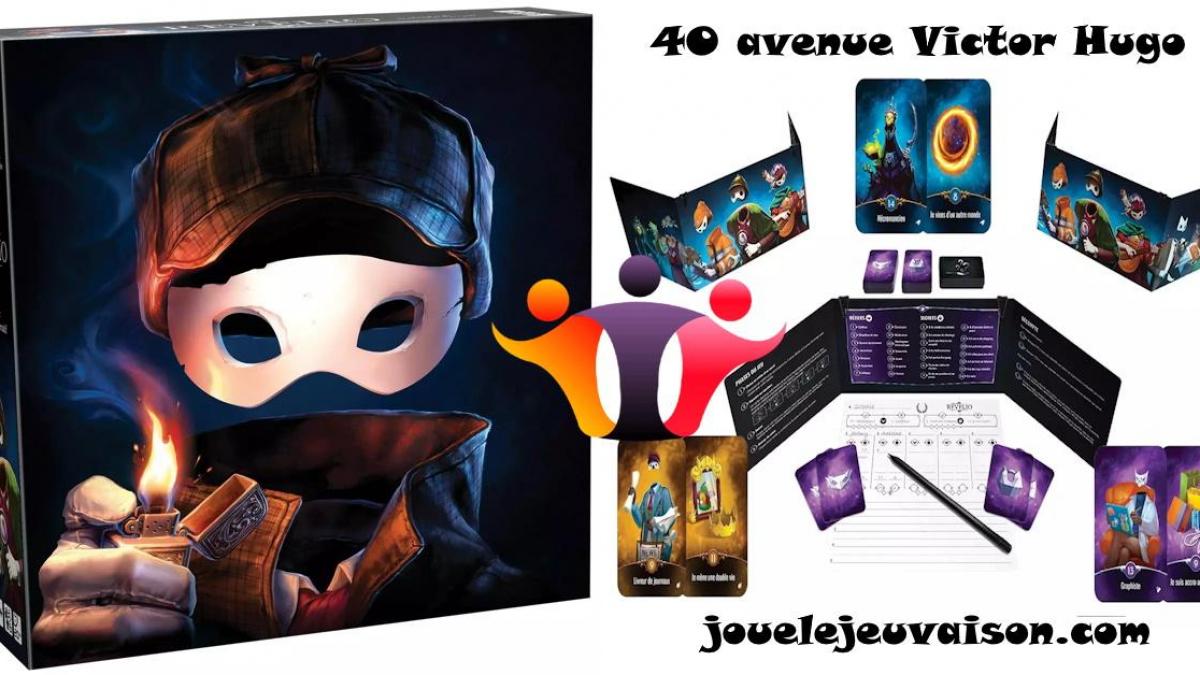
Hello everyone !
And today we’re gonna talk about Revelio !
It’s up to you to investigate, from 3 to 6 players 14 old and more for 20 minutes, to have no whit of doubt.
Doubt is everywhere! You have always loved investigating various incidents. So, when you heard about a circle of amateur private detectives, your blood boiled. Only, you must first pass a test: sitting at a table with the other candidates, you must succeed in identifying their profession, and the secret they hide.
In Revelio, players will embody a character from a specific universe: medieval-fantasy, Victorian or contemporary, exercising a specific activity and keeping a very particular secret.
In each of the 5 rounds, the players will all answer the same question as their character would, revealing a few clues about their personality, so that the others end up discovering who they are.
But not all of them, otherwise, the player does not score any points. And he himself must find the identity of the others, profession and secret, to add points that will allow him to win!
Good day and good game ;)
On 16/05/2025
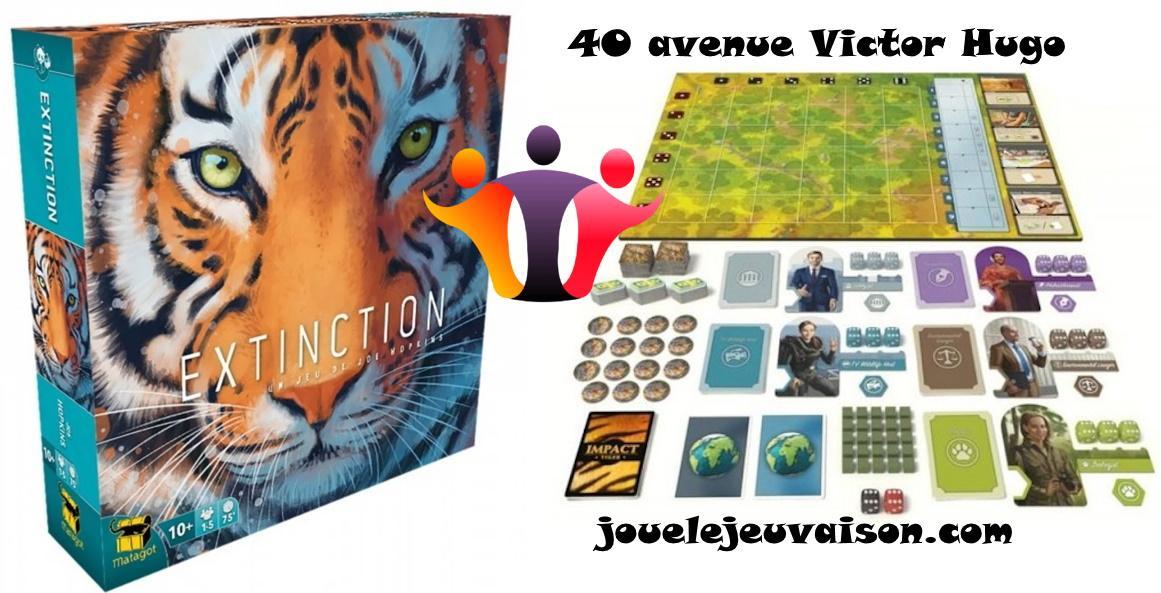
Hello everyone !
And today we’re gonna talk about Exctinction Tiger !
Work with your fellow conservationists, from 1 to 5 players from 10 and more and 75 minutes, to save tigers and sea otters from extinction.
The march of humankind’s progress threatens the survival of many species. It's up to you and your team to save them!
Influence the UN to save the animals and stop environmental destruction. If four UN ambassadors vote yes on the resolution then the players win. But until the vote takes place, players need to keep the destruction at bay, and keep the animals alive!
Each turn players will roll the dice they can allocate to action cards. After actions are taken, mating pairs will have a chance to procreate, and destruction tiles will enter the board, possibly killing already scarce animals.
Play as the Zoologist, Philanthropist, TV Wildlife Host, Lobbyist, or Environmental Lawyer, each with a special ability.
Time is short. Can the animals be saved while also influencing the Ambassadors' votes? Or will threatened animals be lost forever?
Extinction is a cooperative strategy and board game for 1 to 5 players. Take on the role of conservationists and work together to save endangered animal species, such as tigers and sea otters. Face complex challenges, influence the UN and protect biodiversity!
Good day and good game ;)
On 09/05/2025
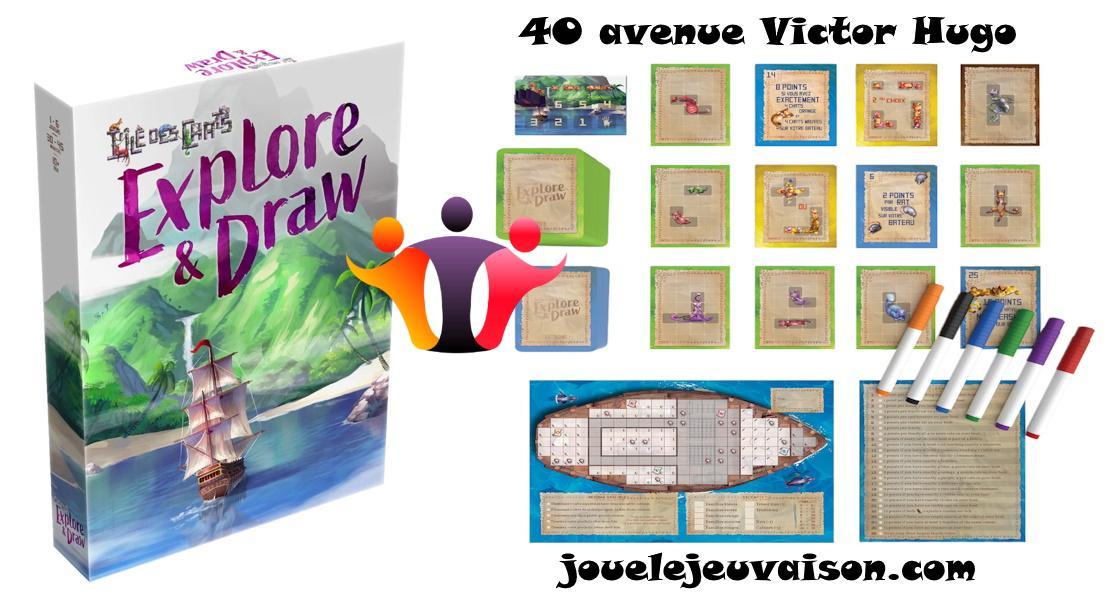
2 words game Isle of cats explore and draw
Hello everyone !
Today we’re going to talk about Isle of cats Explore and Draw!
Boats afloat, from 1 tp 6 players from 10 and more for 30 to 45 minutes, to place and save the cats!
The Isle of Cats Explore & Draw features gameplay like The Isle of Cats, but with players now choosing a set of cards each round instead of drafting, and then drawing their discoveries onto their boat.
Explore & Draw is a competitive, polyomino cat-placement board game for 1-6 players that is ideal for a quick break or taking to a friend’s house.
In the game, you are citizens of Squalls End on a rescue mission to The Isle of Cats and must rescue as many cats as possible before the evil Lord Vesh arrives. Each cat is represented by a unique shape and belongs to a family, you must find a way to make them all fit on your boat while keeping families together.
You will also find treasures, Oshax (special cats), and ancient lessons which give you another personal way of scoring points.
Complete lessons, fill your boat, and keep cat families together to score points, and the player with the most points after seven rounds wins.
Good day and good game ;)
On 02/05/2025
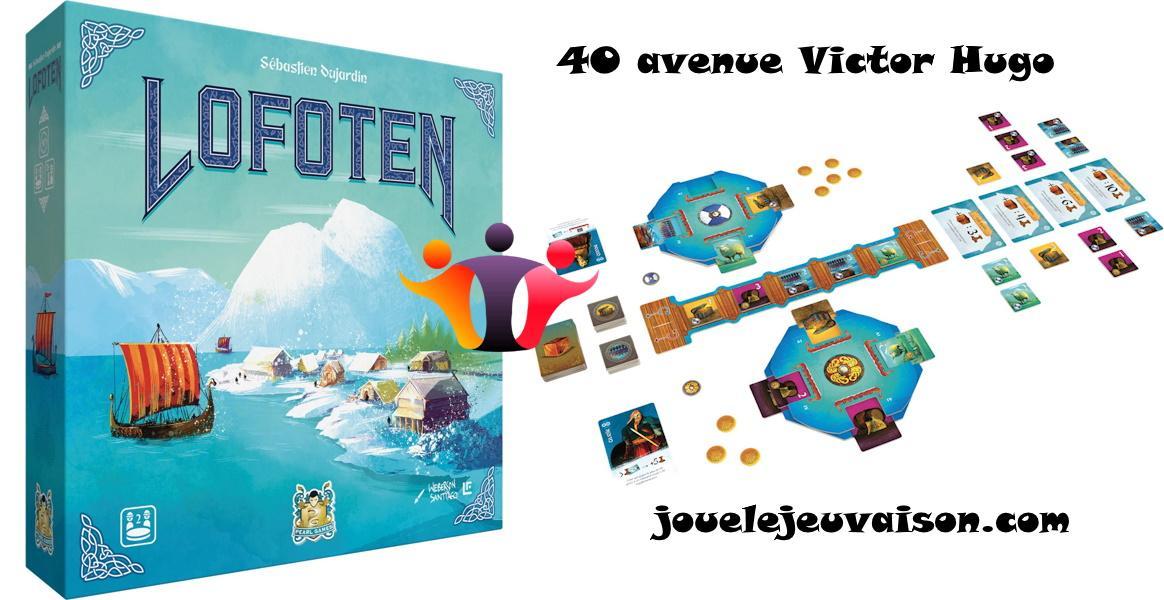
Today we’re going to talk about Lofoten!
Allmighty Jarls, face to face, aged 10 and more for 40 minutes, expand your territory by skillfully negociating and conquering !
Now considered to be one the most beautiful archipelagos in the world, Lofoten was an important Viking territory. Knowing how to adapt to various situations, Vikings were not only peaceful settlers and builders, but invaders and skilled merchants, as well.
With your fleet of longships, you are determined to make the most of the 4 essential goods.Also try to become the most powerful Jarl of the archipelago!
In Lofoten, you must load merchandise from the market into your longships, and bring them back to your clan. For each type of merchandise, a particular scoring will grant you an advantage over the opposing Jarl. No matter what the situation is, your goal is to earn more PP (Power Points) than the opposing Jarl in the final scoring, to become the most powerful Jarl in the archipelago!
Lofoten, is a game for two players with innovative card hand management and a rotating board.
Good day and good game ;)
On 25/04/2025
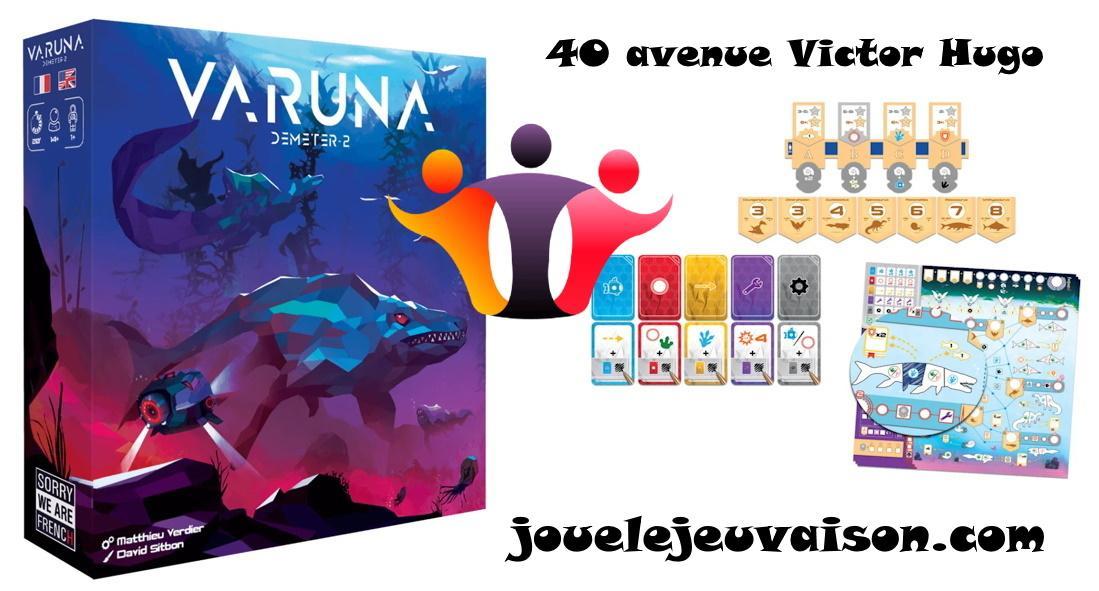
Today we’re going to talk about Varuna!
Embody a scientist on mission on Varuna, from 1 player aged 14 and more for 20 minutes, discover and study the aquatic dinosaurs from the second planet of Demeter !
It has the particularity of being 89% covered by oceans and populated by dinosaurs, the vast majority of which are aquatic. It is therefore aboard a state-of-the-art exploration submarine that you will discover the almost twin sister of Demeter 1.
A flip and write that takes place in the space universe of Ganymed and Demeter.
You will also be able to use and improve your submarine, make discoveries, progress in research, use a sonar to locate and better understand these underwater species.
A game of Demeter lasts 13 turns. Each turn, players perform 3 phases: reveal a card from each deck, choose a card( suffer any damage and trigger the action of the selected card) and resolve the bonus corresponding to the chosen card.
The game ends at the end of the 13th turn and players score Mission Points in several categories: species discovered entirely, use of sonar, diversity of species discovered, fish studied, scientific objectives, etc.
Add these categories, then subtract the damage suffered by your submarine. The player with the most Mission Points wins the game!
Good day and good game ;)
On 18/04/2025
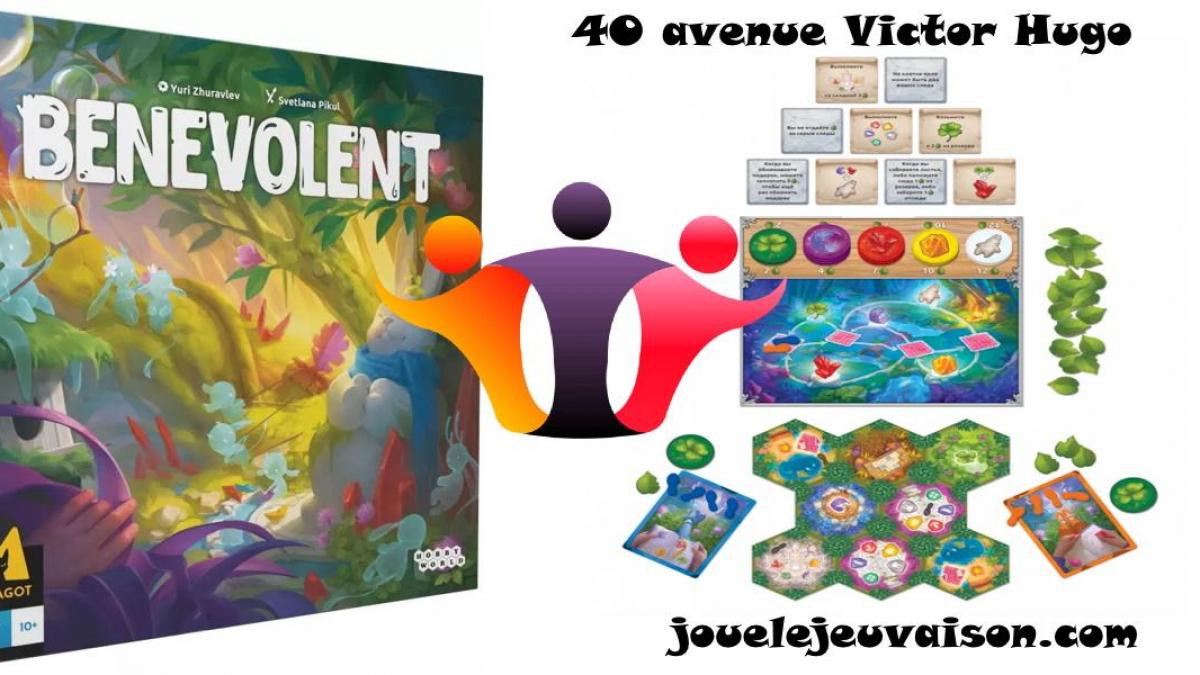
Today we’re going to talk about Benevolent!
Be ready to follow an adventure at the heart of the forest, from 2 to 4 players aged 10 and more for 25 minutes, to find all the hidden treasures !
Far away from the big cities lies a mysterious forest. Thousands of years ago, there lived tribes that worshiped the spirits of the woods. Even now, ruins of their sanctuaries, conquered by ivy and amarbel, can be found among the trees. Rumour has it that those spirits have always been benevolent and sometimes leave their guests precious gifts: a piece of amber here, a bluebird’s feather or an ancient figurine of some outwardly stone there…
Now it’s your time to head out to the magical forest, earn respect of its guardians and collect all their gifts!
Every player takes the Character card and all 5 Footsteps of their chosen color and places 1 Footstep on the first position of the Dream Path. Assemble the forest board according to the player count.
Players take turns clockwise starting with the first player.
When a players has all 5 different gift tokens (no matter how many of each kind), the game immediately ends and that player wins.
During your turn you must move first, and then perform an action.
Movement:
Place one of your Footsteps onto a hex without your Footstep.
You can’t place your Footstep onto a hex where you already have a Footstep.
You can’t place your Footstep onto a hex if there are no adjacent hexes with your Footsteps.
Action:
After the movement phase you must perform an action on the hex where you’ve just placed the Footstep. You have two options:
Perform that hex’s action — but first you must pay Leaves for all Footsteps there, except yours.
Gather Leaves — take 2 Leaves from the supply.
Players continue taking turns until one of them wins.
Good day and good game ;)
On 11/04/2025
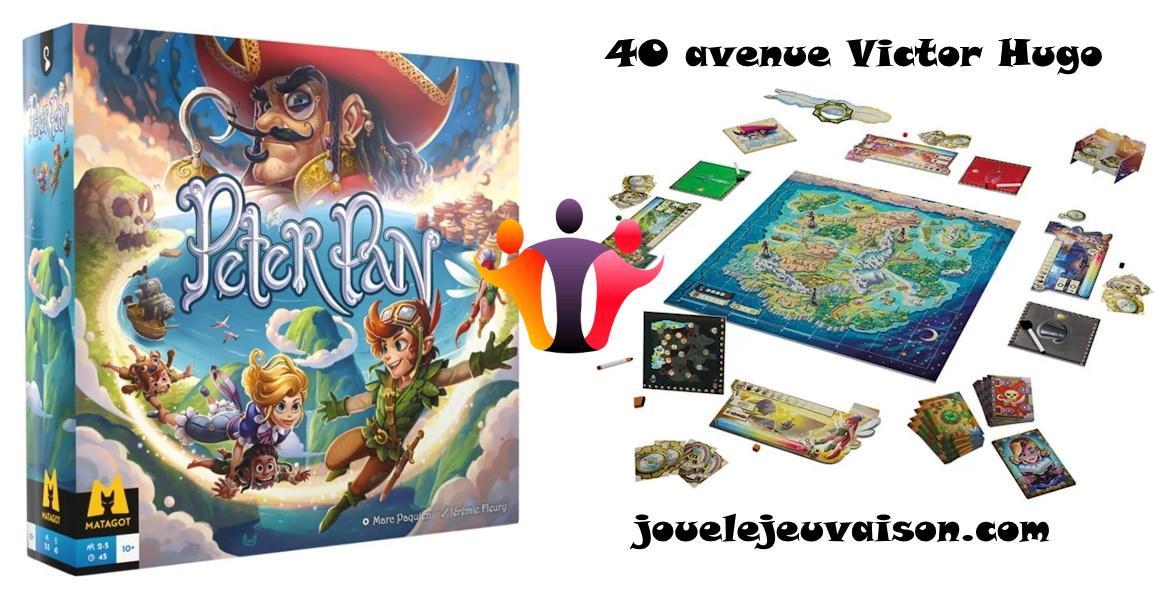
Today we’re going to talk about Neverland !
Following the leader, from 2 to 5 players aged 10 and more for 45 minutes, to find all the lost kids in Neverland !
Welcome to Neverland! Become Peter, Wendy, or many others. Go out on a quest to find the Lost Children who...got lost on the island.
Explore every location, lead the other players wisely to finding some of the Lost Children. You will need to co-operate to find them all. After the game, the island will change for the next time those children lose themselves — and you know it will happen again!
After choosing your character and learning about your special abilities in Pan's Island, each player is responsible for hiding a pirate and a Lost Child. Thanks to a hand of clue cards representing dreams made by the characters, each player can give clues on the location of the Lost Children or the pirates to avoid.
These clue cards are played on another player's board by placing them on a "scale of relevance" ranging from "Exactly" to "Not at all".
The player then needs to correctly interpret the clue to move around and search for the Lost Children in the correct area. The game is won when five Lost Children have been found, but it ends if you encounter the pirates more than twice.
At the end of a game and depending on your success, event cards will change the topology of the island, bring in new rules, and determine how you pursue your adventure.
If you've lost, the island may become easier to explore or make you more powerful, but if you've won, new obstacles appearing on the island will make your new adventures a bit more difficult quest.
Good day and good game ;)
On 04/04/2025
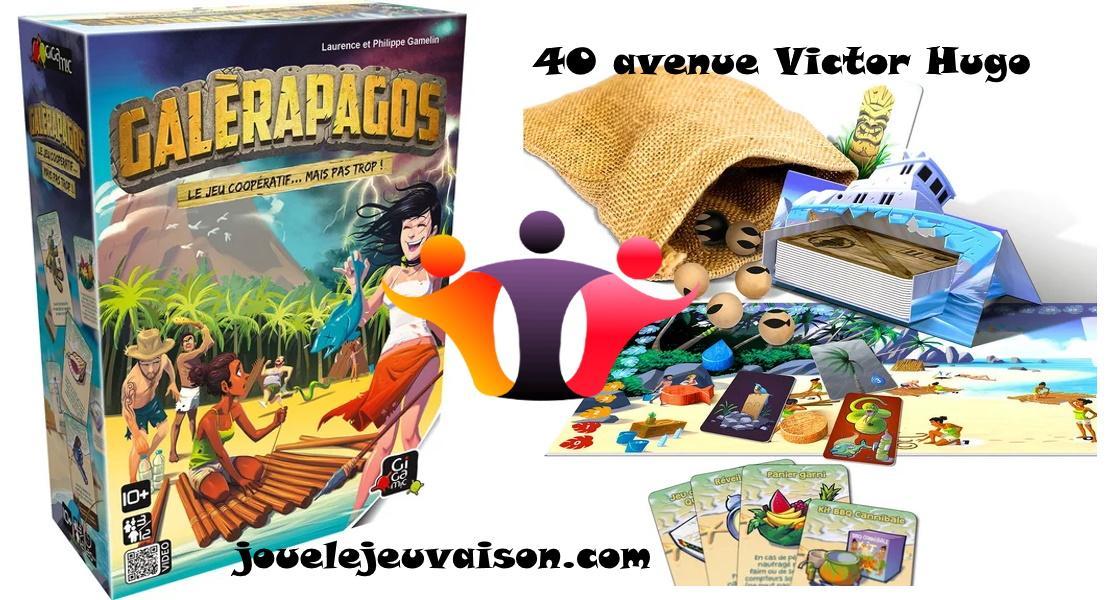
Hello everyone !
Today we're going to talk about Hellapagos!
It's up to you to do everything you can, from 3 to 12 players aged 10 and over for 30 to 60 minutes, to escape the island you survived on before the storm destroys it!
Hellapagos is a "co-opetition" game in which players struggle to survive on a desert island and build a raft to escape before a hurricane devastates them. While players need to work together, it's not likely that everyone will survive this backstabbing negotiation game for up to twelve players.
After becoming shipwrecked, your group of castaways finds themselves on a desert island. At first, the surroundings seem like paradise, but life soon proves difficult. Water and food are scarce. It’s doubtful whether everyone can survive this diet.
There is only one solution: Construct a large raft together. But don’t waste any time, because the clouds on the horizon suggest the arrival of a dangerous hurricane!
After your ship sinks, your group of survivors finds themselves on a desert island where water and food are scarce. The only solution to escape this nightmare is to build a large raft together to take the survivors on board, but time is running out because a hurricane is on the horizon...
Each turn, the shipwrecked players will have to choose one of four actions: fishing, collecting water, looking for wood or searching the wreck of the ship.
Team up to survive but be prepared to sacrifice your comrades in the event of a shortage.
An almost cooperative game where you will have to be as deceitful as diplomatic to guarantee yourself a place on the return trip!!
In this cooperative game, each turn takes place in a strict order. First, the change of the first player. Except in the first round, the first player card will pass into the hands of the person to the right of the player who had it in the previous round.
Then a weather card is drawn, this is used when collecting water. Indeed, when a bright sun shines it is impossible to collect water. After that, it is the players' turn, they will be able to perform one of the four possible actions.
To catch a fish, the player will have to draw a ball from the bag and advance the food token according to the number of fish indicated on it.
Unless it is very sunny, it is possible to advance the water token according to the number indicated on the weather card.
The player must advance the wood token one step and decides to draw (or not) one or more additional balls from the bag. If the black ball does not appear the player can advance as many spaces as balls drawn, otherwise he will be bitten by the snake and will be poisoned.
The player draws a wreck card and adds it to his hand.
Last step, the survival of the castaways. You will have to count the water and food. Starting with the water, you will have to move the pawns back by the same number as there are players. Be careful, if there is not enough water or food, a vote will be held to see who will survive.
To win the game, you must have left the island alive before drawing the hurricane card from the weather deck. At the end of the game, the players who manage to leave the island in time will win (assuming anyone survives that long!).
Good day and good game ;)
On 28/03/2025
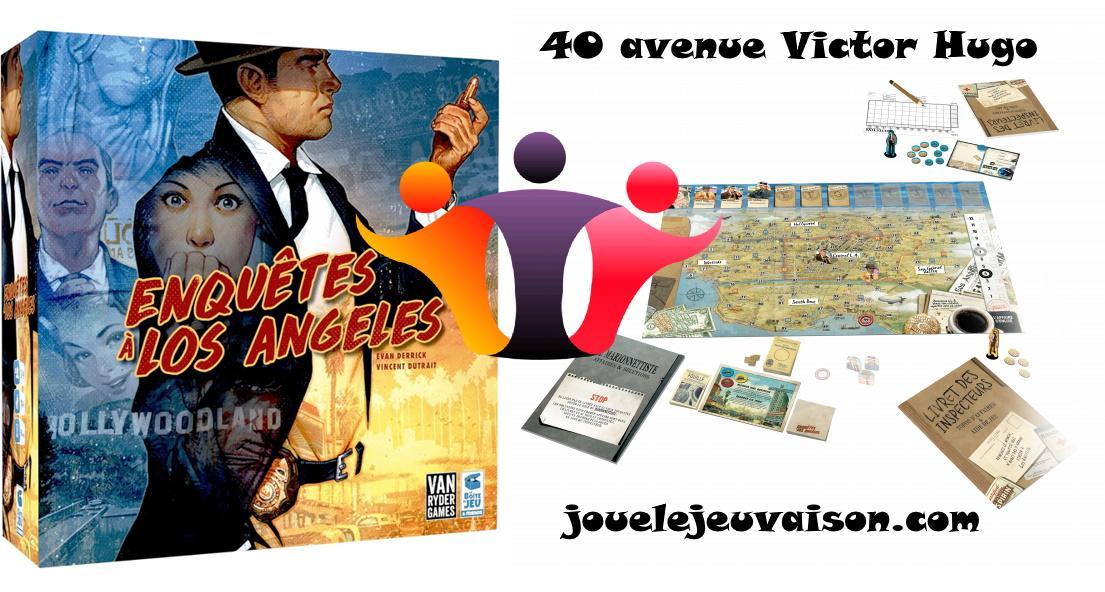
Hello everyone !
Today we're going to talk about Detective L.A.!
It's up to you to search, from 3 to 9 players aged 14 and over for 90 minutes, by clarifying the most secret mysteries!
Detective: City of Angels, set in the dark and violent world of 1940s Los Angeles, is a game of mystery, deception, and investigation for 1–5 players. Most players will step into the shoes of LAPD homicide detectives, hungry for glory and willing to do whatever it takes to successfully close a case, even if that means intimidating suspects, concealing evidence, and hiring snitches to rat on their fellow detectives. One player, however, will take on the role of The Chisel, whose only goal is to stall and misdirect the detectives at every turn using bluffing, manipulation, and (often) outright lies.
Detective: CoA uses the innovative ARC (Adaptive Response Card) System to create the feel of interrogating a suspect. Suspects do not simply give paragraph-book responses; instead The Chisel carefully chooses how they will answer. When Billy O'Shea insists that the victim was a regular at Topsy's Nightclub, is he telling the truth or is The Chisel subtly leading the detectives toward a dead end that will cost them precious time? Detectives can challenge responses that they think are lies but at great risk: If they're wrong, The Chisel will acquire leverage over them, making the case that much harder to solve.
Detective: CoA includes separate, detailed casebooks for both the detectives and The Chisel. Each crime is a carefully constructed puzzle that can unfold in a variety of ways depending on how the detectives choose to pursue their investigations. As the detectives turn the city upside down, uncovering fresh evidence and "hot" leads, hidden suspects may be revealed and new lines of questioning will open up, creating a rich, story-driven experience.
Inspired by classic film noir like The Big Sleep, the works of James Ellroy (L.A. Confidential), and the video game L.A. Noire from Rockstar Games, Detective: City of Angels is a murder-mystery game unlike any other. Will one detective rise above the rest and close the case on L.A.'s latest high profile murder? Or will The Chisel sow enough doubt and confusion to prevent the detectives from solving the crime?
A "sleuth" mode allows 1 or more players to play fully cooperatively, solving the cases together.
Good day and good game ;)
On 21/03/2025
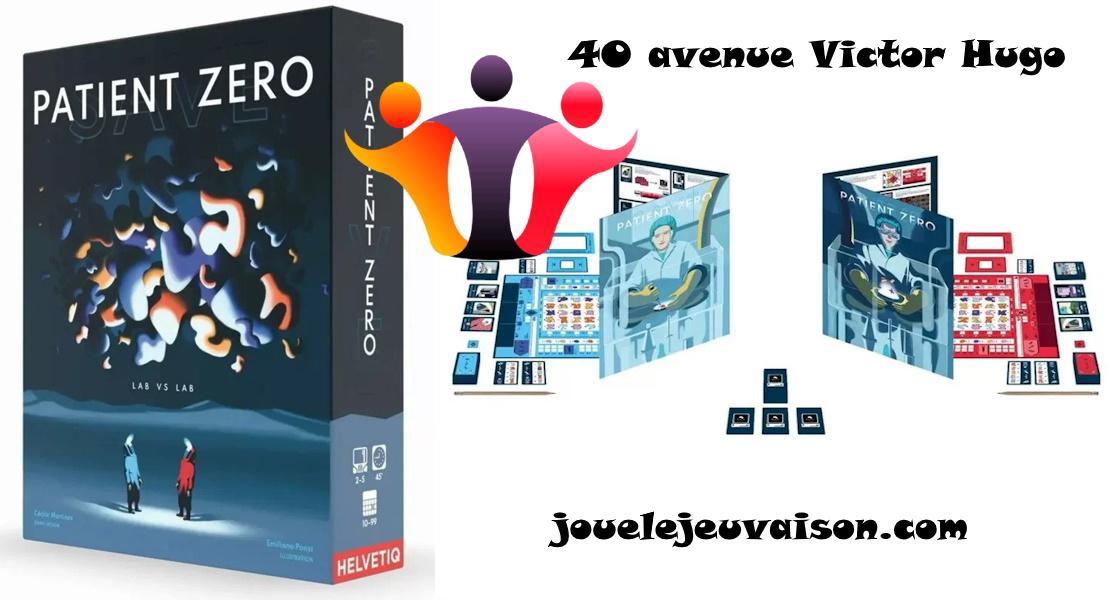
Hello everyone !
Today we're going to talk about Patient Zero!
It's up to you to research, from 1 to 7 players aged 10 and over for 30 minutes, by finding the patient who will help
you to save lives!
A new pathology has just appeared! Patient Zero has been identified, and it's up to you to find the antidote as soon as possible to save the patient and humanity!
Save Patient Zero pits two labs against each other. Each lab employs one or two scientists (i.e., players), while another player plays a lab computer named Savvy. The labs compete to identify an antidote of three molecules, with the labs typically sharing no information with one another; whichever lab finds the antidote first wins.
The general idea of the game is to use lab tools in the best sequence possible to identify the three molecules out of 25 that make up the antidote. (These 25 molecules are arranged in a 5x5 grid on each lab's worksheet.) At the start of the game, Savvy looks at the top three molecule cards in that deck, then sets them aside. These are the molecules the labs must identify. On a turn, each lab submits a tool card to Savvy to show what they want to do in the round, and whichever lab submits first takes its action first in that round.
Actions include:
- Samply: Draw three sample cards from your lab's deck, and give them to Savvy. Each sample card depicts five molecules, and Savvy will identify which of them show at least one molecule used in the antidote.
- Mikroskopo: Choose two cards from your lab's deck, and give them to Savvy, who will treat them like the cards in "Samply".
- Dedukto: Receive five molecule cards from Savvy. You (but not the other lab) now know these molecules are not in the antidote.
- Centrofugo: Place your centrifuge on your lab worksheet so that it points to four molecules. Savvy then indicates whether any of these molecules are in the antidote.
- Scanpad: Place a cardboard device on your worksheet to highlight six molecules in a 2x3 grid. Savvy then indicates how many molecules highlighted (0-3) are part of the antidote.
- Spionado: Savvy takes two lab cards from the opposing lab that do not have any molecules in the antidote on them, then shows them to you.
- Antidote: Circle three molecules on your worksheet. If all three are in the antidote, you win! If not, Savvy will indicate how many of the circled molecules are in the antidote.
Each lab has a limited number of actions in its deck — eighteen total, with three Samply, two Dedukto, one Scanpad, two Antidote, etc. — so use them wisely, especially the Antidote because if you fail to identify the correct three molecules a second time, then your lab loses the game automatically.
To play Save Patient Zero as a two-player game, each lab draws three molecule cards from the deck, and the opposing lab must identify these three molecules before you can identify the three molecules they drew. Each lab takes the role of Savvy for the opposing lab.
Good day and good game ;)
On 14/03/2025
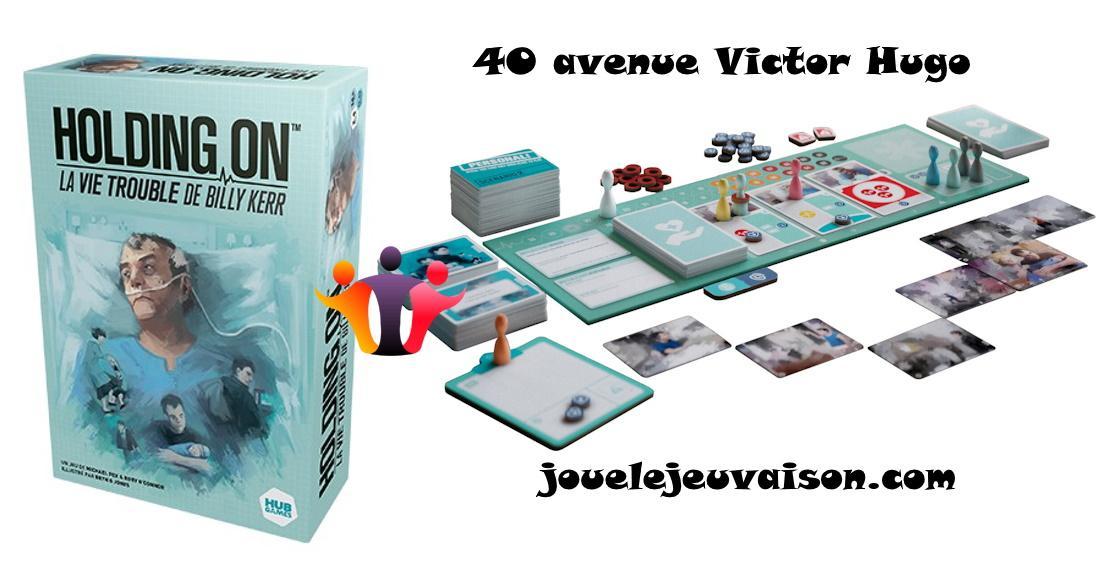
Hello everyone !
Today we're going to talk about Holding On!
It's up to you to cooperate, from 2 to 4 players aged 14 and over for 45 to 60 minutes, by winningBilly Kerr’s trust and to accommodate him the best way!
"All my life I've kept my mouth shut - out of loyalty, out of fear... out of shame. And look where it's got me, lying here with my rear-end hanging out of a blue gown, all you lot fussing around me. Sure, that's no way to live. No way to die."
Holding On: The Troubled Life of Billy Kerr is a co-operative game where players work as nursing staff tasked with providing care for the terminally ill. Your latest patient has been rushed in following a massive heart attack on a flight from Sydney to London. When the game begins, all you know is this - his name is Billy Kerr, he is sixty years old, and he has been given days to live.
Players must work together to provide Billy with appropriate care, responding to medical emergencies while gaining his trust. Over ten fully replayable Scenarios, you will need to piece together a lifetime of memories while being drawn deeper into his troubled past. As you discover more about Billy, can you help him find the courage required to confront the three regrets that keep him holding on?
Dealing with themes of dying and regret, Holding On: The Troubled Life of Billy Kerr invites players to experience the extraordinary life of an ordinary person in his final days.
Good day and good game ;)
On 07/03/2025
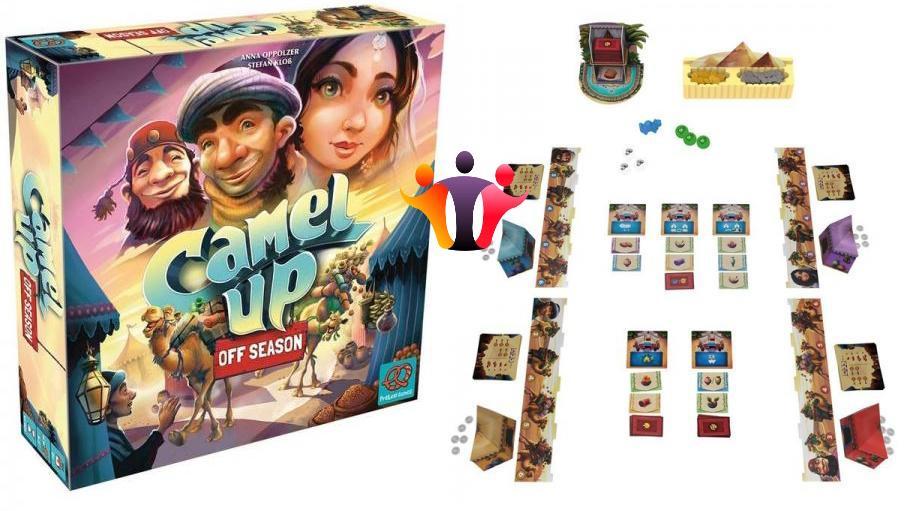
2 words game Camel Up Off Season
Hello everyone !
Today we are going to talk about Camel Up Off Season!
Desert merchants, from 3 to 5 players, from 8 years old from 45 minutes, optimize your goods to sell as much as possible.
The chaos of Camel Up racing is fading, but what do racing camels do during the off-season? They help merchants transport valuable goods!
However, some merchants are more ambitious than others when sourcing.
Will all the goods they have acquired be able to be properly loaded among the animals in their caravan or will they lose everything before even having the chance to sell them?
Take part in the most popular auction in the desert and use your talents to become the most successful merchant of all!
In Camel Up Off Season, each player plays a merchant with a caravan of camels. Players will bet on lots of merchandise with one goal in mind… generate profits!
However, if they are too greedy and collect too much goods, their camels will be overloaded, and the precious goods will fall and be lost forever in the desert.
Each round begins with an auction to determine the 1st player. The type of bid for the current round is indicated by the top card of the draw pile. However, most auctions follow the same rules as a standard auction, as described below.
Players secretly place coins in their fist. When all players are ready, the bets are revealed simultaneously.
The player with the highest bid wins the auction and returns his bid to the reserve. The other players recover their stake and return their pieces to their tents. The player who wins the auction receives the 1st player marker.
In the event of a tie, the second highest bid wins the auction. If the tie persists, the next highest bid wins the auction.
If all players are involved in a tie, each player gets their stake back and the auction is restarted from the beginning.
During this round, if no player wins, the first player keeps it and everyone gets back their stake. If this happens during the first round of the game, randomly determine the 1st player.
During the market phase and starting with the 1st player, each player supplies goods from a Market tile.
On his turn, the player performs the following actions in order:
1/ Choose a Market tile that has not already been chosen this round and, if applicable, take any coins found there.
2/ Activate a market tile. Each Market tile has a power whose effect can be applied immediately, or which can provide you with a token (+1) to use in a subsequent phase.
3/ Take all the Merchandise cards placed under this Market and reveal those that are face down, if applicable.
Place the collected Goods cards on the camels in your caravan. After performing these actions, their turn is over and it is the next player's turn, in clockwise order.
Phase 2 ends when all players have performed these actions.
4/ Place the goods cards on your camels. The player must place all the Goods cards on his camels.
It is possible to collect 4 types of goods during the game. A player must assign a different type of merchandise per camel.
Once a type of goods is loaded onto one of their camels, that type cannot be reassigned to another free camel until that player has sold all goods of that type.
After placing all the goods on his camels, the player checks to see if any of his camels collapse under the excessive weight of their loads.
The number written under each camel in a caravan indicates the maximum number of Goods cards it can carry (from 3 to 6).
When you have placed 1 or more cards on a camel, if the total number of cards now loaded on its back is greater than its limit, it collapses.
All goods on his back, including those you collected this turn, are lost and you must discard these cards.
During the sales phase and starting with the 1st player, each player can sell a batch of goods.
Each player, going clockwise, can sell the load, in whole or in part, of just one of their camels.
Discard the cards that are part of the set. Cards that have not been sold remain on the camel.
Overview cards are divided into 3 sections:
1. The header indicates the sale restriction for this type of merchandise.
2. Coins indicate the amount of money a player receives based on the quantity of merchandise included in the prize.
3. The numbers associated with the goods pictured indicate the number of cards of each variety included in the deck.
When all players have had the opportunity to make a sale, place 1 Egyptian pound from the reserve on the Market tile that was not chosen during the Market phase.
Turn the chosen ones over to their other side. Next, fill the Market tiles with Goods cards from the Tower.
If the Tower does not contain enough Merchandise cards to fill all the markets, the end of the game is triggered. Shuffle the cards from the discard pile and fill in the remaining markets for the final round. The next round can begin with a new Auction phase.
When activating the power of a Market tile which asks you to draw Merchandise cards, if the Tower does not contain enough, the end of the game is triggered. Shuffle the cards from the discard pile and continue drawing. Continue the current round, and the next round will be the last of the game.
During the Sell phase of the final round, players can make a sale from each of their camels, as described in the Sell phase rules.
When the last round is over, each player counts the number of Egyptian pounds they have. The richest player wins the game.
In the event of a tie, the players concerned make 1 additional sale per camel. The richest player concerned is declared the winner. If the tie persists, the victory is shared.
Good day and good game ;)
On 28/02/2025
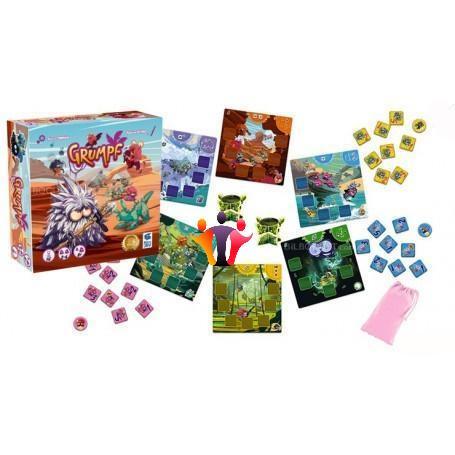
Hello everyone !
Today we're going to talk about Grumpf!
Go hunting for grumpy monsters, with 2 to 6 players, from 8 years old in 15 minutes, to complete a series and earn the most points.
Each player controls the members of a clan of Grumpfs. The players place their Grumpf pawns on the hunting boards at the same time. This is where they capture the Animals.
For each board, the players must achieve, together, a condition of success (strength, number, etc.). They must therefore cooperate, but only the strongest clans win the hunt.
The game takes place over 4 rounds, at the end of which the player who has caught the greatest number of sets of different Animals is declared the winner.
A game is made up of 4 rounds. Each round proceeds as follows:
— Place the Animals on the hunting boards.
We each place 12 animal tokens, drawn at random, on the board that corresponds to it.
—Hunting with the Grumpfs.
As soon as a player shouts “Grumpf”, we then all drop our pawns in hand onto the table in front of us.
With one hand, we return the grumps the number of times we want to find the values that interest us.
They will then be placed on the board in the order of the monsters on the free spaces on the board.
Grumpfs with clubs allow you to knock out valuable grumpfs but they will not be counted in the points at the end of the hunt.
We check whether the platform conditions are respected. We then count all the grumpfs of all the players present on the hunting board.
When a player has placed all his grumpfs or no longer wants to play a pawn, he will fold. He then places his old pawn on one of the free huts between the boards and shouts “blue grumpfs” for the blue player. He cannot be knocked out because he is lying down.
When all the Huts are occupied, this ends the round, the players immediately stop placing Grumpfs.
— End the hunt.
The players count the boards one by one, looking for each board to see if the condition is reached. To check if the condition is reached, count all the Grumpfs of all the players present on the board (except those who have been knocked out).
If the condition is not met, nothing happens. The Animals stay for the next round and the players take back their Grumpfs
If the condition is reached, the players divide the Animals starting with the strongest clan.
To determine the strength of the clans, players add up all the Grumpfs of their color on the relevant board.
The player with the highest value is first, the second second... In the event of a tie between players, it is the one with a Grumpf of his color highest on the track who wins.
The strongest players distribute the Animals among themselves following the specific rule indicated on each board. All Animals must be dealt, but not all players on the board will necessarily have them.
Once the round is resolved, the players begin the next round, and so on until the bag is empty of all Animal tokens (4 rounds).
When the last Animal token is placed on a board, the players play this last round and count down at the end of the game.
The game ends at the end of the fourth round, at the end of the turn during which the bag no longer contains Animals.
The players line up their pawns by series of different Animals, creating the longest series possible. They count the points according to the scale:
-1 grumpf: 0 points
- 2 grumpfs: 1 point
- 3 grumps: 2 points
-4 grumpfs: 4 points
-5 grumpfs: 6 points.
It is possible to do several series and accumulate their points. Please note, an Animal can only count for one series.
The player with the most victory points is declared the winner. In the event of a tie, the player with the fewest Animals is declared the winner.
Good day and good game ;)
On 21/02/2025
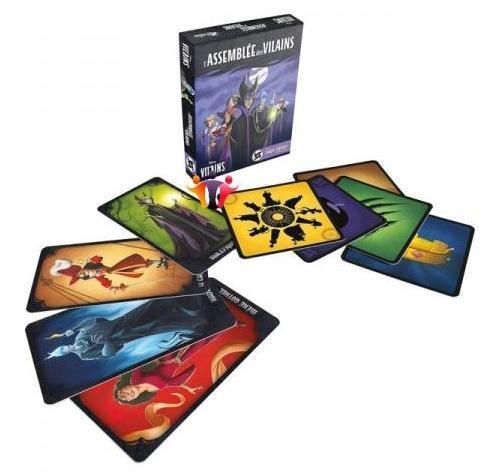
2 words game Vilain's assembly
Hello everyone !
Today we are going to talk about the assembly of villains!
The assembly of villains meets, from 6 to 12 players, from 10 years old to 30 minutes, but who will win, the loyal ones or the traitors?
Imagine a dark and devastated kingdom, ruled by misfortune and chaos, in which only the most evil and powerful villains can survive and thrive.
Face to face, with each other, they form the assembly of villains...
Now in this new kingdom, the ultimate struggle for power and control begins…
Which side will win?
The traitors who secretly want to defeat the loyal in hopes of ruling this new kingdom? Or the loyalists who want to stay in power?
The game consists of two camps, the loyal and the traitorous. The loyal must reveal and eliminate the traitors while the traitors must remain hidden and eliminate the loyal.
Each player discovers his character and the specificity he has without showing it to other players. Then they receive a secret alignment, loyal or traitorous.
During the night, traitors choose to eliminate a loyal one, while during the day they mingle among the loyal ones and can hide or sow doubt in people's minds to eliminate another loyal one.
The loyal are trying to find out who the traitors are before they are all eliminated.
The bad guys always walk around with their sidekicks who have no power except Diablo.
If they vote against their big bads and they were loyal, the sidekicks are eliminated along with their big bads.
Which of Maleficent and Diablo, Prince Jean and Persifleur, the Queen of Hearts and the King of Hearts, Mother Gothel and the Stabbington brothers, Captain Hook and Mister Fly, Hades and Pain and Panic, The Evil Queen and the Magic Mirror, Madame de Trémaine and Javotte and Anastacia will reign over the kingdom?
Without forgetting Shere Khan who has no sidekick, but who has claw marks which will leave their marks on other players and will not be without consequences.
As the light of day fades, darkness sets in and covers all the members of the assembly...
Traitors will always take advantage of the darkness to eliminate the loyal, but they are not the only troublemakers who come out at night...
But it is worth keeping one question in mind:
In a world of bad guys, who can you really trust?
Good day and good game ;)
On 14/02/2025
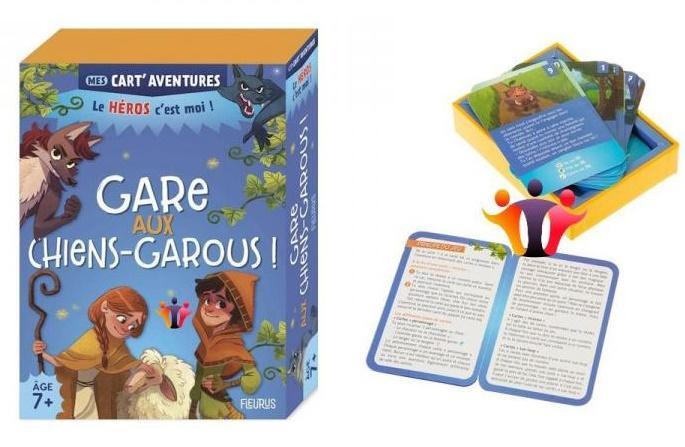
2 words game Beware of weredogs
Hello everyone !
Today we’re going to talk about Beware of Weredogs!
The adventure is waiting for you, from 1 to 2 players, from 7 years old in 20 minutes, to finish the quest!
Queen Eleanor Tador's doggies have been transformed into terrifying weredogs.
Choose your character and rush into the forest of Mordosse.
You must find wolfsbane there, plants which have the power to transform these ferocious beasts back into harmless dogs when shaken under their muzzles.
But be careful, the scent of aconite escapes once used and can only be used once.
You can be either the hunter or the huntress, the wereman or the werewoman or even the shepherd or shepherdess. Each character has their strength and weakness, it's up to you to see which one suits you best.
Let yourself be guided by following the card numbers for each mission and place the missions you have completed in front of you face up to know where you are in your adventure.
You can choose to follow the choice of the character you play or free choices that will guide you in your adventure.
The adventure is yours by following maps 1 to 44 and completing the missions. With each mission you are guided to another map for a new mission.
During your adventure, you will find wolfsbane which will be very useful to you against weredogs. So be careful not to lose them during your journey.
You win a doggie card every time you manage to transform a weredog back into a friendly doggie. They are a little distracted and you can lose them on the way.
If you have succeeded in your quest and transformed 4 weredogs back into friendly doggies, the queen will ennoble you by giving you a horse.
Will you save all the friendly doggies or will the weredogs still roam the forest of Mordosse?
Good day and good game ;)
On 07/02/2025

Hello everyone !
Today we're going to talk about Steam Park!
Let's go for the funfair, from 2 to 4 players, from 10 years old for 60 minutes, for the most attractive rides!
In the joyful town of Robobourg, a funfair takes place every year so incredible that the entire population expects only one thing: for the year to pass as quickly as possible so that these 6 wonderful days can begin again.
A game of Steam Park takes place over 6 rounds of play. Each round is divided into 4 Phases: Dice Rolling Phase, Dirt Phase, Action Phase and Income Phase.
You earn money for each Visitor present in your Park at the end of each round and for the Bonus cards you play.
Each player takes their 6 dice in hand and rolls them at the same time to each discover their results.
With each roll, you can choose to keep dice to reroll until the result does not suit you or to place them on the pig board.
When you decide to reroll, you must reroll all the dice that are not on your piggy bank.
When all players have placed all their dice on their pig board and collected a turn order tile, you can move on to the dirt phase.
For each dirt symbol present on the dice of your pig board, take 1 dirt marker from the reserve and place it near your park. This will be your trash can. Then another for each visitor present in your park.
In turn order, each player spends all the dice on their pig board to perform actions. The actions you can perform are determined by the result of your dice.
The symbols on the dice are resources that allow you to perform one or more actions. To perform an action, remove the corresponding dice from your pig board, and set them aside.
6 actions are possible: build attractions, build stands, attract visitors, clean up dirt, play bonus cards and expand your park.
Each action can only be performed once per game turn and in the order you want.
But building a sumptuous park is not enough, you also need to attract as many people as possible! This action is the most important: to win, you will have to fill up with visitors.
For each visitor drawn, see if there is an attraction in your park of the same color as him and with an unoccupied visitor space.
If so, the visitor has found the attraction they dreamed of.
If the visitor does not find the attraction that suits them, they consider your park boring and leave it without spending a single Danari.
For each visitor to your park, receive 3 Danari.
At the end of the 6th round of play, the game ends. Each player then counts the number of dirt markers in their
trash bin and determines the cost of final cleaning of its park by referring to the dirt tray.
If you have 30 dirt markers (or more), you lose all your money and also the game... that's the meaning of the little red skull at the bottom of the dirt board.
Each player then announces the amount of money they have. The richest player is declared the winner!
Good day and good game ;)
On 31/01/2025
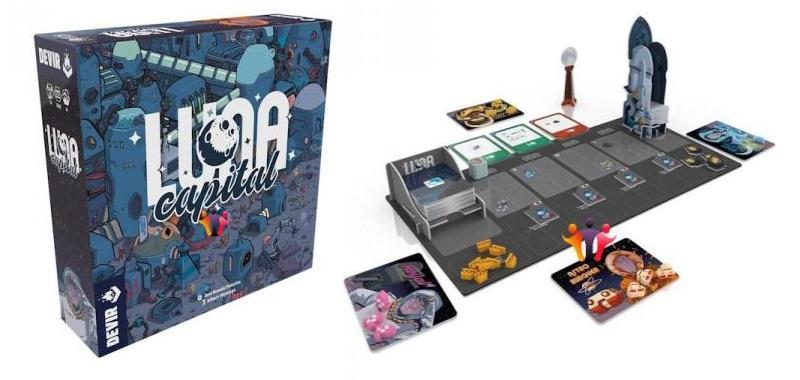
Colonization of the Moon has ceased to be a limited concept
to science fiction. Players embody different groups of settlers (engineers, scientists, ex-farmers, miners, etc.).
They will have to manage all available opportunities by building essential facilities on the most suitable land in their attempt to become the capital of the moon.
Over 12 rounds, players will have access to delivery bundles consisting of blueprints, for various structures (building cards) and one or more project options, such as resource silos, lunar greenhouses and residential modules, among others (Project tiles), which they will then place in their own play area, called “Colony”.
During the game, each player will create their own colony by building rows of Construction cards in front of them.
Each construction map shows a certain number of construction sites. By placing Project tiles on their Construction Sites, players will improve their colony and earn victory points.
To play 1 Construction card, the player must select 1 of the Construction cards from their hand and place it face up in their colony.
The placement of the card must respect these 4 conditions:
1/ It cannot be placed on another card or rotated in any way. The number on the card should be visible in the upper left corner.
2/ From the second card, each card must be placed next to and at right angles to at least one of the Construction cards placed during a previous round. At least two corners of the new card must touch two other corners of an existing card.
3/ There can be a maximum of 3 rows of cards in each player's colony. The length of each line has no limit and can be of different length.
4/ The Construction cards are numbered from 1 to 10. In each row, the numbers on the cards must increase from left to right and no number can be repeated in the row.
If the player has no card that meets this condition in his hand, he must place the new card face down (while meeting conditions 1, 2, and 3).
Since the number will not be visible, it will not be taken into account. Also, the player will not be able to place Project tiles on this card.
After placing his card, the player must place all the Project tiles he has taken this turn. Project tiles can be played on top of any of the empty construction sites in their colony.
The player is not required to place them on the map that was just added to their colony. Each tile must be placed on a Construction Site that is completely empty, without any Project tiles or buildings of any type.
At the end of each Phase, before players begin the next turn, each player checks to see if they have fulfilled the requirements for any of the exposed concessions that are still available.
Each player who has fulfilled the conditions for one or more Concession locations places an identification token on top.
At the end of the twelfth round, the score is calculated and the Lunar Colonization Authority will choose the one who did the best job as the satellite capital preferred by nine out of ten inhabitants of Earth.
Good day and good game ;)
On 24/01/2025
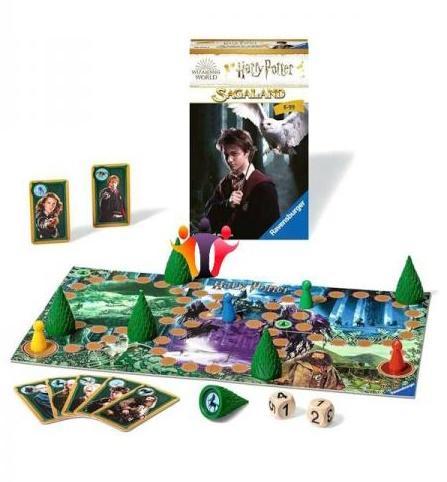
2 words game Sagaland Harry Potter
Hello everyone !
Today we are going to talk about Sagaland Harry Potter!
Hogwarts Wizards enter the Forbidden Forest, for 2 to 4 players, from 6 years old in 25 minutes, to find the magical animals!
Some magical animals have hidden in the Forbidden Forest. Do you sense their magical auras and will you venture into the Forbidden Forest to save them?
Go in search of magical animals in the heart of the Forbidden Forest of Hogwarts Castle to help Harry, Hermione, Ron, Draco, Hagrid and Voldemort.
We each draw an animal card which we place next to ourselves, then we roll the two dice.
From Hagrid's house, we advance on the plateau to observe under the fir trees if an animal corresponds to the magical animal we are looking for.
You can choose to move forward together with the dice or move forward and backward with each die separately.
To declare that we have found our magical animal, we must go to Hagrid's house on the key and then announce the animal found and the tree under which it is located.
If you cannot find the tree corresponding to the hidden magical animal, then you must return to the village without discovering a tree on the way and start from scratch at Hagrid's house.
If we find the corresponding animal under the tree we win the magic animal card and we then turn it face down.
You can then draw another animal card which you will place next to you and which you will have to find.
If there are no more animal cards to find, you can try to find the animals placed next to the other players.
The player who arrives on the magic square can leave there on their next turn. If a player rolls a double on the dice, he can either swap two trees, move to a tree card of his choice and look at it, or shuffle the pile of cards and then turn one over.
The player who has the most magic animal cards wins the game.
Good day and good game ;)
On 17/01/2025
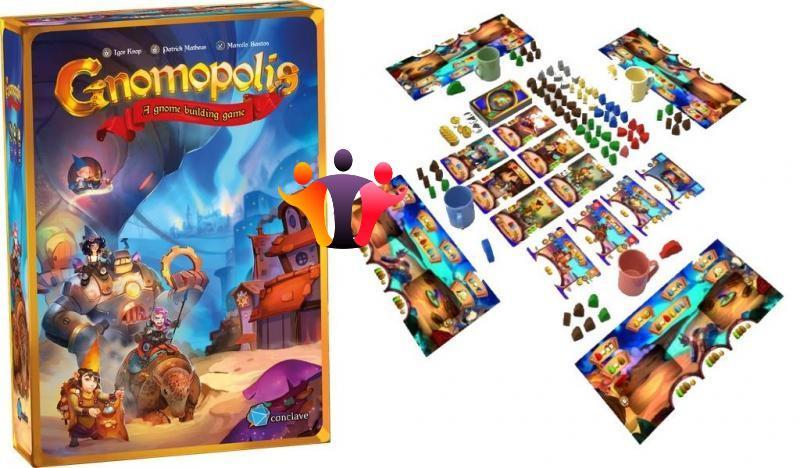
Hello everyone !
Today we are going to talk about Gnomopolis!
Hunted by humans, it's up to you brave gnomes to explore the surroundings, from 1 to 4 players, from 14 years old in 45 minutes, to find a new place for your city of Gnomopolis!
In Gnomopolis, each player seeks a thriving future for their districts, constructing buildings, collecting coins, and creating jobs for their gnomes.
Each building provides actions for gnomes and requires professions. Match gnomes to building requests and collect coins to earn victory points.
In Gnomopolis, players take turns playing, clockwise, starting from the player who started, until one of three victory conditions is met.
The game continues until all players have played the same number of rounds. Players count victory points. The player with the most victory points is declared the winner.
On each player's turn, he can take actions with all his active gnomes (in the zone) until he wants to pass. At the end of the turn, he places all his gnomes in the zone of exhausted gnomes (zone) and draws a new labor force of 3 gnomes for his next turn.
Then the next player begins their turn. Each player can do one of the following actions on their turn:
1) Move a group of gnomes from its zone of active gnomes to an empty scroll on a Building Card, a District Board or an Advisors Card to complete the action completely and immediately (you can do as many actions as you like). want to, but one must be completely concluded before the other begins).
2) Place a group of gnomes on a Building Card in the building pool to build it in your district (only once per turn).
3) Pass (to end your turn).
The end of the game occurs either if a player has built his sixth building, the old capital no longer has gnomes or the old capital no longer has coins.
To calculate the final score, each player distributes all of their gnomes to each building they have built and on their District Board.
The colors required by the buildings must be respected (at the bottom of the cards) and each gnome can count points in a single building.
The final score of each player is defined by the sum of:
+1 Victory Point for each coin;
+2 Victory Points for each gnome who satisfies the request of each Building Card in his district;
+1 Victory Points for each gnome who meets the request of the District Board; +2 Victory Points for each Advisor Card;
-1 Victory Point for each gnome that is not requested by a Building Card or District Board.
The player with the greatest amount of Victory Points declares himself the winner.
Gnomes are agile beings and organize themselves into different groups based on the color of their hats. There are six colors of gnome tokens in the game: children are green, villagers are brown, soldiers are red, merchants are yellow, artisans are blue, and inventors are gray. The white gnome pawn represents anything: it could be a child, a villager, or a specialist gnome.
Through their actions, children become villagers and villagers specialize in four professions: soldiers, merchants, artisans and inventors!
Whoever has the most victory points at the end of the game will be the winner!
You can play single-player games of Gnomopolis with the basic rules for two players. In this case, you will try to maximize your score before triggering the final victory conditions.
Good day and good game ;)
On 10/01/2025
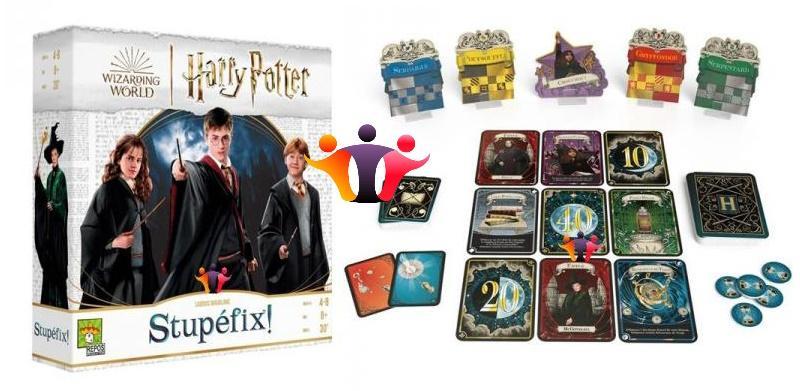
Gryffindor, Hufflepuff, Ravenclaw or Slytherin, proudly wear the colors of your House and live up to its reputation.
In each of the 8 rounds, prepare a Spell and point your wand at one of your opponents.
Then, all at the same time, cast your Spell… or protect yourself! Because if you are stunned, you risk losing points to your House.
Only the wisest wizards will be able to share the Rewards of the round and thus earn points for their House.
A game takes place over 8 rounds, each divided into 7 phases. The Chouchou announces and directs the phases of play, one after the other. The back of the Chouchou tile presents a game aid recalling these different phases.
Draw 8 Reward cards and place them, face up, in the center of the table, next to the Become the Pet card. The latter constitutes the 9th Reward, available in each round.
All at the same time, secretly choose a Stupefy or Failed Spell card from your Spell cards and place it face down in front of you.
When everyone has prepared their Spell card, the Chouchou announces “Witches, Wizards... take your wands!” ”, then count to three.
In threes, all at the same time, point your wand at one of your opponents. If you don't point to anyone at "three", it's too late.
You will therefore not target anyone during this round.
Important: For safety reasons, always aim at your opponent's chest and never at their face.
Pay close attention to the wands pointed at you and your opponents. After a few seconds of observation, the Chouchou counts to three again.
Three people, all at the same time, cast the Spell you prepared in phase 2 or the Protego Spell.
• Stupefy: Shout “Stupefy!” » and keep your wand pointed at your opponent.
• Failed Spell: Say nothing and lower your wand.
• Protego: You can always choose to protect yourself by casting a Protego Spell in place of any prepared card.
Hold your wand in front of your face and shout “Protego!” ". So you no longer target anyone.
If you have cast a Protego Spell: you are protected. Lay down your Flag and ignore all Spells that target you. Then discard your Spell card face down.
Otherwise, if you are targeted by one or more Stupefy Spells:
you are stunned. Lay down your Flag and take 1 Delay token per Stupefy Spell that targets you. Then discard your Spell card, face up.
Only players whose Flag is still standing can participate in the Sharing of Rewards.
If your Flag is still standing, starting with the Pet then clockwise, take a Reward of your choice from the revealed cards. Continue taking Rewards, in turn order, until there are no more in the center of the table.
When all 9 Rewards have been taken, the round ends.
• Keep the Successful Potion and Favor cards face down in front of you.
• Discard the Private Lessons and Time Turner cards.
• Return the Become the Chouchou card to the center of the table.
• Announce out loud the total value of the Points cards that your House
won during this Share. Then place them in the Urn in your House.
Important: Only Point cards are pooled in your House Urn. All other Reward cards are individual.
Straighten all the Flags, and then return to phase 1 Reveal the Rewards to start a new round.
The game ends after 8 rounds, when all the Prize cards have been taken.
The House with the highest score wins the game.
In the event of a tie, the Houses concerned share the victory.
Good day and good game ;)
On 03/01/2025
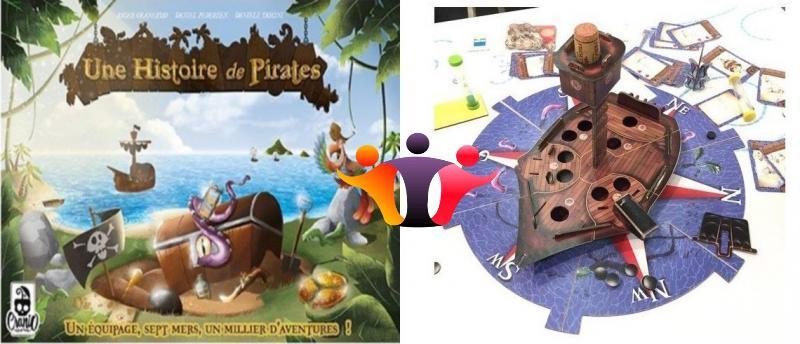
Hello everyone !
Today we are going to talk about pirate history!
Hear sailors, don't be afraid, 2 to 4 players, from 10 years old in 30 minutes, to solve the most dangerous adventures!
More info: https://www.jouelejeuvaison.com/blog
Good day and good game ;)
Put on your captain's hat and navigate the 3D pirate ship using hourglasses in this unique real-time cooperative game.
As a member of an adventurous pirate crew, your goal is to be crowned Admiral of the Black, the most feared pirate ship in the Caribbean.
To earn this title, you must complete dangerous scenarios in the shortest time possible. The most innovative element of the game is that the player uses their own 30-second hourglass as a character to place on the ship to perform actions.
Each time a player places their own hourglass, they must wait until the sand runs out before they can perform the necessary action.
Each hole on the ship represents an area where you can perform a specific action: turn the ship, load cannons, shoot enemy ships, repair damage, etc.
A Tales of pirates features ten different scenarios, ranging from ordinary hacking activities like watching and shooting, to kraken hunting, prison escapes, treasure hunts and much more.
A smartphone and/or tablet app will guide players through missions, assisting with scenario data, random events, multi-pathing, upgrades, and saving game state for later sessions .
It also serves as a timer for the individual round, as the typical scenario lasts 2-3 rounds, each lasting five minutes.
Players must react to events and maneuver the ship to combat enemy gunboats, catch rich merchant ships, and avoid other obstacles. They need to communicate to agree and organize things to do, but they need to be quick because time is always running out.
A tales of pirates is a fast-paced game with simple rules, but it's exciting and involving, with great player interactions.
Unlike some other real-time cooperative games, stress is present but not dominant. The thirty-second delays, in addition to the intermittent spins, always allow you to catch your breath!
Good day and good game ;)
On 27/12/2024
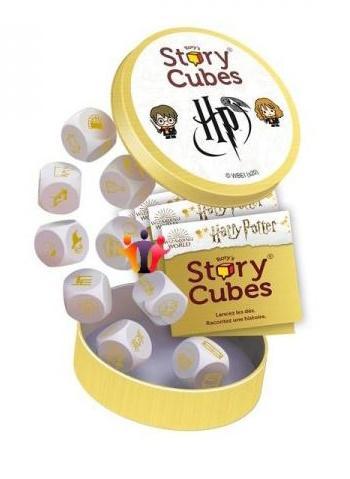
2 words game story cubes Harry Potter
Hello everyone !
Today we are going to talk about Story Cubes Harry Potter!
Little or big wizards, from 1 player, from 6 years old in 10 minutes, to create beautiful stories at Hogwarts!
In Story Cubes Harry Potter, roll the 9 dice to create ever more magical stories!
Whether you create a story alone or with others, let yourself be carried away by the dice combos to create stories, each one more magical than the last.
You can choose to either take turns being a storyteller by taking the 9 dice and telling your story to the other players, then decide which storyteller wins the round.
But you can also choose to each take a part of the dice and tell the story together with one player creating the beginning, another the middle, then the end.
Push the limits of your imagination by creating numerous stories about your Harry Potter objects and characters.
Board the Hogwarts Express and tell the story of your adventures in the heart of the Forbidden Forest, the castle or even the grounds of Qwidicth...
Fans of the famous wizard with round glasses will be able to create and invent endless stories based on the theme of their favorite saga!
Roll the dice and create stories full of twists and turns by including symbols from the enchanted and wonderful world of Hogwarts.
Your story can be serious or completely crazy, short or full of magical adventures...
There are as many story creation possibilities as there are possible dice combinations to share the magic of Hogwarts even longer...
There’s magic in the air, so here’s to your stories!
You can also add your dice from other story cubes that you may already have to create ever more varied and longer or shorter stories!
It’s up to you to create stories, each more original than the last…
Good day and good game ;)
On 20/12/2024
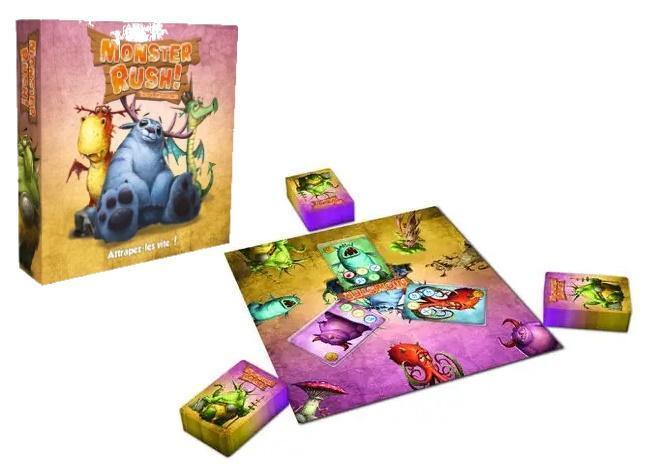
Hello everyone !
Today we're going to talk about Monster Rush!
Bounty hunters, from 2 to 8 players from 8 years old in 10 minutes, to collect as many little monsters as possible!
In Monster Rush, the king calls on you to chase adorable little monsters from the kingdom, as they hypnotize the villagers.
Capture these adorable monsters and the King will reward you as you deserve. But be careful, each monster requires a special combination of weapons and spells to capture. Speed will be your best ally. Who will be the fastest ?
A monster can be captured when the Weapon and Spell cards revealed by the players match the symbols on the Monster card.
Place the board in the center of the table between the players. Shuffle the Monster cards then distribute them into three equal piles, face down, around the board. Then return the first card of each pile to the dedicated space on the board.
Shuffle the Weapon and Spell cards and divide them into as many piles as there are players. No need to count: it is not necessary that everyone has the same number of cards. Each player receives a pile which they keep face down in front of them.
Taking turns, going clockwise, players turn over the top card of their Weapons and Spells pile and place it in front of them. Once a complete turn has been made, players turn over another card, one after the other, and place it next to the first. It is especially important not to stack the cards: they must all remain visible to all players.
The game continues like this until a monster is captured. When all symbols on a Monster card have been revealed using Weapon and Spell cards (regardless of who), players must immediately place their hand on the monster to capture it.
The fastest player wins the card and places it next to them, face up. At the end of the game, players will have to add up the values indicated at the top left of the Monster cards they have collected.
If a player makes a mistake and touches a Monster card without all the symbols having been revealed, he recovers the card concerned but places it next to him face down. It will count as a negative point (-1) at the end of the game.
When a Monster card is collected by a player (because they captured the monster or because they made a mistake), draw a new Monster card from the corresponding pile and place it on the face-up space on the board. visible. In addition, each player returns their Weapon and Spell cards to the bottom of their pile, face down. The player who captured the monster starts the new turn and the game continues.
When several players try to catch different monsters, only the fastest player wins their card. If it is not possible to decide between them, look at the number at the bottom left of each card: the advantage is given to the player who touched the card with the highest value.
Whether the player made a mistake or not is irrelevant. We take into account the capture attempt on the highest value card and then check if the player made a mistake.
If several players try to catch the same monster, the fastest one wins, that is to say the one whose hand is below the others. In case of doubt (for example if the hands do not touch), the player whose hand covers the largest area of the card wins.
The game ends when the last monster in one of the three piles is captured. Each player then adds the points of their face-up Monster cards and subtracts one point per face-down Monster card. The player with the most points wins the game.
In the event of a tie, the player who captured the most monsters at 5 points wins. If the tie persists, do the same with the monsters at 4 points, then at 3 points. In the (rare) case that tied players have captured exactly the same type of monsters, they share the victory.
The player who scores the most points thanks to the monsters he has captured will be declared the winner!
Good day and good game ;)
On 13/12/2024
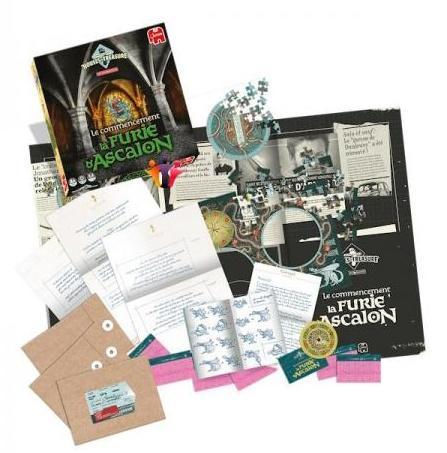
2 words game The fury of ascalon
Hello everyone !
Today we're going to talk about The Fury of Ascalon!
It's up to you to escape the maze, from 1 to 4 players aged 16 and over for 90 to 120 minutes, by finding the answer to the quest!
More info: https://www.jouelejeuvaison.com/blog
Good day and good game ;)
In Ascalon's Fury, the goal is to find the exit from a maze.
The quest consists of a puzzle and six puzzles placed in three envelopes which must be opened one after the other starting with envelope 1.
The solution to each puzzle relates to the correct position and location for each of the three rotating pieces and a clue to the shield you will need at the end to secure your exit from the maze.
Start by assembling the puzzle on the rectangular shape of the poster. Read it and analyze the notebook.
When the puzzle is completed, you can open envelope 1 and read the first riddle carefully.
When the puzzle and riddles are solved, fold the poster once over the puzzle and carefully turn it over to check the back of the complete puzzle.
Open the poster and hold the red filter near the back of the puzzle to check if the position of the small puzzles is correct.
For each puzzle, there are two clue cards. You can use them however you want. Use the red filter provided to read the contents.
Start by opening the “A” card if you need a little help.
Use card “B” to guide you to the solution.
The clue cards do not contain the answers; they simply guide you in the right direction.
Good day and good game ;)
You will find the complete answers in the PDF below.
On 06/12/2024
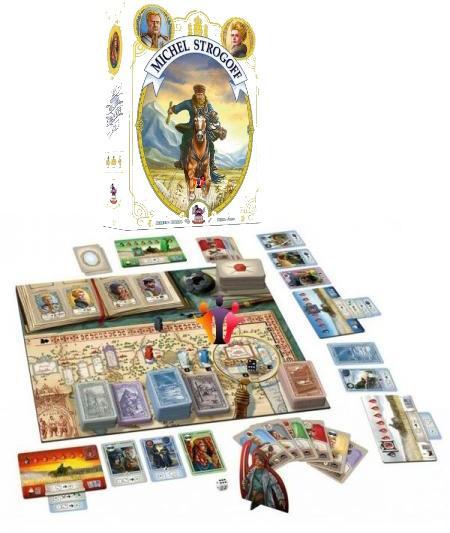
Hello everyone !
Today we are going to talk about Michel Strogoff!
In Michel Strogoff, succeed in transmitting the Tsar's mail, from 1 to 4 players of 45 minutes from 12 years old, to prevent the fall of Irkutsk!
Russia, late 19th century. Colonel Ivan Ogareff, a traitor to his homeland, allied himself with the Tartars to invade the empire.
The Tsar asked his bravest couriers to go as quickly as possible to Irkutsk in order to warn his brother, the Grand Duke, of the danger which is about to sweep over him...
The cards are the main element of the game and represent all the different aspects of the novel: the dangers of the journey, the allies you will meet, the experience you will gain, and even the movements of the traitor Ivan Ogareff.
The game plays in quick rounds. Each player takes their entire turn, then the next player takes their entire turn clockwise.
When all the players have taken their turn, it is up to the villain of the story, Ivan Ogareff, to take action; he is represented in the game by the cardboard Traitor figurine which is always placed to the right of the first player.
The process is repeated until one player achieves victory by reaching the 11th space of the journey, Irkutsk, and defeating the traitor; or until Ivan Ogareff successfully invades Russia, defeating all players or entering Moscow with the Tartars.
Each complete round consists of the couriers phase and the traitor phase.
During the couriers phase, the player after asking (or not) for help from an ally, can choose either to advance, to rest or to face dangers.
Once all players have completed the Couriers Phase, Ivan Ogareff is then activated.
During this phase, Ogareff advances, the Tartars move, and other effects occur, such as the arrival or departure of allies who help the players, or the activation of abilities.
During the game, certain characters will move in and out of the story setting, potentially helping players with their special abilities.
At the start of his turn, a player can, if he wishes, discard an Action card from his hand (or two cards for Captain Strogoff) and activate the ability of an ally.
Only an Action card showing the portrait of one of the allies present on the board can be discarded to activate this character's ability.
If Ivan Ogareff reaches the end of his journey, place his pawn on the Irkutsk space.
From this moment on, when a Traitor Phase begins, no Action cards are drawn. Instead, roll the action die and the players activate their abilities based on the result of the die, then the Tartars advance towards Moscow the number of squares indicated by the action die.
If they enter the capital, their invasion of Russia succeeds and the players lose the game.
During his turn, if a player advances and enters square 11 of the course, Irkutsk, he does not draw a Road card, but instead begins the final duel with Ogareff which will end in victory or death!
After having eliminated all his Road cards, and if he has not lost all his energy, the player must now face Ivan Ogareff.
One by one, he must draw and then overcome as many Irkutsk Road cards as indicated by the zone in which the Ivan Ogareff pawn is located (from 3 to 5 cards).
For each card drawn, an Action card must be played from the player's hand with a corresponding icon, or lose 1 energy point. Then we move on to the next card if the player's Energy token has not reached zero.
If a player reaches zero energy, regardless of the situation, they die and are eliminated from the game.
The Irkutsk cards that were part of the confrontation are discarded (the other players can memorize the cards; knowing that they will not have to face them can help them).
The rest of the players continue to play normally. If the Irkutsk draw pile becomes exhausted, reshuffle the discarded cards.
If, after facing all the required Irkutsk cards, you have at least one energy point left, you have successfully defeated the traitor!
Good day and good game ;)
On 29/11/2024
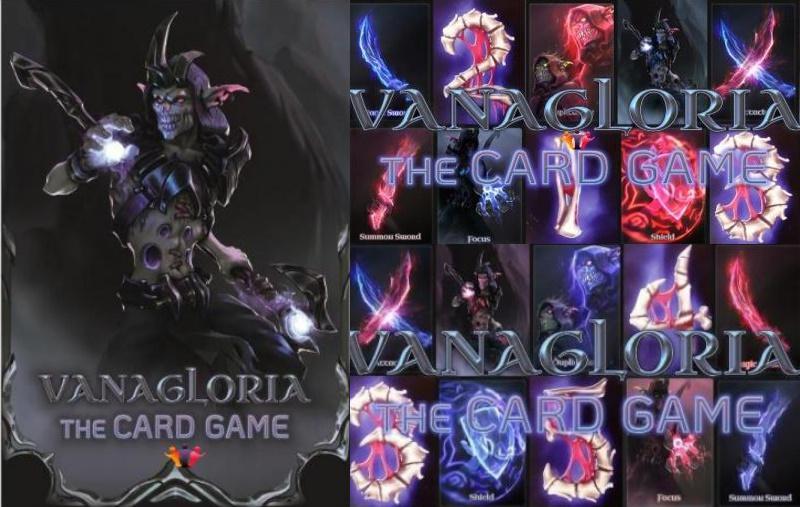
Hello everyone !
Today we are going to talk about Vanagloria!
In Vanagloria, collect all the energy points from the source, with 2 players and more than 30 to 40 minutes from 14 years old, to become the master of Vanagloria!
There was a time when Vanagloria was an enchanted world where entities lived in peace and harmony. Unfortunately, those days are over.
Now Vanagloria is bewitched and corrupted by dark sorcerers seeking to conquer the world at the expense of life itself.
For years, these masters of black magic have fought to capture the source of energy.
The first to possess it will crush their enemies with the back of their hand.
The cards represent the game's shadow wizards and the values 0.50 and 100, the three levels of wizard energy concentration.
We will increase by 50 with each concentration of energy and we will lose 50 with each attack from our opponent.
The five different types of action cards allow you to:
- duplicate your wizard to introduce another wizard into the battle,
- to concentrate energy by 50 and up to 100 each time,
- to summon a magic sword which will allow you to attack your opponent,
- attack cards which allow you to attack your opponent after summoning a magic sword,
- to protect yourself with a shield.
Magic sword cards allow wizards who are equipped with them to attack an enemy wizard, inflicting 50 energy concentration damage if they did not have a shield to protect their attacked wizard.
We randomly mix 5 point cards per player to create the “general objectives” deck, then place them in the center of the playing area.
We place in front of each player a “personal objectives” deck which will contain 5 random cards from the remaining point cards.
We designate the first player at the start of the game and then play in a clockwise direction. At the end of each turn, the player to the left of the first player becomes the first player.
Each player starts the game with a wizard card at level 0 (turn the card so that the 0 is at the top).
At the start of each turn, the card from the “General Objectives” deck is revealed. If this is exhausted, the first card of each “personal objectives” deck is revealed.
Then all players must add two action cards face down to all their wizards at the same time.
Once all the cards have been added, each player will take turns revealing an action card linked to a wizard of their choice and carrying out its effect before letting the next player play.
As soon as a player has shown his last action card, the round ends when the other players have also revealed the same number of cards as the first player. Which means that if a player only has one wizard in play, the other players will only be able to use two action cards even if they still had 2 or 3 wizards.
At the end of the round, the player who has the most wizards at level 100 takes the card from the “general objectives” deck which was revealed at the start of the round. In the event of a tie, or if no player has a level 100 wizard, the card from the “personal objectives” deck is discarded.
After that, all level 100 wizards go back to 0 and all players take back their used action cards and a new round begins.
When all objective decks are exhausted, the game is over. The player who obtained the most points with the sum of the point cards from each round wins. In the event of a tie between two or more players, additional rounds will be played between them by shuffling all the objective cards. The first person to obtain an objective card wins the game.Good day and good game ;)
On 22/11/2024
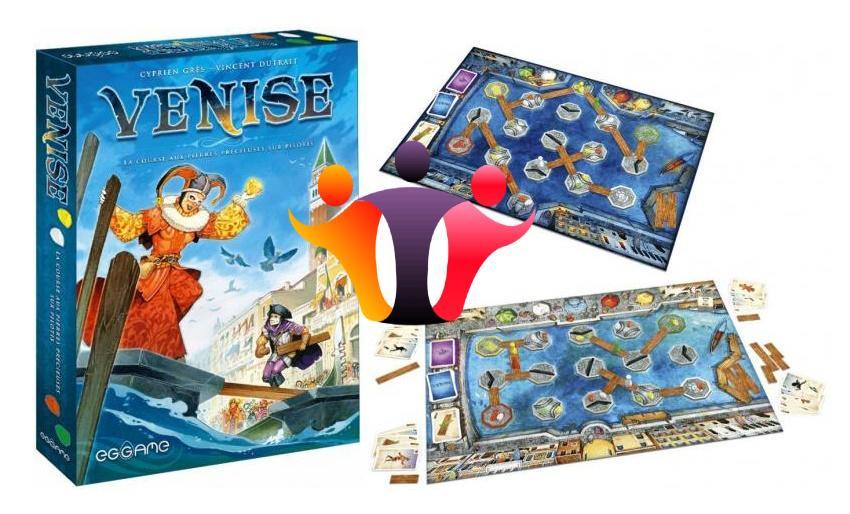
Hello everyone !
Today we are going to talk about Venice!
In Venice, ride on stilts, for 2 to 4 players for 45 minutes from 10 years old, to collect all the precious stones!
More info: https://www.jouelejeuvaison.com/blog
Good day and good game ;)
In Venice, we go in search of precious stones in the heart of the city before the other players by going from piling to piling.
To reach the gems you have to find the best path in this maze.
To do this, you play cards. They allow you to place, remove, move boards and also move forward 1, 2 or 3 steps.
You can take advantage of the boards placed by your opponents to go faster. You will have to keep an eye on them, they could remove boards from under your nose.
When you arrive at the square where one of your stones is located, take it and place it on your tent, then continue your turn.
Play cards within the limit of 4 hourglasses or take a joker card. Then draw 2 cards.
If you have more than 8 cards in hand, discard the ones of your choice. Place them on the location as well as the cards played face up.
When there are no more cards in the draw pile, shuffle those already played to form a new one.
When you collect one of your precious stones, you gain an hourglass tile. It can be played immediately or during a next turn, it can be combined.
On the turn where you use hourglass tiles, you can play cards up to the limit of 4 hourglasses + 1 per tile.
During your turn, you can also exchange 4 cards of your choice for a joker that you can play immediately.
This is particularly useful when you need a specific card or when you end your turn with more than 8 cards.
Moving from one plank to another plank counts as a step, just like moving from one plank to a stilt or vice versa.
ē
Several pawns can cross paths and be on the same board or the same stilt.
Place a joker, it replaces any card, at your convenience. You cannot have more than 2 jokers in your hand. Once played, return it to the joker pile.
The board has a second side which allows you to play in the heart of Venice at night and offers two additional stilts to open new paths.
Good day and good game ;)
On 15/11/2024
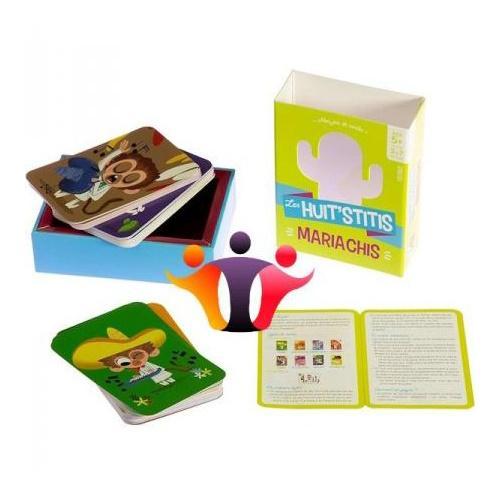
2 words game Huistitis mariachis
Hello everyone !
Today we are going to talk about the Huitstitis Mariachis!
In Huit’stitis Mariachis, it’s going to be swinging, from 3 to 7 players for 15 minutes from 5 years old, to bring together the mariachi group!
You have to bring together eight mariachi marmosets, each playing a different instrument.
The first group thus formed will be able to tour the world and escape the hunters!
A master of the game is appointed. His role will be to draw the cards and arbitrate between the players in case of doubt.
If the game master cannot find out who won a card, he places it back at random in the pile.
It is not possible to play and be master of the game in the same game. If there are only two players, an adult can be asked to play this role.
Between 2 and 3 players, 4 marmosets are removed from each instrument. These cards are put aside for the entire game.
The game master draws the cards and presents them one after the other to the players.
If it is a “musician” card: the first player to imitate the musician on the card while saying the name of his instrument wins it. He then places the card in front of him, face up.
A player can win the same “musician” card several times, he then places it on similar cards in his game. This can allow him to block his opponents!
If it is a hunter card: the first player to make marmoset cries while scratching his head wins the card.
He can then choose a card of his choice from the game of one of his opponents.
The hunter card drawn is then put aside for the entire game.
The game ends when a player has collected eight different mariachi marmosets: one for each instrument.
Good day and good game ;)
On 08/11/2024
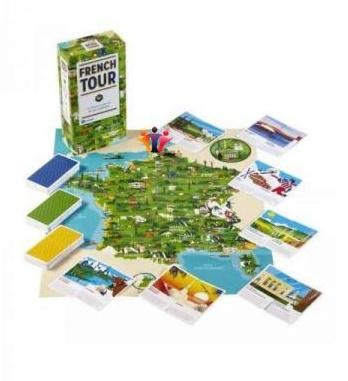
Hello everyone !
Today we are going to talk about French Tour!
In French Tour, let's explore France, from 2 to 6 players for 20 minutes from 7 years old, and win the most cards!
In French Tour we will try to find where the places are located using clues from objective maps.
We separate the piles of face-down cards into three piles, yellow, green and blue, then we choose one of the piles.
The cards are then distributed among the players. Each player then looks to see if they have pairs composing a panorama of a monument or known place in France.
They then remove the pairs and place them face up in front of them on the table.
The player to the dealer's right then presents his face-down deck of cards to his neighbor, who takes one at random.
If the new card drawn allows you to compose a new pair, you also place it face up in front of you on the table.
All players proceed in the same way until only the “intruder” card remains, the sand rose.
Players then count 1 point per pair won. Then they keep the won pairs face up in front of them.
We then place the map of France in the center of the table and then challenge the other players to find on the map the places indicated on their pairs of cards.
The challenged player must find on the map of France in 20 seconds where the place concerned by these maps is located.
If the player succeeds, he gains an additional point. If he makes a mistake, he gives his pair of cards to the player who challenged him.
The game ends when all players have played their pairs.
The player with the most points at the end of both phases of play wins the game.
Good day and good game ;)
On 01/11/2024
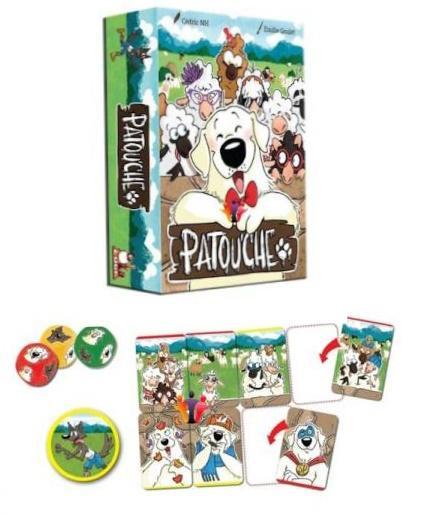
Hello everyone !
Today we are going to talk about Patouche!
In Patouche, be the best shepherd, from 3 to 5 players for 15 minutes from 7 years old, but watch out for the wolf who prowls!
More info: https://www.jouelejeuvaison.com/blog
Good day and good game ;)
In Patou'che, each player plays a shepherd who dreams of having the largest flock of sheep.
But watch out for the wolf on the prowl!
He also likes sheep, and as they are afraid of him, they run away! To prevent their sheep from getting lost in the mountains, players can count on their faithful shepherd dogs: the patous.
At the start of the game, we sort the Sheep cards and the Patou cards into 2 separate piles, yellow border face up; then we place them in the center of the table.
A player receives the 3 dice and places the Wolf token on the yellow side in front of him. This player can roll the dice up to 3 times. He is obliged to keep at least 1 die after each throw.
A saved die cannot be re-rolled. Once the result of the dice suits the player, or after 3 rolls maximum, the action of each die is applied.
Then comes the next player's turn in clockwise order.
On the wolf side of the die, it moves one player to the left. This player discards as many Sheep cards not protected by a Patou card as the number of Wolves on the dice.
The cards thus discarded are put back under the deck of Sheep cards.
On the Patou side, the player takes as many Patou cards as the number of Patous visible on the dice and places them in front of him, either below a Sheep card already present, or next to another Patou card. there are no Sheep cards to protect.
If the deck of Patou cards is empty, they are taken from one of the players who has the most.
On the sheep side, the player takes as many Sheep cards as the number of Sheep visible on the dice, and places them in front of him, either above a Patou card already present to be protected, or next to the other Sheep cards already present in front of the player.
The cards are added to the right in the continuity of the fresco: the Sheep at the top, the Patous below.
As soon as a player has 6 Sheep cards, each of the other players plays again one last time.
The player with the most Sheep cards is declared the winner.
A variant allows more developed games with Patous effects and more possible dice rules, but also cooperative games!
Good day and good game ;)
On 25/10/2024
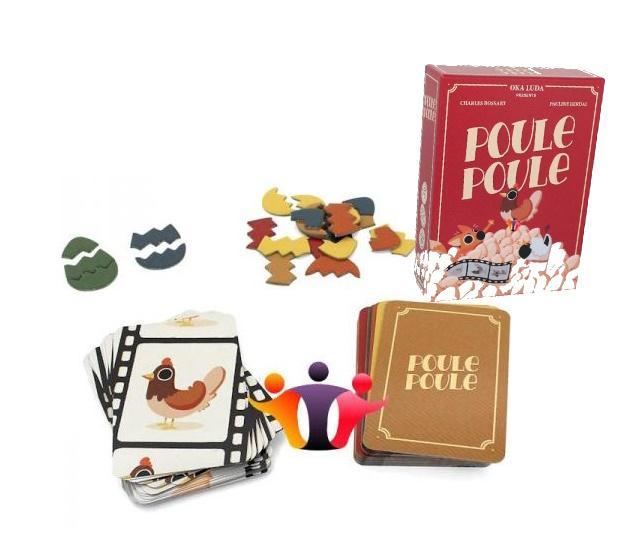
Hello everyone !
Today we’re going to talk about Poule Poule!
In Poule Poule, be the fastest and observant, with 2 to 8 players for 20 minutes from 8 years old, and replenish the egg to earn points!
More info: https://www.jouelejeuvaison.com/blog
Good day and good game ;)
It's the Cannes Film Festival and the premiere of the film Poule Poule is turning into drama.
In fact, a little less than an hour before the screening, that clumsy Waf mixed up all the films!
To help Cocotte, who doesn't have a minute to lose, and to prevent Crack from breaking down for good, we must reconstruct the film as quickly as possible!
And don't forget, the story ends with the fifth egg!
A player will stack the cards, one by one, on top of each other in the center of the table. Once placed, these cards will compose the Film. Meanwhile, the other players will just have to count the eggs!
When an egg arrives in the film, it is an available egg. When a hen arrives in the film, she incubates the egg and it is no longer available. Only a fox chases away the hen and makes the egg available again.
The fastest player to tap the film, as soon as it has at least 5 eggs available, scores 1 point
(a point is represented by a section of colored egg). And here we go for a new round!
The first player to reach 3 points - who has pieced together a complete colored egg - wins the game.
When a player taps on the film, the others can choose not to question his word, and tap above his hand, or not tap, to contradict him.
In the latter case, only, we look at the slow motion. We collect the film pile - taking care not to mix any cards - we turn it over, then, card by card, starting with the one on top (the first card played in the round), replay the film again in slow motion ...
We can then add other characters like:
- Roger the farmer, who collects all the eggs laid in the film and leaves.
- Waf the dog, chases away the foxes and the chickens can continue to brood. He then leaves with the fox.
- Grrr the fox disguised as a chicken, who scares away the chickens without being chased away by Waf the dog.
- Quack the duck, which makes the player say “Quack” as soon as he passes and “Quack quack” to the second player. Players who do not say “coin” can have a pledge.
- Tigerworm the earthworm, which attracts the hen and makes it leave a hatched egg.
- Double the ostrich egg, which counts as 2 eggs and which the hen cannot hatch, but which the farmer can collect.
- Rico coco the rooster, which ends the game and the players must announce the number of available eggs present in the packet.
When a player reaches 3 points, he wins the game. If several players reach 3 points at the same time, they do one last round between them.
The first to be the only one to score a point is the winner.
Good day and good game ;)
On 18/10/2024
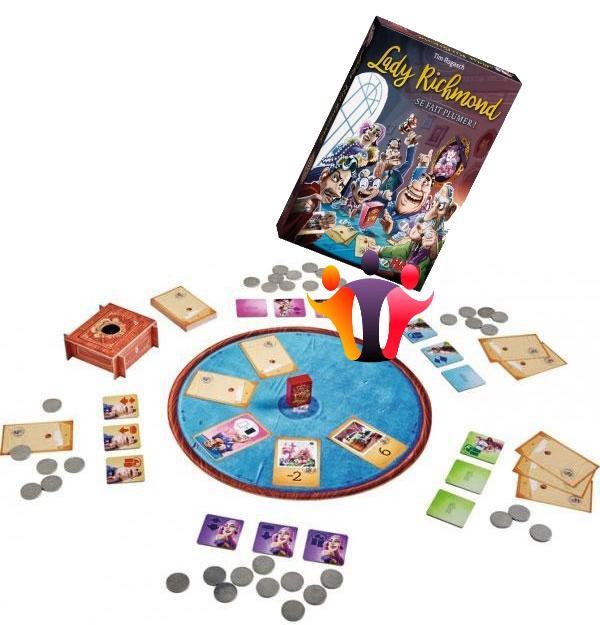
2 words game Lady Richmond getting fleeced
Hello everyone !
Today we're going to talk about Lady Richmond getting fleeced!
In Lady Richmond Gets Plucked, be the most cunning, 2 to 5 players for 20 to 30 minutes from 8 years old, and recover Lady Richmond's legacy!
More info: https://www.jouelejeuvaison.com/blog
Good day and good game ;)
Tension is at its height in the Wetherby auction house. Lady Richmond suddenly died in the arms of her young lover, Jacques Monétaire.
During a hectic auction, the heirs try to acquire the best lots of the estate and leave the uninteresting items to their rivals.
To achieve this, there is no fair play: they cheat, they swap lots, and they even borrow money from another heir.
Whoever manages to navigate these hectic auctions, by betting their money intelligently, will ultimately succeed in securing the most beautiful pieces and emerge victorious from these tumultuous and crazy auctions.
Each player chooses a character and places the 3 scam tiles in their image (cheating, exchange, borrowing) face up in front of them. Each player also receives 10 coins for their personal supply.
A player turns over a card of their choice on the game board so that everyone can see it clearly.
Each time a card is turned over on the game board, each player can choose to open a bid.
To do this, he must seize the auction block. All face up cards are included in the offer.
If no one wants to make a bid, we continue until a player makes a bid
To make a bid, you collect the auction tile first. We make a first offer with the number of corresponding pieces.
Each player can then outbid or pass. If no player wants to bid again, the auction ends and the one who made the best offer wins the lot and places the cards face down in front of him. The other players collect their pieces.
The auctioneer may order:
- pauses, we then move on to the next player,
-change the cards face up to remove them and put them in the discard pile,
-payday, all players receive the missing number of coins to reach 10. If a player has more than 10 coins, he must return the excess.
-liquidation, all face up and face down cards are part of the auction. If no one takes it, the next card placed ends the auction.
The heirs can with the action tiles:
- cheat: you secretly look at two cards of your choice one after the other among those that are face down on the game board. Then put them back face down.
- exchange: this tile allows you to exchange one of the cards already acquired at auction for a card from the game board.
The game ends when all cards have been auctioned or placed in the discard pile and when the draw pile is empty.
Now count the points of your item cards by subtracting the negative points. The player with the most points wins the largest share of Lady Richmond's inheritance.
In the event of a tie, the player with the most items in a single category (e.g. largest collection of stuffed animals) will be declared the winner.
Good day and good game ;)
On 11/10/2024
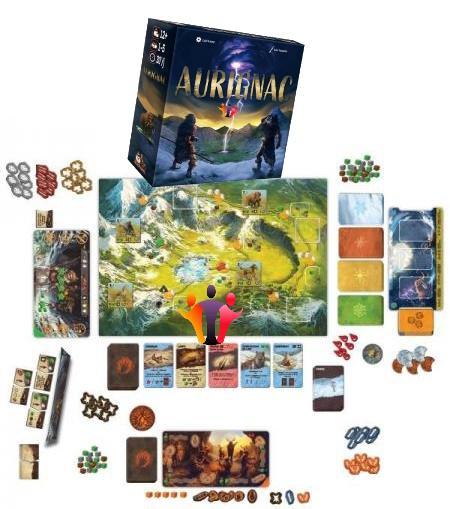
Hello everyone !
Today we are going to talk about Aurignac!
In Aurignac, develop your civilization, from 1 to 5 players for 90 minutes from 12 years old, to evolve into prehistory!
Aurignac is an asymmetrical game in which you can play three roles with different mechanics.
Neanderthals will lead a clan and attempt to found new tribes and Sapiens will use their knowledge to create art.
Across the Aurignac valley, they will have to adapt and survive the different seasons and the harshness of Mother Nature who, for her part, will try to get rid of these future... Humans!
Based on a deck-building mechanic, Sapiens moves from territory to territory to hunt, collect or attack tribes.
He uses his resources to complete 3 masterpieces before the end of the 10th season and leave his signature for future generations.
Using a worker placement mechanism, Neanderthal moves, hunts, collects or attacks tribes.
He uses his resources to found 7 tribes before the end of the 10th season and thus fight against his inevitable extinction.
On a hand management mechanism, Mother Nature places resources and watches over her herds.
She chooses the climatic conditions of each season, uses her cards to react to the actions of the tribes and trigger events.
All this to prevent the Sapiens and Neanderthals from achieving their goal before the end of the 10th season.
Good game and good day ;)
On 04/10/2024
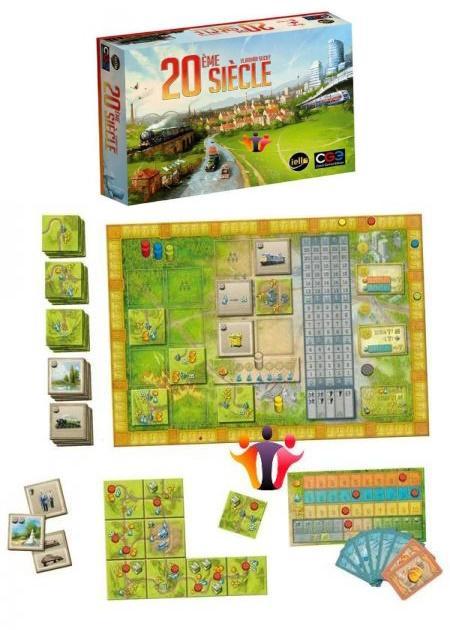
Hello everyone!
Today we are going to talk about the 20th century!
In the 20th century, develop your country, from 3 to 5 players for 90 minutes from 12 years old, to be the most prosperous country!
The urbanization of your country is up to you
A game includes six turns during which you oversee the urbanization of your country.
Some territories produce income, others scientific research, still others improve the quality of life.
Research allows you to discover new technologies that will shape the way your country develops.
Science can also help you avoid ecological disasters.
At the end of each round, your territories produce the money and research you will need to complete the challenges of the next round.
You accumulate victory points each round based on your country's quality of life.
At the end of the second and fourth rounds, you also earn additional points based on certain aspects of your country's development.
At the end of the sixth round, you score additional points based on your country's income, research, and environmental value.
A game consists of five full rounds and an abbreviated sixth round. Each round has six phases:
• Set up
• Territory Auction (and Technology Purchase)
• Disaster Prevention
• Consolidation (and Use of Technology)
• Production (and Recycling)
• Obtaining Bonuses (after rounds two, four and six)
Rounds one, three and five have no phase
of Obtaining Bonuses (even if it is always possible to
score victory points during Production).
The sixth round is abbreviated, it consists only of Consolidation, Production and the ultimate Obtaining of Bonuses.
The player with the most victory points wins since he will have built the country with the highest level of well-being.
Good day and good game ;)
On 27/09/2024
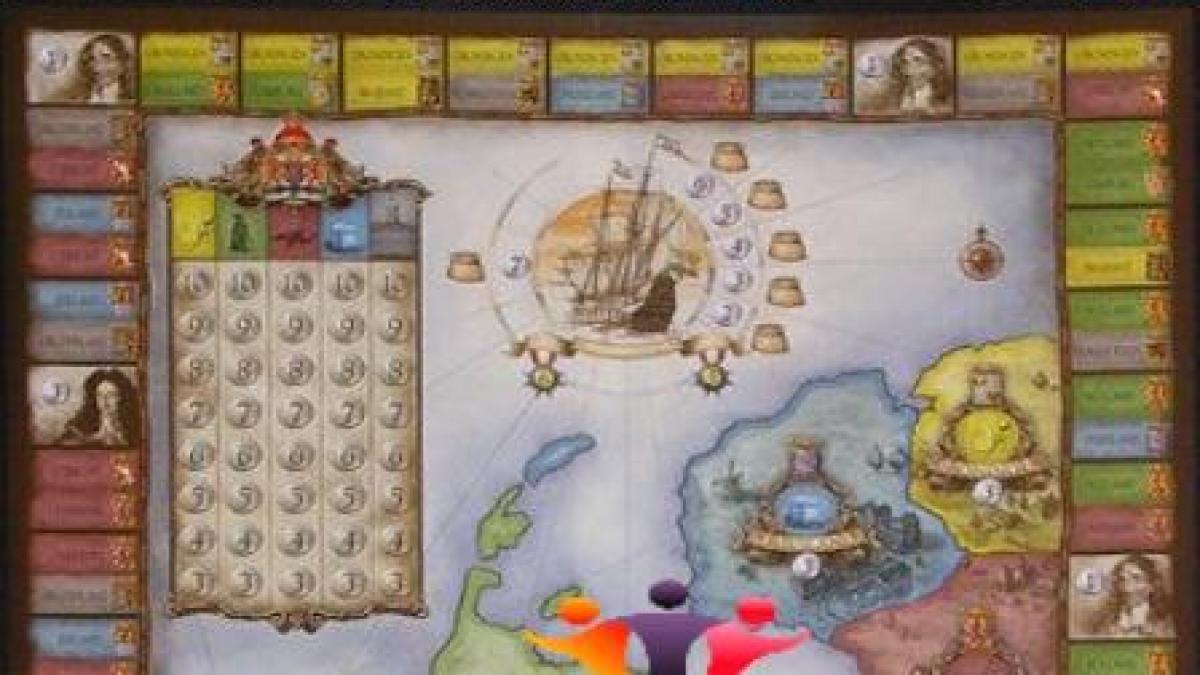
Hello everyone !
Today we are going to talk about the Golden Age!
In Siècle d’or, investors from the Netherlands, 3 to 4 players for 60 minutes from 10 years old, fruitful developments are yours!
In Golden Age, we play merchant explorers from the Netherlands who seek to get rich by developing its different regions.
The theme of this game is the economic and cultural development of the Netherlands in the 17th century.
The game is played on a large game board in the Netherlands, divided into provinces.
Additionally, there are spaces for the West Indies and the East, and a track all around the board with the majority of spaces listing two of the ten provinces (in various combinations) which earn players varying income depending on their influences in these provinces, or income spaces which provide players with a fixed income.
The players' goal is to be the first player to gain 33 victory points, which are acquired by earning money to expand their influence in the provinces, frequent artists, invest in businesses, establish colonies in India or achieve civic progress.
These are represented by purchasing cards from one of six decks, with each deck having a particular objective.
Investment cards allow cash payments, with larger payouts for collecting sets of different values (a single card is worth less than a set of three cards).
Artists provide a potentially large source of victory points, but require several rounds of patronage (i.e. money) before paying out.
Colonization cards provide ships, captains, and cannons to equip expeditions to establish colonies which yield victory points and access to the highest paying spice investment card game.
Civic cards can provide governorships in provinces (victory points and income), civic improvements (victory points), a special action that allows their holder to modify the normal rules to advance a token on the track of the board.
There are cards that also work with certain other decks, in the Civic deck (e.g. Investments, Expedition Components, etc.).
Good day and good game ;)
On 20/09/2024
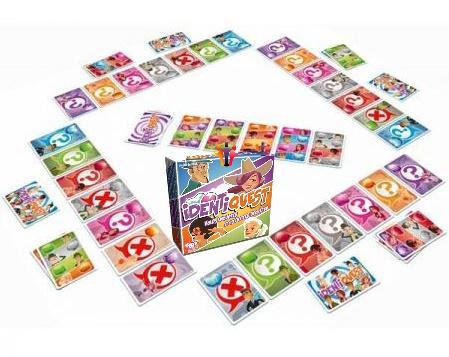
Hello everyone !
Today we’re going to talk about Identiquest!
In Identiquest, who will steal the most precious stones without being unmasked from 3 to 6 players for 15 minutes from 8 years old!
In Identiquest, we are precious stone thieves who must seize them, be unmasked or escape.
We shuffle the precious stone cards and place the draw pile face down in the center of the table, then we spread 5 cards from the face up pile in the center.
We then place the 7 different suspect cards in front of each player with the question mark faces up.
Each player then receives an “identity” card which they look at discreetly and place face down, without showing it to the other players.
The objective of each player will then be to steal the precious stones of the same color as their “identity” card.
Each turn, players have the right to one of two actions, steal gems or accuse a player.
To steal stones, the player takes 2 of the 5 precious stone cards placed in the center of the table and places them in front of him, this will be his loot (he places them on top of those already stolen if he has any).
We then replace the 2 stolen cards with 2 new cards from the pile in the center of the table.
To accuse a player, the player whose turn it is must report him to the police by announcing the color of the “identity” card he thinks the player has.
You must have at least 2 precious stone cards in your loot to be able to accuse another player.
If the accusation does not match the color of the offending player, the question mark card placed in front of the player will be turned over to show a red cross which indicates that the player's "identity" card is not of that color.
The player who accused him will have to give him 2 precious stone cards from his own loot.
If the accusation was justified, the accused player turns his “identity” card face up and all the other players turn their question cards of the color concerned in front of them towards the red cross.
A player is unmasked as soon as he is accused and it is the right color, he must then give 4 precious stone cards to his accuser (or the rest if he has less than 4).
A player escapes as soon as the last question mark card is turned over, he can no longer be accused.
As soon as the player has performed one of these two actions, another player takes their turn and chooses from these two choices.
The game ends when either the precious stone cards are exhausted or all players are unmasked or escaped.
Each player counts the number of precious stones in the color of their “identity” card to know the number of points they have earned.
The player with the most points wins the game.
Good day and good game ;)
On 13/09/2024
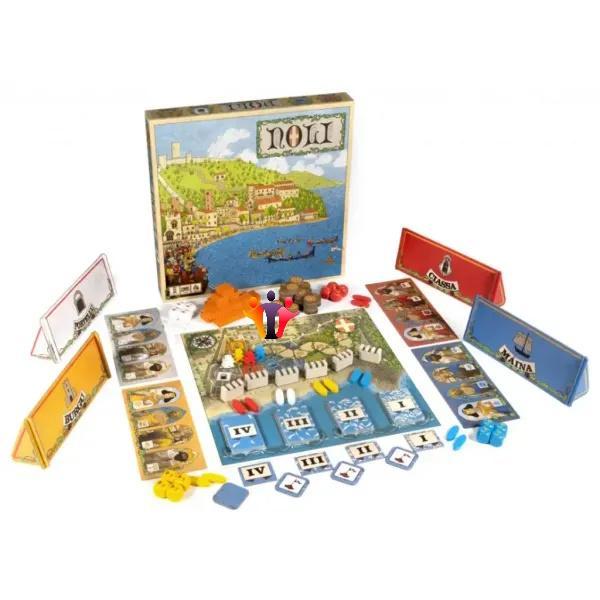
Hello everyone !
Today we are going to talk about Noli!
In Noli, let's build the most powerful seaport with 4 players for 45 minutes to be the best patron!
In Noli, we control a thriving medieval maritime city under the benevolent patronage of the powerful Republic of Genoa.
This sun-drenched fishing community has a rich history of independence, trade and competition.
Every year, in September, in order to determine the fishing rights for the following season, the gozzi (typical fishing boats of Liguria) from the four districts of Burgu, Ciassa, Màina and Portellu organize a regatta along a route of 1,600 meters, in fractions of 400 meters between buoys.
Not content with this form of competition alone, merchant families from each neighborhood compete with each other to build tall red brick towers to display their wealth.
Their successful buildings give the town of Noli its distinctive appearance, although no merchant tower can hope to match the proud castle atop Monte Ursino, whose constant vigilance and defensive walls protect Noli from Saracen raids and assaults jealous neighboring towns!
Each game follows a series of rounds, during which players will secretly bid on four actions using coins. The player who makes the highest bid for each action wins a bonus or moves closer to victory by building a floor of their tower.
Between each auction session, players frantically roll dice in real time to simulate the famous Regata-dei-Reoni. The winner of the race gets to fish in the best places, drawing from the best deck of fish cards, while the other players must draw from worse decks containing fewer fish. These cards can also feature events such as "The Saracens Attack!" and “Storm!” which disrupt the game and push players back.
If a player manages to build 6 tower floors, or have the most tower floors at the end of the game, they win!
Good day and good game ;)
On 06/09/2024
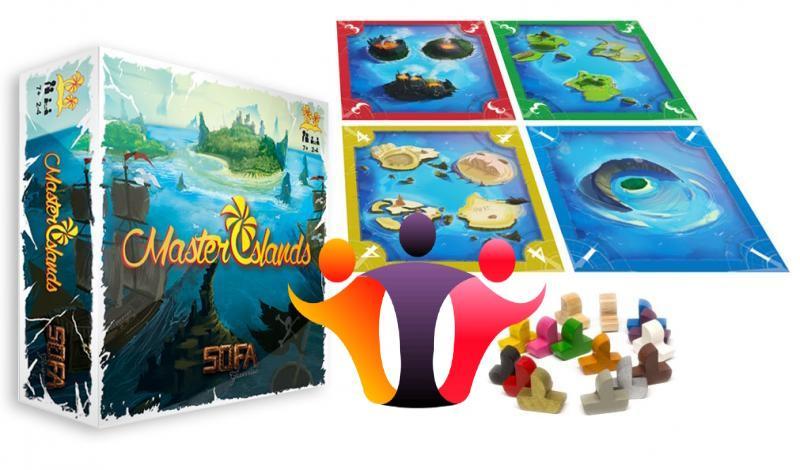
Hello everyone!
Today we're going to talk about Master Islands!
Be the first to win the maximum number of islands to become the Master Islands, 2 to 4 players for 20 minutes from 8 years old!
In Master Islands, we are corsairs who must seize as many islands as possible to become the master of the islands!
We shuffle the island cards then distribute 3 to each player and place the rest face down in a draw pile in the center of the table.
We place a first card from the draw pile face up on the table and each player chooses a color and places their two galleons on the island card face up.
A game turn is done in 3 phases. We start with the discovery phase.
We can place an island card so that it is adjacent to a card where we already have a galleon of our color (but not diagonally).
You can then move one of your galleons from a single card adjacent to the card where it is located vertically or horizontally.
If the island card placed by the player is of the same color as one of the cards where he already has a galleon, the player can put down another island card.
If this is not the case, it switches to the conquest face.
If the player has made a vertical, horizontal or diagonal alignment of cards whose sum is equal to 10, he can recover them if they do not include any galleon tokens, regardless of whether they follow each other or not.
If he cannot recover an alignment, the player moves to the resupply phase.
The player draws the number of cards he needs to fill his hand with 3 cards.
The game ends when there are no more cards in the draw pile or on the table. We then count the points already acquired by each player's 10-point island alignments.
The player with the most points at the end of the game wins.
If there is a tie, the player whose island sum is higher between the two tied players wins.
Play Master Islands in cooperative mode with a victory from 12 islands recovered or in more intense competitive mode with privateer mode where one player plays against all the others.
Good day and good game ;)
On 30/08/2024
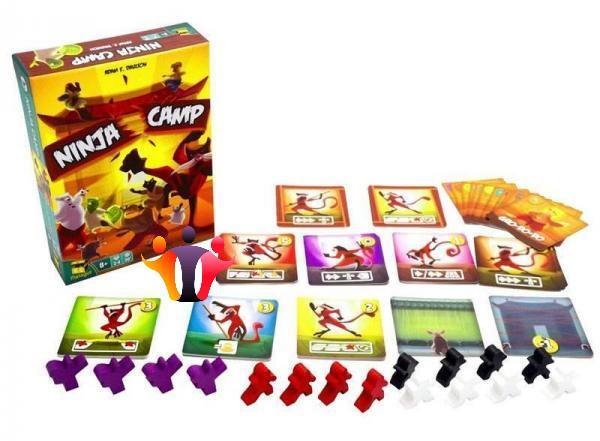
Hello everyone!
Today we're going to talk about Ninja Camp!
Who will be the fastest and most cunning of the students? Only the best will be able to become the disciple of Sensei Saru, 2 to 4 players for 30 minutes from 8 years old!
In Ninja camp, we will try to achieve the best score by collecting Technique cards.
Each player is given two Starting Technique cards and
four ninjas of the same color, then the ninja clan cards which they place in front of them face up.
We then mix the techinque, trap and wall cards together randomly to form a training ground:
-For 2 players, a field of 8*6 cards.
-For 3 or 4 players, a field of 8*7 cards.
Then each player will successively place one of their ninjas on a technical card on the grid until each player has their 3 ninjas placed on all different technical cards.
The active player chooses one of the following three actions:
- Play a Technique card from your hand, then place it in your discard pile.
- Activate the power of your Ninja Clan, then turn over your card (can only be used once in the game).
- To skip the turn. If a player cannot play Technique cards or use their Ninja Clan's power, they must pass.
Unless indicated on the card, a player cannot move diagonally; through, over or end your move on an empty space, a wall or another ninja.
He cannot move on the same card twice during the same turn or return to his starting square.
The player collects the Technique card or Trap card his ninja was on at the start of his move and adds it to his hand. This step creates empty spaces in the training ground as the game progresses.
When all players have passed, the game is over.
Players collect the Technique cards occupied by their ninjas on the training ground and place them in their discard pile.
Each player adds up the scores of the Technique cards in their hand and their discard pile.
The player with the highest score is declared the winner and earns the coveted spot as Sensei Saru's disciple!
In the event of a tie, the player who played last wins.
Good day and good game ;)
On 23/08/2024
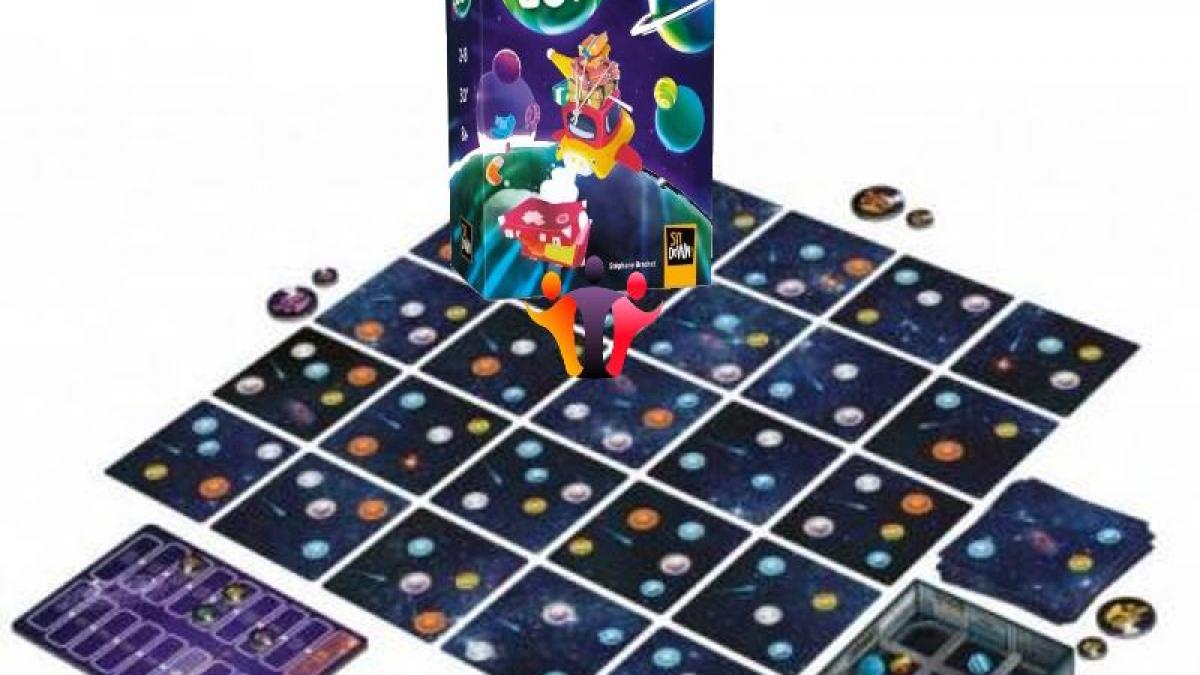
Hello everyone!
Today we're going to talk about Space Bowls!
Who can best place their marble goals in space, from 2 to 8 players for 30 minutes from 8 years old!
In Space Bowls, we will try to place our balls in optimal ways to align our planets according to our objectives.
Space Bowl is a competitive, simultaneous, turn-free game.
As quickly as possible, players must identify a habitable constellation somewhere in the galaxy using a diagram based on the position of the surrounding planets, transmitted by the on-board computer.
Those who succeed are rewarded with victory points.The game is divided into a series of rounds.
The Captain takes the Destination disk as well as the marbles corresponding to the planets displayed on the Constellation card visible at the top of the Infinity & Beyond pile.
Then it launches all these elements into the On-board computer box.
The Destination disc indicates the valid Constellation card where the spaceship should go during this round.
As soon as the throw has taken place in the On-board computer box, all players immediately start looking for a valid destination among the Constellation cards, that is to say meeting the criteria defined by the on-board computer.
When a player thinks they have found a valid Constellation card, they shout “Go!” » and raises the finger (pointing towards the sky) then begins a ten-second countdown loudly (“10, 9, 8…”) during which the other players can announce “Following!” » if they also think they have found a valid Constellation card.
If a player thinks that there is no destination matching the configuration required by the On-board Computer box – even using the Joker token – he announces “We are all going to die!” »: he then turns the large Crew token in front of him with the red Button side visible, and begins a ten-second countdown (“10, 9, 8…”).
Each player counts the points earned by the destination he has proposed as follows, and moves his Crew token as many spaces on the score track.
The game ends in two cases:either when at least one player has reached the last squarethe score track (we end the current round),either when the stack of Infinity & Beyond cardsis exhausted (after 10 rounds).
The player with the most points at the end of the game wins.
Good day and good game ;)
On 16/08/2024
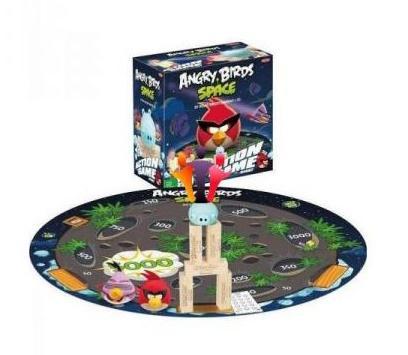
2 words game Angry birds space
Hello everyone!
Today we're going to talk about Angry Birds Space!
Who can knock down the pigs and score the most points, from 2 players for 15 minutes from 4 years old!
In Angry Birds Space, we will try to knock down the pigs and pieces of wood to win the most points on the game mat.
We install the play mat where an area is defined to place the pieces of wood and the pig on it.
The mat is marked with several play areas with points depending on where the pig and the pieces of wood fall.
We then move away from the mat a few meters to target the playing area with one of the two angry birds in the game.
We then aim for the pig, the pieces of wood or the point areas that interest us in three attempts.
If we do not reach 1000 points during a round with three shooting attempts, we note the player's points.
We then replace the elements so that the next player can also try to reach 1000 points in 3 shooting attempts.
You earn 100 points if the pig falls to the ground and 50 additional points for each piece of wood that falls on the carpet.
The game zones where the pigs or the ends of points fall earn the additional points indicated on the zone.
The first player to 1000 points wins the round and the player with the most points after several rounds wins the game.
You can increase the level of difficulty by moving a little further away from the playing area or with additional challenges such as aiming with the opposite hand from your usual hand or with your back turned, etc.
All you have to do is be imaginative and let your angry birds express themselves! It's up to you to play and have a good time!
Good day and good game ;)
On 09/08/2024
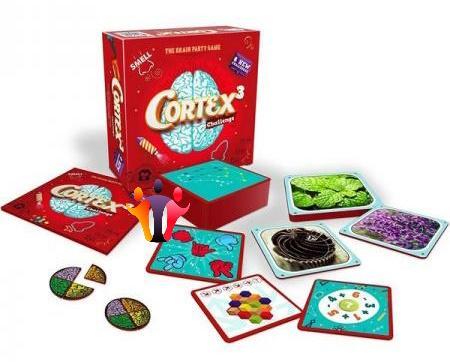
2 words game Cortex challenge 3
Hello everyone!
Today we are going to talk about Cortex!
Who can rebuild their brain the fastest by taking on the logic challenges, from 2 to 6 players for 15 minutes from 8 years old!
In Cortex be the first to find the solution to four different logic puzzles to rewire your brain and win the game!
Place the test cards in a pile in the center of the table, then turn the first face up.
We will then try to find the answer to the riddle as quickly as possible by putting our hand on the card as soon as we think we have found it.
We then give the answer by showing the card and once verified if the answer is correct, the player wins a card which he places in front of him.
Each player can only have 4 cards in front of him, he will have to discard any if he has more or exchange two identical cards (same back) for a piece of puzzle brain.
If he made a mistake, the card is discarded and a new challenge card is turned over to start a new challenge.
The challenges are made up of 8 different types of challenges:
- The orientation where we will leave from the starting point and find our way to arrive at the place indicated by the arrows.
- The color sequence where we start from the image surrounded by a red circle then we rely on the background color of the animal to find the next animal, then the next, etc.
- The intruder where you have to find the different shape among three shapes.
- The fusioform where we find which shapes made up the main form.
- Constellation where we find the constellation containing the most stars.
- Coordination where we must either with the left hand (blue symbol) or the right (red symbol) beat the sign surrounded by a red shifumi circle.
- Calculation where you must give the result of the calculation starting from a number in red.
- Olfactory challenge where you rub the card face down and try to find the smell hidden behind it. Only the player who won the last card completes this challenge.
The game ends as soon as a player has completed the four pieces of their brain puzzle.
Good day and good game ;)
On 02/08/2024
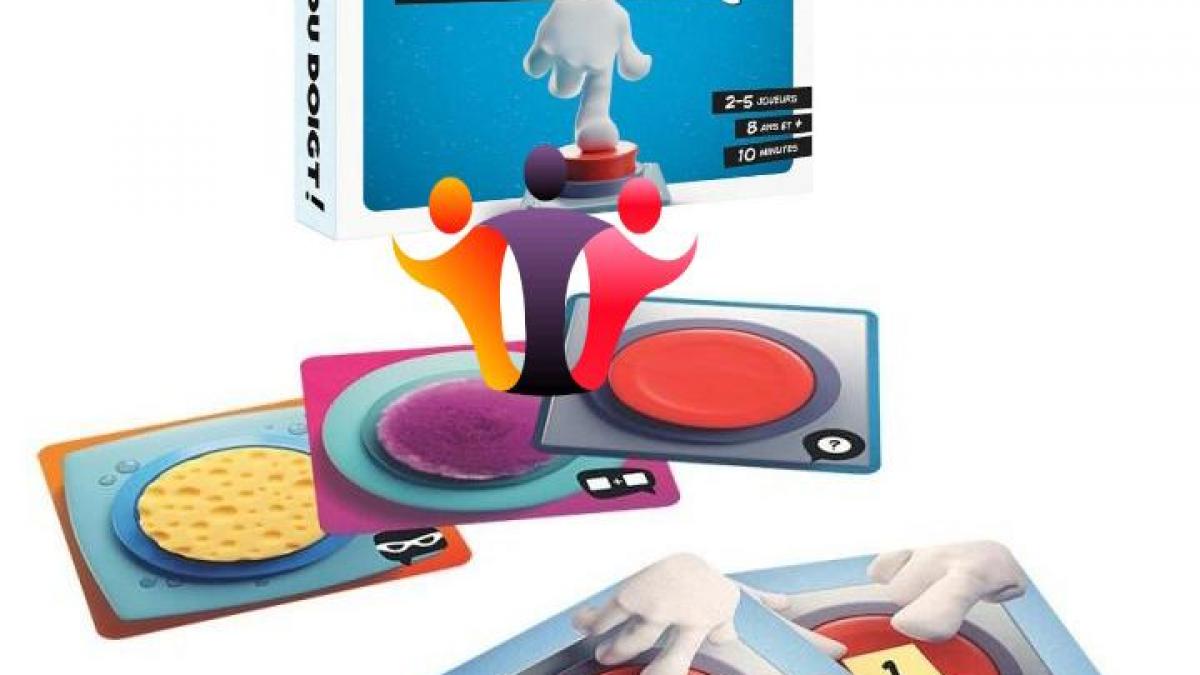
Hello everyone!
Today we are going to talk about one finger!
All together, point to a number of fingers hoping to guess the number face down, from 2 to 5 players for 10 minutes from 8 years old!
In one finger, don't lose sight of the other players to see who will point their finger on the map!
A draw pile of button cards is placed in the center of the table, with the numbers visible.
We then announce a number between 0 and the number of fingers placed on the card, therefore from 0 to 5 maximum.
Players then immediately choose to either lift their finger from the card or leave it resting on the card.
The announcement is successful if the number of fingers remaining on the card corresponds to the number announced by the player and the effect of the card is applied.
The player who made the announcement wins the card and another card from the pile is revealed, changing the player who announced the number.
If the announcement is missed, we play again with the same card until the announcement is successful.
The red button allows you to win the card if the announcement is successful, the thief button allows you to steal a card of the same number announced from the piles of other players if it is of the same value.
The double button card allows you to place another button, number face up, and play to win two cards at once.
When there is only one card left and the draw pile is exhausted, the game is over and each player counts the number of cards he has accumulated in front of him.
The player with the most cards wins the game!
Good day and good game ;)
On 26/07/2024
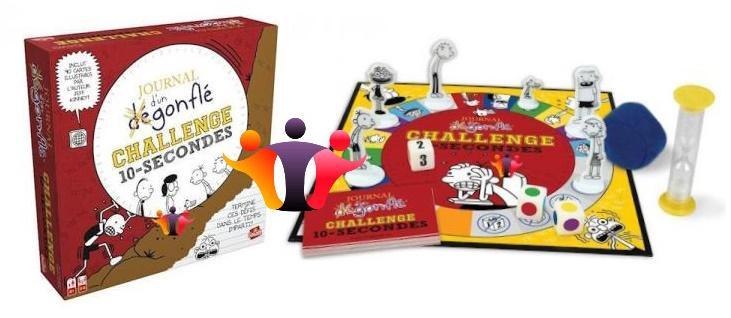
2 words game Diary of a whimpy kid
Hello everyone!
Today we’re going to talk about The Diary of a Wimpy Kid!
Be the first to complete the challenges within the time limit, from 2 to 6 players from 20 to 40 minutes from 8 years old!
Ready, set… Hurry!
Greg and his friends challenge you, each one faster and funnier than the last!
The game “Diary of a Wimpy Kid; 10 second challenge” includes everything you need to deflate your best friends.
It's not that the challenges are difficult (okay, some are), but you'll need luck and skill to complete them in less than 10 seconds.
There are ball challenges, cube challenges, intellectual challenges and challenges that sometimes literally bring you closer to your opponents!
Move forward on the board each time you complete a challenge. It's much more fun than letting others overtake you!
Things will get tougher when, with the dice and the ball on your head, you will have to kneel down and name 8 teachers, types of ice cream or breeds of dog at the same time.
The game board tells you the actions you must perform and if you progress quickly, your life will not be that of a loser, but of a glorious victor.
There are 3 categories of challenges: solo, categories and two players. Will you be the champion or the loser?
Choose one of six characters to move, place them at the start, and let the race begin! Players take turns rolling the die and moving around the game board, taking on challenges as they arise.
Each round, players draw a challenge card and determine whether they will accept the challenge or pass it on to the next player. Challenges can be solo, category-based, or two-player. Successfully pass a card to advance as instructed, but fail and you will have to move back one space.
The last four squares on the game board are “no” squares. On your turn, instead of rolling the die, you take a challenge card and complete the challenge.
This time you can't refuse it.
The first player to complete their race wins!
Good day and good game
On 19/07/2024
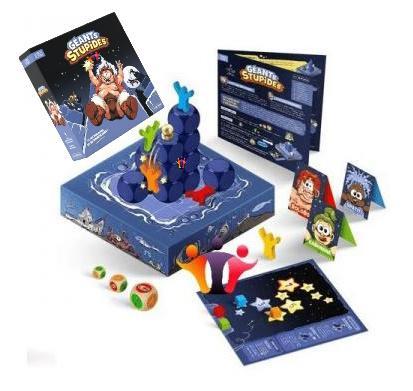
Hello everyone!
Today we're going to talk about Stupid Giants!
Be the first giant to climb the mountain to catch 7 stars and win the game, 3 to 6 players for 30 minutes from 7 years old!
In Stupid Giants, let's chase the stars to become the best giant!
The first player takes 2 actions. Pray to the Ancestor and take a free rock without anything on it to move it either to a space on the ground (never in the water), or to another free rock or occupied only by the Head of the Ancestor.
Finally, he must take the Head of the Ancestor and place it on the displaced rock! Climb the mountain to jump and catch stars!
From the next round, everyone first has 2 free actions, to distribute freely: pray to the Ancestor, then move OR the opposite OR pray twice (to move 2 rocks) OR move their giant twice.
Then, he can stop his turn OR... let out another cry! Another giant (any one) then rolls the big opposition die: As long as the giant receives flowers, he can continue!
With each new cry, the big opposition die will be thrown...
In short, a giant's turn ends when the player decides to do so OR... when he receives a nonos or a carcass in his face OR... when he has caught stars OR when he has lost a fight.
At the end of these 2 actions, a giant can stop its turn OR... show its stupidity and let out a cry of giant effort! Alerted by this cry, another giant (any one) rolls the small opposition die.
Then he decides again whether to stop his turn OR... let out another cry of effort!
Another giant (any) then rolls the medium opposition die.
He moves his giant to a neighboring square: on the ground or on a rock located maximum 1 level higher.
Giants never move diagonally!
Jumping ! A giant who spends an action to move to a neighboring square located 2, 3 or 4 rocks lower, performs a jump.
He grabs 2, 3 or 4 stars respectively and advances his little cube on the score board! His turn is over.
Coming down from a single rock is not jumping, it is called walking for a giant and his tour continues...
The fall of a giant (shot to the carcass, defeat in a fight) never allows you to catch stars.
If a giant jumps from 5 rocks (the maximum height) he does not catch stars, but enters the legend!
The game is then immediately over, the other giants stand up and applaud his victory by KO!
If there is no victory by KO then the first giant to obtain 7 stars wins the game!
Good day and good game ;)
On 12/07/2024
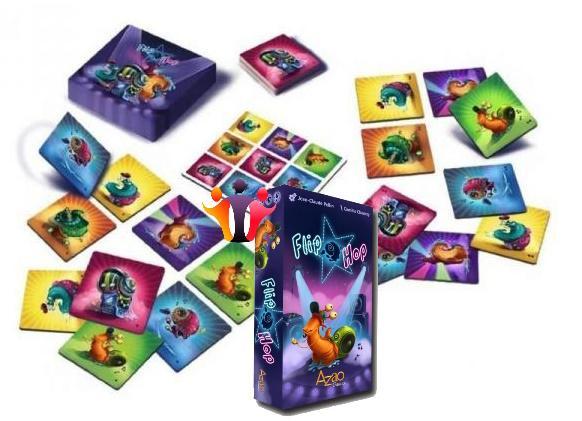
Hello everyone!
Today we're going to talk about Flip Hop!
Do the snail break dance as quickly as possible, with 2 to 4 players for 15 minutes from 6 years old!
In Flip Hop, recompose the snail dance in the correct order before the other players to win the break dance card.
We turn over an “objectives” card to place it face up on the table.
The goal is then to be the first to reconstruct the composition of the nine snails in the order and orientation of the “objective” card with its cards in front of you.
The first player to succeed wins the “objective” card, if of course they make no mistake.
If he makes a mistake, he obtains a pledge such as playing with one hand, doing a trick even when two cards are changed or even applauding each time a partner activates his pledge, etc.
If a player obtains 2 “Objective” cards, his opponents can impose a permanent pledge of their choice on him.
For the competitive variant, when a player has reconstituted an objective and has placed his hand in the middle of the table, if the arrangement of this player's snails does not correspond to the "Objective" card, the player receives a penalty in place of a pledge.
He then takes the “Objective” card and places it face down in front of him.
If a player receives 2 penalties, he is excluded from the game.
For the children's variation, when playing with younger children, allow them to play without the orientation of the card.
For a young child, have them play solo. When he thinks he has the solution, check to see if he wins the card. After 3 points scored, he wins the game.
The first player to win three “objective” cards wins the game!
Good day and good game ;)
On 05/07/2024
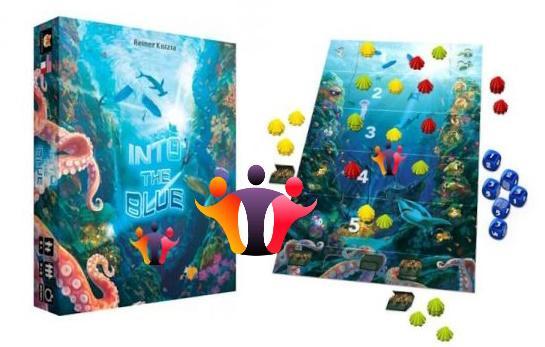
Hello everyone!
Today we're going to talk about Into the Blue!
Dive in search of precious resources, 2 to 5 players for 20 minutes, ages 8 and up!
In Into the Blue, explore the depths and collect precious goods, but be careful, you are not the only one who wants to seize these submerged wonders...
On his turn, the active player throws the 6 dice into the lid of the box. Among these 6 dice, he can choose to reroll the dice of his choice, a maximum of two times. He places the dice he wishes to keep in front of him, and throws the other dice back into the lid of the box.
At the end of his three throws, the result can no longer be modified.
If the player keeps certain dice after the first roll, he can choose to reroll any of these dice on the third roll.
The player then arranges his dice, from smallest to largest. Only dice forming an uninterrupted sequence of numbers starting with 1 (1, 2, 3, etc.) are taken into account.
The final result forms an unbroken sequence of numbers starting with 1. If a number is missing in the sequence, all dice with a higher value are lost.
The player must then choose any number from the validated sequence and place on the corresponding level of the game board as many of their Shell tokens as there are dice displaying this number.
During the game, each player establishes his presence on each diving level by stacking his Shell tokens there.
If a player's final result does not include a 1, all 6 dice are lost. Their turn ends and it is up to the next player to play.
If a player's final result contains an unbroken sequence of numbers 1 to 5 along with a chest symbol, they have made a perfect dive. He then does not place any Shell tokens on the board, but randomly chooses one of the Chest tokens at the bottom of the game board. These can have different values (5, 6, 6, 7 and 8), and the player keeps the secret. value of the chest he won. He then immediately plays a new round.
Clarification: when you perform a perfect dive, you must collect a Chest token. You cannot choose to give it up to place a Shell token on the board.
The end of the game is triggered if either a player places their last Shell token on the board or if a player manages to win the last Chest token (by performing a dive).
perfect) and in this case only, the other players do not have a last turn and the game ends instantly.
The player who has placed the most Shell tokens on a level wins the Main Treasure token of the level. The 2nd player with the most Shell tokens on the same level wins the Secondary Treasure token. Proceed in this way for each dive level.
Several players can be tied on the same level. In this case, the player with the most pawns on the level immediately above wins the disputed token by the corresponding tie.
If the tie continues, continue to proceed in this way with the level above, up to level 1 if necessary.
If the tied players have the same number of shell tokens up to and including level 1, the player with the most unused shell tokens wins the level.
If the players still cannot decide between themselves, the player who played their last turn first wins the tie.
The player with the most points wins the game!
Good day and good game ;)
On 28/06/2024
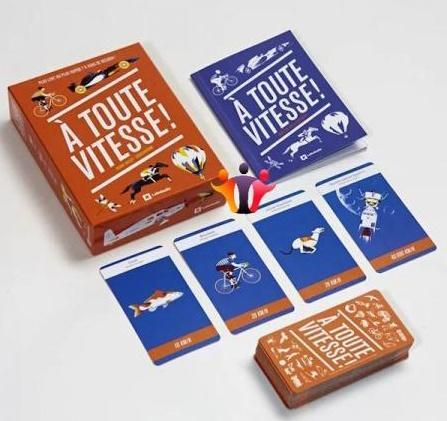
Hello everyone !
Today we're going to talk about Full Speed!
Rank the different objects and animals in order of speed, from 10 to 30 minutes for 2 to 8 players!
In Full Speed, placing the cards in the right place will prevent us from drawing penalty cards.
We place all the cards in a pile face down on the table, then we place a first card in the center of the table.
A player then draws a first card and has the other players guess his speed by showing the entire card except the speed which he hides with his fingers.
The player questioned by the first player has three possibilities for placing the card on the speed line:
- On the left, if he thinks that the card is slower than one of the cards already on the table.
- On the right, if he thinks that the card is faster than another face up card.
- Above, if he thinks that the card is as fast as one of the cards already on the table.
If he made no mistake, the card remains on the Speed line, but if it was not correct, he takes the penalty card and places it face up in front of him.
As you play, the Speed line will expand and the placement of cards will be more difficult to perform.
As soon as there are 12 cards lined up, the player who has just placed the twelfth removes the first and last card from the Speed line and the game continues.
The game ends as soon as 3 penalty cards are collected with 4 players and 5 with 2 and 3 players.
The game continues with the remaining players until there is a winner.
Good day and good game ;)
On 21/06/2024
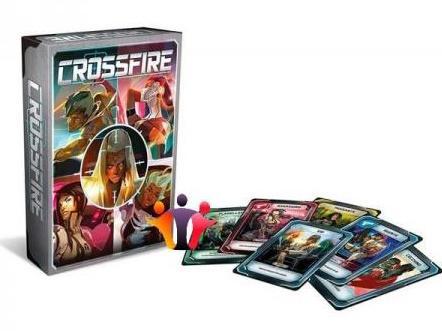
Hello everyone !
Today we're going to talk about Cross Fire!
Don't get caught in crossfire, 5 to 10 players for 5 to 10 minutes from 14 years old!
In Cross Fire, we will play hidden roles either VIP protectors or VIP enforcers, but also personal objectives.
In Cross Fire mode, players form two teams, blue and red. The red team must reach the VIPs and the blue team must prevent the VIPs from being hit.
After looking at the cards of the different characters, we learn about their role in the game and their specificities.
Then we shuffle the cards again to distribute them to the next player who will do the same.
You will then have to claim a role with the card placed in front of it face down, trying to hide your true role to achieve your objective.
By discussing with the other players, about the roles that we try to deduce with the previous shuffling of the cards and their words, we try to determine what the role of the other players is.
To claim another role, you change the meaning of your card. We cannot show our card face up to the other players, but we can very well claim to be playing a role that is not ours to achieve our objectives.
Then, after 3 minutes of discussion and bluffing, on the count of 3, we point our finger at another player.
With his finger still pointed at another player, the game leader announces:
- If you are not armed, lower your finger.
- Agents, reveal your role card.
- If you have been targeted by an agent, lower your weapon and reveal your role card.
- VIP reveal your role cards. Are you targeted?
Yes: the red team wins; No: the blue team wins.
Some cards have victory or defeat conditions and are announced at that time.
With Sniper mode, the sniper will attempt to kill the assassins by placing his sniper shot cards before the time runs out. At the end of the round, the players targeted by sniper fire are shot down and reveal their role cards.
If all assassins are killed, the blue team wins; but if the sniper kills a VIP or a civilian, the red team wins.
If no team has won at this stage, the assassins not defeated reveal their role cards; we count down again to 3 until the final resolution.
To win at Crossfire, let your instincts guide you.
Your first lead is the role the players say they have. If too many players have the same role, someone is bound to be lying...
Your second avenue is observing the cards before the start of the game. Did you see the same cards as what other players announced?
Perhaps you have found allies... Each piece of information is very useful; it's up to you to put the pieces of these bits of information together.
So who is lying? Who tells the truth? Who should hide their identity? Who seems to be looking for the truth? Who seems evasive or too talkative?
We add up the points from each round and the player with the most points wins the game.
Will you be caught in the crossfire?
Good day and good game ;)
On 14/06/2024
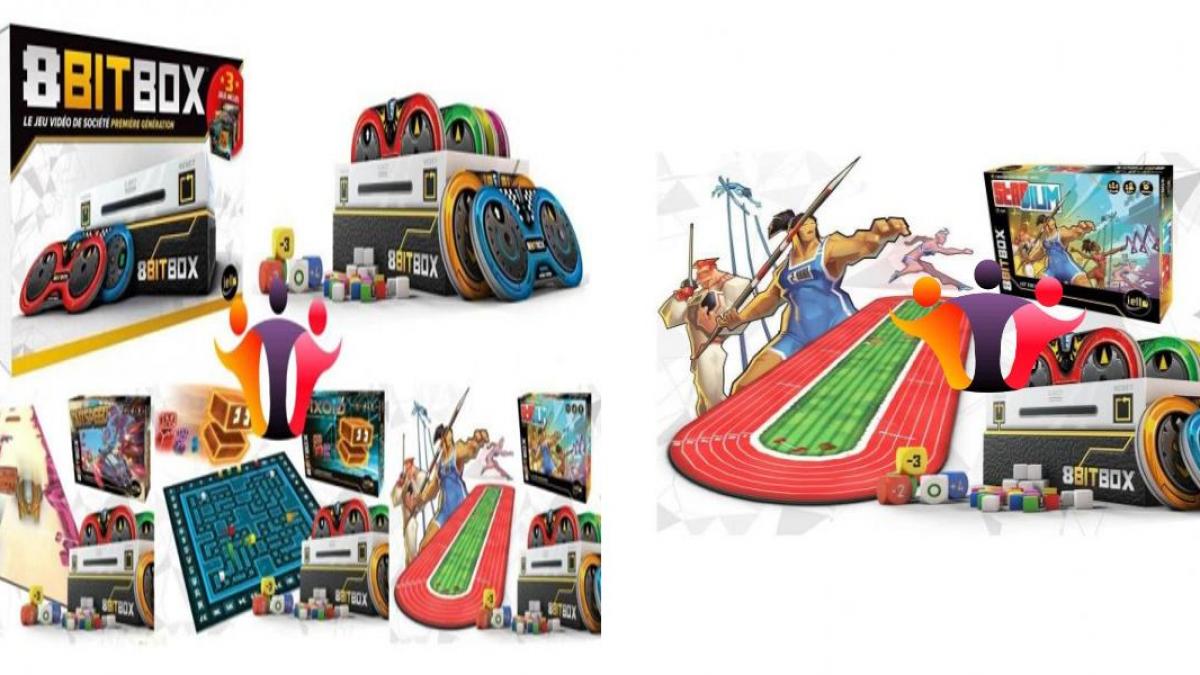
2 words game 8 bit box stadium
Hello everyone !
Today we are going to talk about 8 bit box!
3,2,1, ready, fire, go for a wild Olympic race, among other things, 40 minutes of 4 to 6 players from 8 years old!
In 8 bit box, we play Pixoid, Outspeed and Stadium! Defeat the ghosts, win the race and prove yourself at the games!
And today, we're going to talk about Stadium and its 10 team events to achieve victory over other athletes.
The best athletes from the Blue Starz and Red Sunz are expected on the athletics track!
You have trained your whole life for this event. It's up to you to show what you're worth, but keep in mind that you will be stronger as a team.
Manage your efforts as best as possible during all the events so that your nation shines by winning as many medals as possible!
Using your controller, decide how much Energy you want to spend in the current Trial.
Each Event being different, you will need to be on the same wavelength as your Team partners to be able to go the distance, and thus win a maximum of Medals at the end of 10 Events.
Each type of Medal earns a certain number of points.
Trial tiles come in three types: standard Trial tiles, Rest Trial tiles, and Final Trial tiles.
When the Trials are set up, they form an athletics track.
During this phase, the first player reveals the next tile still face down according to the direction of the game.
During this phase, play the current Event as indicated by the explanations read by the first player.
You are never allowed to program your controller with a number greater than the amount of energy remaining on your Energy track. You can always program 0. The cube on your Energy track can never go beyond 30 or below 0.
If the Crucible allows you to communicate with other players, everyone at the table must be able to hear you. You can never show your controller to other players until the Crucible asks you to reveal it.
So who will win after the following events: track cycling, horse riding, golf, team gymnastics, 4X100m relay, weightlifting, pole vault, archery, pole vault, 100 meters, beach volleyball, fencing, rugby , taekwendo and the final, basketball.
When the Trial ends, award the corresponding Medal(s) as described in the explanation of each Trial.
The game ends when the Medal of the 10th Event has been awarded. Each Team adds up its victory points.
The team with the most victory points at the end of the game wins.
Good day and good game ;)
On 07/06/2024
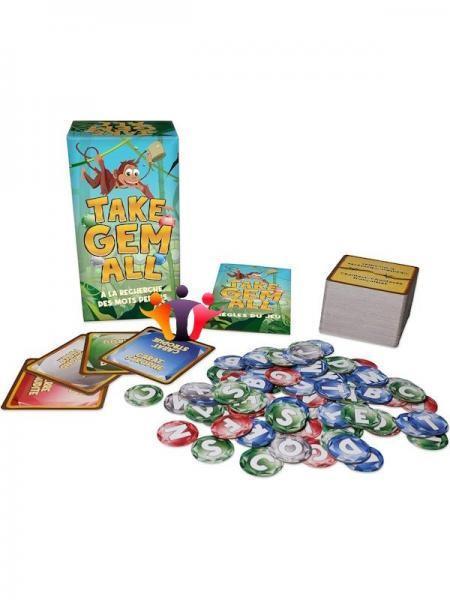
Hello everyone !
Today we are going to talk about Take gem all!
In Take gem all, find the best word for 20 minutes, from 8 years old and from 2 to 10 players to win as many gems as possible!
In Take Gem All, grab as many precious stones as possible by being the fastest player to give an answer corresponding to the theme played and starting with one of the four letters in play!
But be careful; beware of trap cards that could slow you down and diamonds that could disrupt the flow of the game...
Once the theme is known, players must be the quickest to find an answer related to this theme and whose first letter begins with one of the 4 letters proposed by the Precious Stones.
The first player to give a correct answer wins the Gemstone of the letter used:
- Emeralds (green) are worth 1 point
- Sapphires (blue) are worth 2 points
- Rubies (red) are worth 3 points
- Diamonds (gray) allow you to steal a stone from another player.
There are 4 kinds of trap cards, bamboo, carat'strophe, cursed stone and diamond fever which allow other players to play, replace the precious stones, have to discard a stone and use the letters following the letters drawn to create words.
The game ends once all Theme cards have been played. Players count their points and the player with the most wins. In the event of a tie, the tied players compete in a final round.
Good day and good game ;)
On 31/05/2024
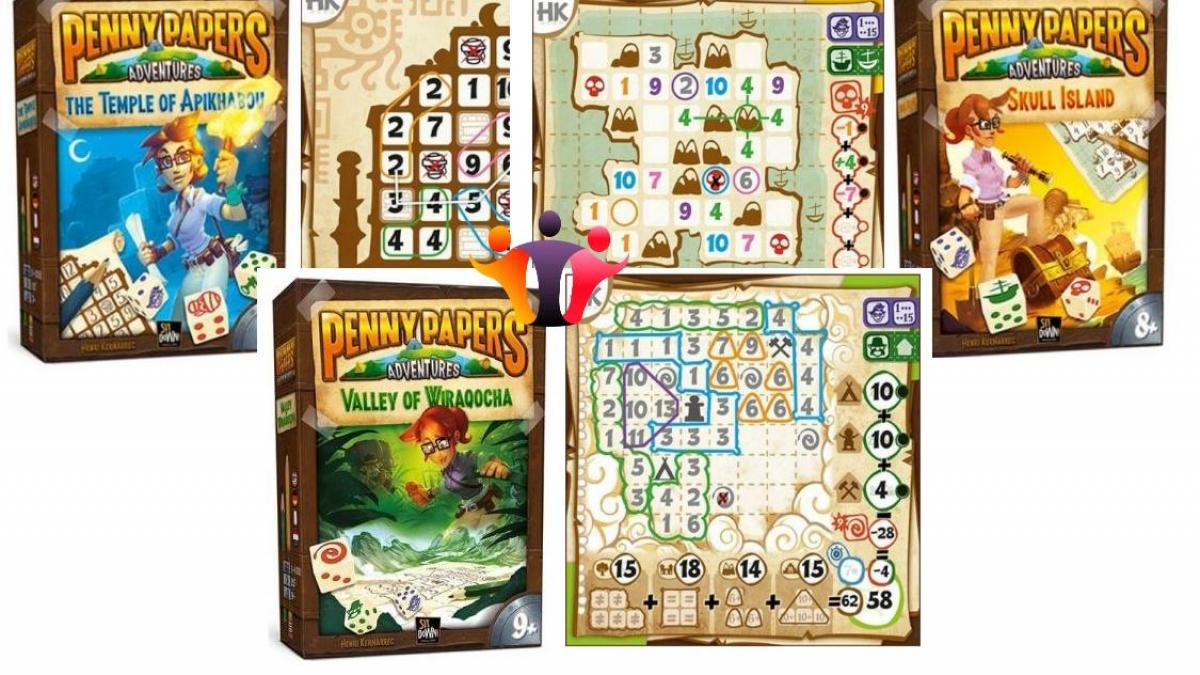
Hello everyone !
Today we're going to talk about Penny Papers!
In Penny Papers, go on a 30-minute adventure, from 8 years old and from 1 to 4 players without forgetting the peppers to score the highest score!
Adventure is before us with this series of small strategic games.
We roll the 3 dice and the result is common for all players, who write down the path they wish to take to obtain objectives.
We then advance to the heart of the adventure in more depth to complete our grid in order to score as many points as possible.
All players write numbers into their grid optimally to get the most victory points.
Test your ability to manage space and use dice special effects wisely.
Oh, and don't miss an opportunity to upset your opponents' grids when dangers appear!
Influence the grids of other players with your roll of the dice and adapt to the different results to win this adventure!
The number of players is unlimited since everyone plays at the same time!
Good day and good game ;)
On 24/05/2024
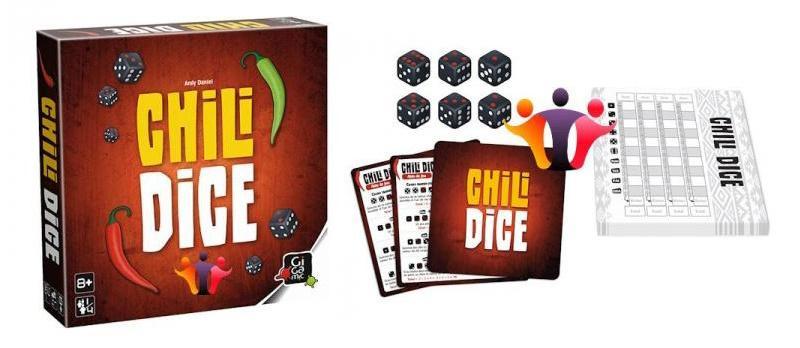
Hello everyone !
Today we're going to talk about Chili Dice!
In Chili Dice, create dice combos for 30 minutes, from 8 years old and from 1 to 4 players without forgetting the chili peppers to score the highest score!
In Chili Dice, you can roll the dice as many times as you want during a round to try to maximize your score.
But you only have thirty dice rolls at most in the entire game, so be careful when you try your luck!
Chili Dice includes a set of six six-sided dice, with one side on each die having red pips instead of white, with a red 1 on one die, a red 2 on another, and so on.
On a turn, you roll all the dice, set aside any dice you want, and rotate any red die facing the side you want (or leave them as is).
You can re-roll the remaining dice and repeat the process, noting each roll on the score sheet.
When you stop, you score the dice in one of the ten fields on the score sheet, scoring for the numbers 1 through 6 (the red die doubling your score, if present); a straight; red dice; sets; and everything you have in front of you.
If you complete all ten fields before maxing out your rolls, you receive 5 points for each unused roll.
Whoever scores the most points wins!
Good day and good game ;)
On 17/05/2024
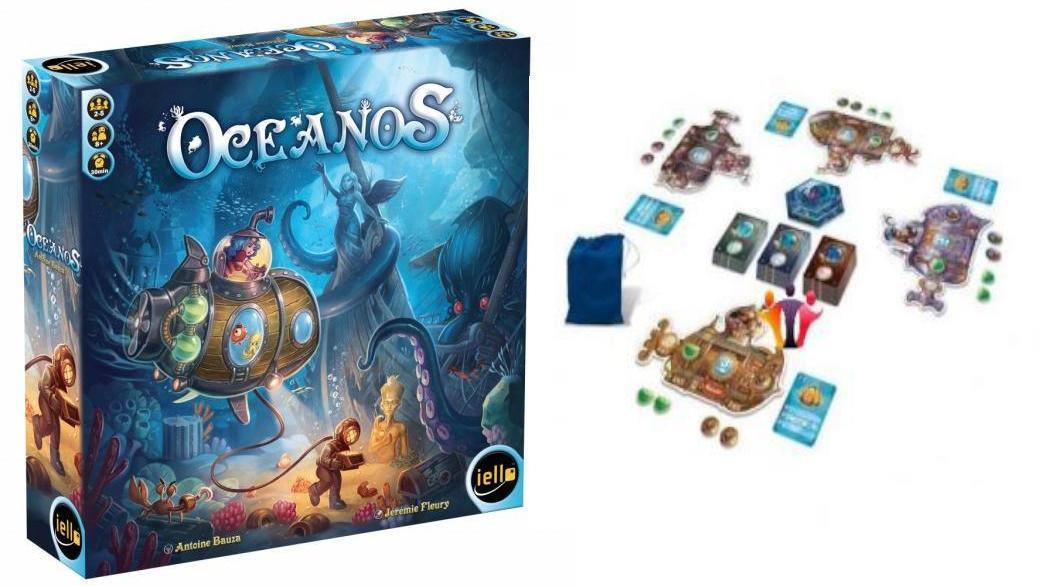
Hello everyone !
Today we are going to talk about Oceanos!
In Oceanos, play as an expedition captain for 15 to 20 minutes, from 8 years old and 2 to 4 players collect astonishing animal species!
Throughout the game, the player composes his underwater expedition by arranging his exploration cards on three superimposed lines.
Each captain chooses an expedition card and passes them to the other captains who do the same. The exploration cards contain several elements that allow you to score points or improve your submarine.
Each submarine is made up of five elements which improve as you progress through the levels: a thruster, an engine, a cockpit, an aquarium and a diving hatch.
Exploration cards represent the discoveries of expeditions which are either positive (animals, corals, treasures), negative (kraken eyes) or improvements (bases and crystals).
The game is played in 3 rounds of rounds. Each player chooses a color and assembles their submarine with the level pieces, then after placing the diver and fuel tokens, we randomly draw a kraken token for the 3 sizes.
The expedition cards of the round are distributed, then each player receives an exploration card per possessed periscope.
You choose an exploration card to play face down in front of you, then the players place them from left to right on the same line. We will have one line of exploration cards per round. Fuel tokens allow you to keep a card face down for safekeeping.
The diver token allows you to recover the treasures found there and all those on the cards under which they are found on the ascent on a map with a treasure.
To improve your submarine, the crystals placed before the base will determine its level at the end of the round.
You earn points based on the animals collected and the submarine thrusters.
Then we count the Kraken's points with a token. It is the player who has the most on his cards who loses the points associated with the token of the current level.
At the end of the game, the player with the most victory points is the winner.
Good day and good game ;)
On 10/05/2024
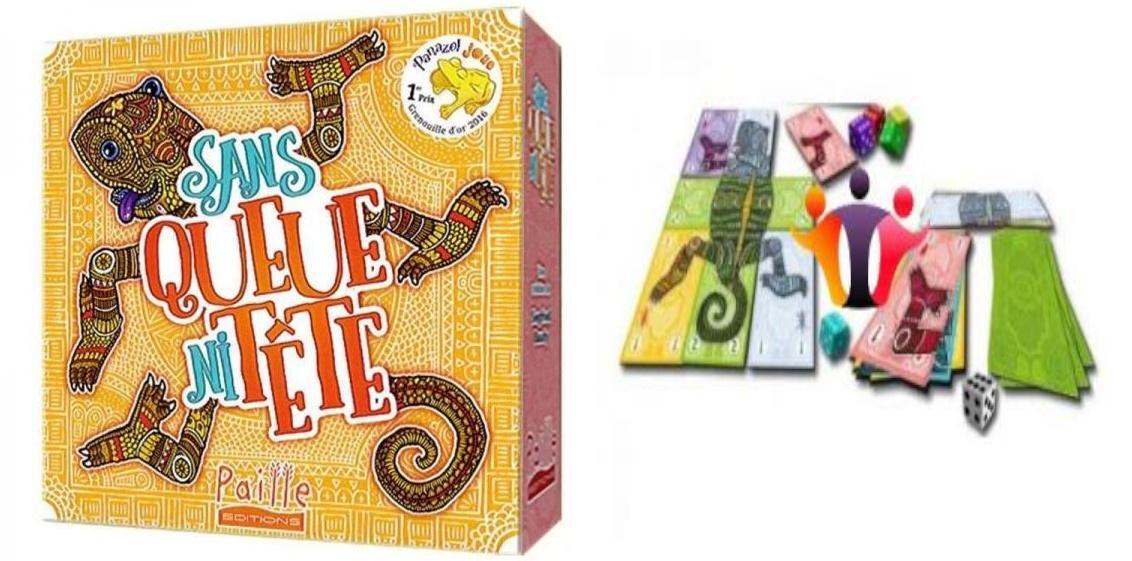
2 words game Sans queue ni tête
Hello everyone !
Today we're going to talk about Sans queue ni tête!
Place your chameleons for 15 to 20 minutes, from 8 years old and from 2 to 4 players to win the game!
You have to rebuild the chameleons on the table piece by piece and try not to be the color with the most points on any of them.
At the end of a round, the player whose color has the most points on a chameleon will score those points.
Players can score on multiple chameleons at once.
Once a player reaches 32 points, the game is over and the player with the fewest points wins.
A complete game takes place over several turns, a turn is made up of 6 turns, a turn is made up of 3 phases
1.Choose cards Each player secretly selects the card he wishes to play and places it face down on the table.
2. Roll the dice When each player has a face down card in front of them, everyone rolls their die. The player with the lowest score starts. In the event of a tie, tied players reroll their dice until a winner emerges.
3. Playing card The first player reveals his card and plays it. Then, starting with the player to their left, the other players take turns doing the same in a clockwise direction.
Once you start building a chameleon, you need to finish building it by placing cards on it clockwise.
When all players have played, begin the next round by starting again from phase 1.
Good day and good game ;)
On 03/05/2024
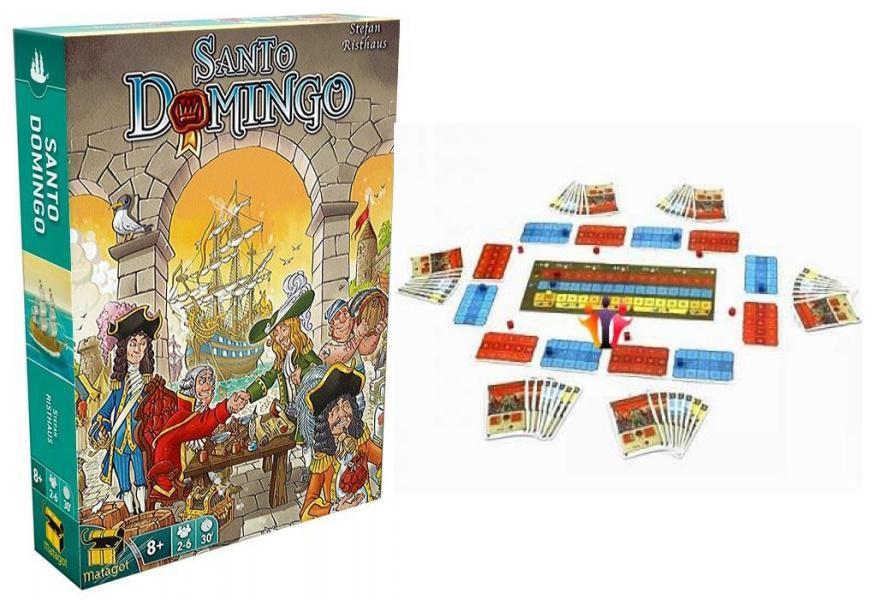
Hello everyone !
Today we are going to talk about Santo Domingo!
Place your goods and actions for 20 to 30 minutes, from 8 years old and from 2 to 6 players to gain the maximum number of life points!
In Santo Domingo, you must try to make the best possible use of your 8 Action cards.
Each round, players simultaneously choose an Action card.
The cards are then resolved in ascending order. You will therefore have to estimate as best as possible which card your opponents will choose.
Depending on the cards played, you will obtain victory points (VP) (cards 1, 2 and 6) or goods (cards 3, 4 and 5).
The Merchant (card 7) will then allow you to exchange your goods for VPs. The Beggar (card 8) will allow you to regain control of your cards.
The game ends when a player obtains 30 VP. At the end of this round, the player with the most VP wins the game.
A Santo Domingo game takes place over several rounds. Each round is broken down into three phases:
1. Restock
Advance all the markers on the game board a number of spaces depending on the number of players.
2. Play an Action card
Each player chooses one or more Action cards to play for this round: 2 cards during a game with 2 or 3 players and 1 card during a game with 4, 5 or 6 players.
You will find a reminder of the number of playing cards in the upper corners of the game board. The card(s) are placed face down in front of the players.
When all players are ready, all cards are revealed simultaneously.
3. Resolve Action cards
The effect of each card is then applied in ascending order of card values (starting with the Captain, if he has been played). The effects of identical Action cards are applied at the same time (there is no order of play).
The cards played remain visible until the end of the round; they will only be discarded face down once all the cards have been resolved.
All players have the same 8 action cards: Captain, Admiral, Governor, Frigate, Galleon, Customs Officer, Merchant and Beggars.
Depending on the cards, you will receive life points or goods. These can move our hit point slider up or down.
Players who did not play Beggar during this round now discard the cards played into a personal discard pile, face down.
As the rounds progress, these players will have fewer and fewer cards to play, until they play a Beggar which will allow them to take their cards back into their hands.
The game board markers remain where they are for the next round.
If no one has reached 30 VP or more, a new round begins.
Good day and good game ;)
On 26/04/2024
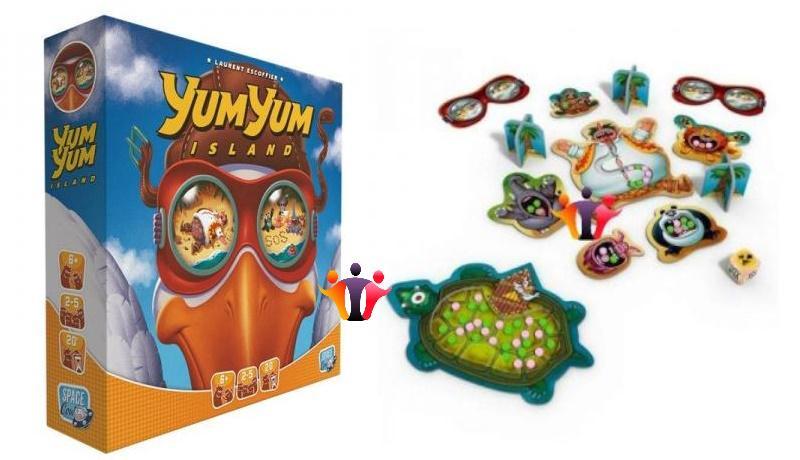
Hello everyone !
Today we're going to talk about Yum Yum Island!
Feed the animals blindly but guided in 20 minutes, from 6 years old and from 2 to 5 players to earn points!
More information: Joulejeuvaison.com
Good day and good game ;)
Yum Yum Island is populated with hungry animals, animals that you and your fellow players must feed before the island giant can take food from you and fill its own belly first.
In the game Yum Yum Island, players take on the role of pelicans trying to feed the animals on the island.
Each animal is represented by a cardboard cutout with a second raised level to identify the animal's mouth.
Inside the mouth are two numbers – one green and one red – which indicate the amount of vegetarian and meat-based food the animal needs to be satisfied.
On their turn, a player first rolls the die to determine the difficulty level of this round, then they put on the blindfold so they cannot see the playing area.
The player collects a certain amount of food from the supply (which contains a mix of red and green tokens), reaches out and tries to place the food into an animal's mouth.
Any food that falls out or does not meet the animal's needs is placed in the giant's intestinal tract.
The die roll can allow other players to give advice (“Move left! Remove your hand!”) or allow the player to collect some food or receive help during the turn.
Blindfolded, let yourself be guided by the other players to feed the animals and give the corresponding number of foods each turn.
But be careful, if you make a mistake and the giant's stomach is full before all the animals on the different islands are fed, the giant wins and all the players lose!
The gourmet islands are yours! Yum, yum!
Good day and good game ;)
On 19/04/2024
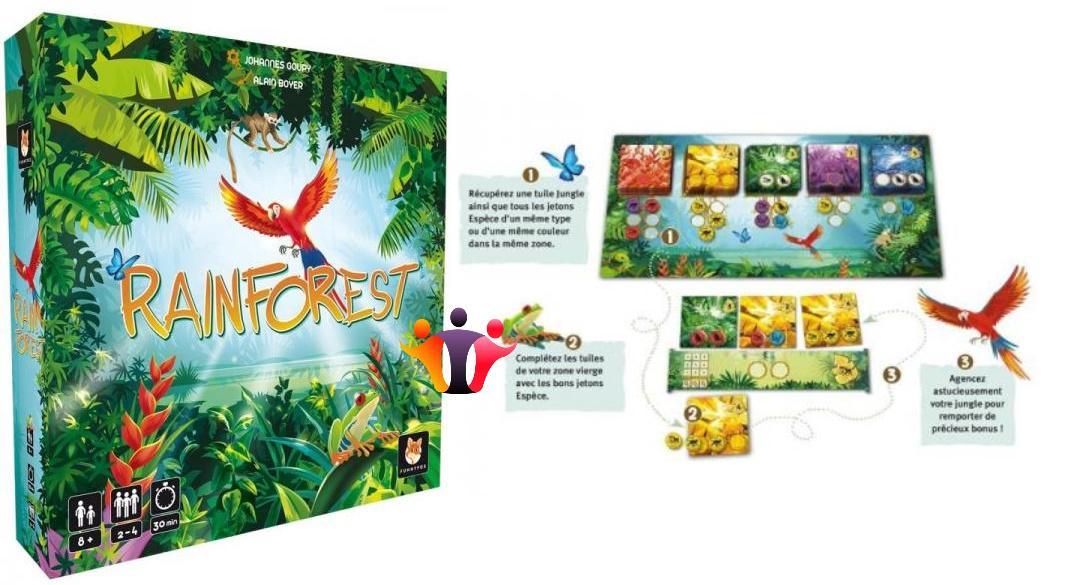
Hello everyone !
Today we are going to talk about Rainforest!
Rearrange the species of the jungle in 20 to 30 minutes, from 8 years old and from 2 to 4 players to recreate a cradle of diversity!
In Rainforest, harmoniously arrange your jungle with different types of vegetation and reintroduce the region's emblematic animal species to help their preservation.
On his turn, the player performs two obligatory actions in order:
1 Take the first Jungle tile from a pile then all the Species tokens of a single color or type from the same zone.
2 Distribute the Species tokens collected on your Jungle tiles inwait in its blank zone then validate those which are completed by moving them into its jungle.
The player chooses one of the 5 areas on the board and performs these two steps in order:
He takes the first Jungle tile from the pile and can either place it in one of the spaces in his blank area, or place it back under the pile if he does not want to take it or if he already has 3 tiles in his pile blank area.
Then he must take all the Species tokens of a single color or type of his choice in this same zone. The totem animal assigned to each player at the start of the game will earn them more points.
The player who collects the last Species token in a zone can immediately exchange one of his Species tokens collected during this turn or from his reserve with any Species token from the central board.
If the player creates an area of 3 or 4 tiles of the same color connected and the two Protected Area tokens of the color are available for the game, the player can immediately recover the token of 3 or 4 tiles.
A player can only have one Protected Area token per color.
The player places the Protected Area token on one of the tiles of their choice in the connected area in question.
If the player combines the 5 colors in his jungle, he collects the Balance token and places it on the tile of the 5th color. A player can only have one Balance token.
If a player has more Species tokens than he can store in his reserve (limited to 2), he must discard the excess into the bag.
He manages his reserve as he wishes: he can discard tokens reserved for previous rounds to store new ones collected this round.
When a player validates their 9th Jungle tile, they trigger the end of the game. The players complete the round of the table until they return to the player who has the Binoculars token, so that everyone has played the same number of rounds. They then move on to counting points.
Each Jungle tile validated in the jungle earns the number of points indicated on it, the Totem Species tokens, protected area and the balance tokens add or multiply the additional points.
The player who obtains the most points wins the game. In the event of a tie, the players share the victory.
Will you manage to make your jungle a cradle of diversity?
Good day and good game ;)
On 12/04/2024
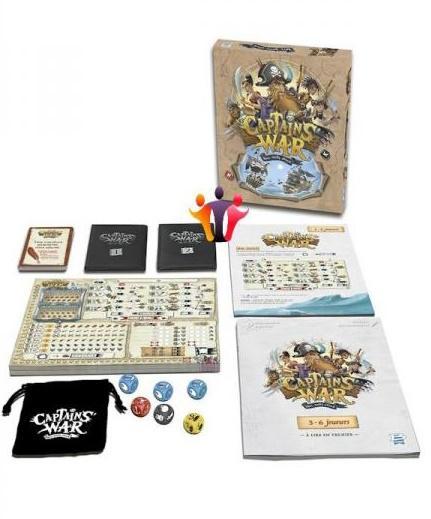
Hello everyone !
Today we’re going to talk about Captain’s War!
Go in search of treasures for 30 to 45 minutes, from 12 years old and from 1 to 6 players to score as many points as possible!
More information: Joulejeuvaison.com
Good day and good game ;)
In the game Captain's War, you play as pirate captains in search of reputation.
Accumulate resources and gold and adorn yourself with attributes worthy of a legend of the 7 seas! Upgrade your boat and attack your rivals to weaken them before the final battle.
The most famous pirate at the end of the game will be declared the winner!
The game takes place in 3 stages:
1. ROLL: ROLL THE DICE!
The active player rolls the dice, discards 1, then everyone chooses two outcomes to expand.
2. WRITE: WRITE!
Once your Resources and Gold Coins have been recovered, spend them on the Attributes of a captain or a new Ship. And don't forget to recruit Pirates into your crew!
3. ATTACK: ATTACK YOUR OPPONENTS!
At the end of the turn, when all the pirates have made their resource choices, their acquisitions and their advances, the active player can trigger a boarding attack.
It's up to you to find the balance and not fall into the bluffers' traps!
ADVENTURE AND EXPERT MODES.
The Captains’ War box allows you to play an adventure for 2 to 6 players! To do this, you will need to open the sealed package and follow the instructions.
Thanks to this package, your game choices and your situation will have consequences on the rest of the adventure. Throughout the latter, you will learn to use the additional modules (Features and Arsenal) which are found in the black sealed envelopes. These modules will be added to your main sheet to offer you new gaming sensations.
Enough to offer great replayability and an expert mode to players who have experienced the classic game mode!
SINGLE-player mode.
The Captains’ War box will allow you to play in single-player mode! This game mode requires the use of the 4 legendary Captains cards available in the sealed deck present in the box.
Face them alone to write your name in pirate legend!
Good day and good game ;)
On 05/04/2024
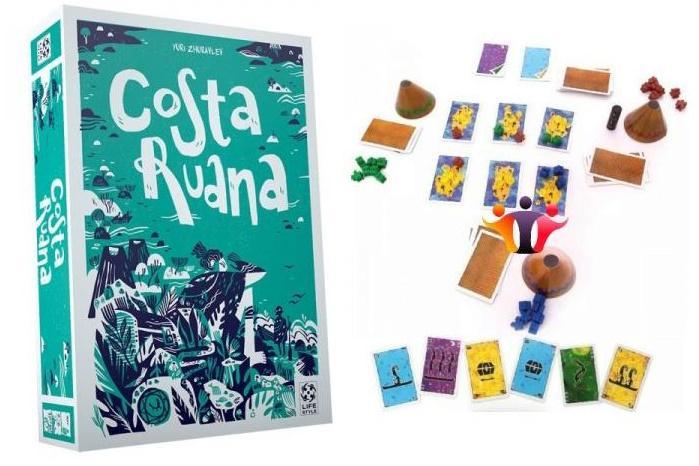
Hello everyone !
Today we are going to talk about Costa Ruana!
Collect treasures with your tribes for 20 to 60 minutes, from 8 years old and from 2 to 6 players to score as many points as possible!
In Costa Ruana, you are a tribal leader. Send your natives to neighboring islands to get your hands on more pirate treasure than your rivals.
If you become a shaman, your decisions affect events, so your rivals will try to influence you through fair or foul means...
Your goal is to score the most points by having treasures in your cabin and natives in your stash at the end of the fifth round.
Treasures are the key: each turn, you collect one on each island on which your tribe is in the majority (or minority, if other tribes are tied there).
Cards allow you to move treasure, place natives on islands, bring them home, or move them between islands.
Each turn, everyone plays a face-up card in front of any player (including themselves), followed by another face-down card (also in front of anyone).
Finally, you can place a native on any card played, even a hidden card played by an opponent, if you are very daring! — to copy its effect for yourself.
The background of each card is four colors, but in each round only two-color cards will be resolved, affecting the players they are played in front of.
The shaman determines these colors by turning over one of the two condition cards. If you are the shaman, use your power to the best of your ability; otherwise, try to guess others or influence the shaman.
Memorize the number of treasures in other players' cabins and carefully manage your natives: a few points can make the difference!
Intriguing, double riddles and bluffs: welcome to Costa Ruana!
Good day and good game ;)
On 29/03/2024
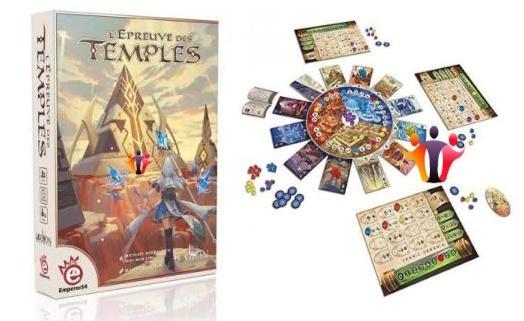
Hello everyone !
Today we are going to talk about the Trial of the Temples!
You will be put to the test for 30 to 60 minutes, from 14 years old and 2 to 4 players to become the best adventurer!
The game offers you a challenge based on choice of placement and ability to adapt.
Game situations will very often lead players to have to answer this question:
“Is it better for me to place myself in a certain place to accumulate resources or is it better for me to position myself here to prevent the development of other players?
“Similarly, decisions made by other players can upset your turn strategy and force you to improvise a new one on the fly.
During the game, players accumulate Power Cubes which will allow them to unlock spells in their Grimoire; some provide immediate bonuses, others are more long-term oriented.
Here again, it is a matter of choice and this “personalization” aspect allows you to opt for several game strategies.
As is often the case in games developed by Emperor S4, the Trial of the Temples offers a game with simple mechanics to learn but which offer a rich gaming experience conducive to twists and turns!
The game works on a principle of accumulation of Victory Points: at the end of the game, the player who has collected the most wins.
A complete game takes place in 5 turns maximum but can end sooner depending on the players' actions!
Pay attention to the actions of others because some may want to end the game faster than you want!
In summary, the Temples test offers, in a package of simple rules and an interesting aesthetic, a game combining reflection, planning and adaptation and the slightest decision (of placement or development) has consequences.
To discover and savor!
Good day and good game ;)
On 22/03/2024
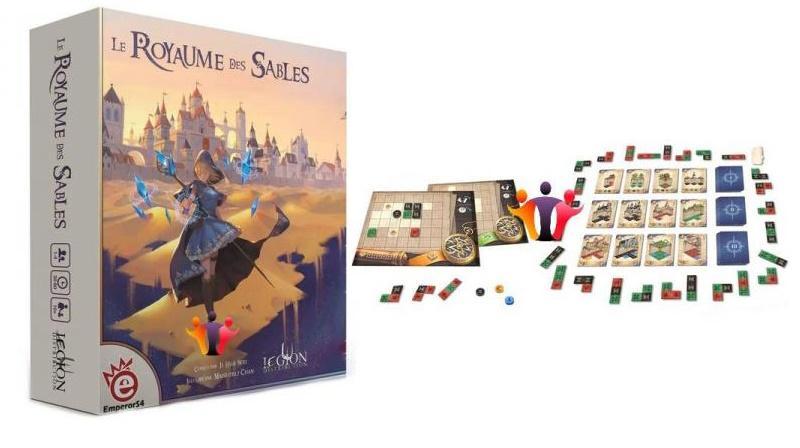
Hello everyone !
Today we are going to talk about the Kingdom of Sand!
It's up to you to build your oases in 20 to 40 minutes, from 16 years old and from 3 to 6 players, and regenerate the magic of the kingdom of sand!
The Sand Kingdom, a parallel reality source of magic, is dying.
After thousands of years of overuse, magic has almost disappeared.
Faced with peril, the Queen of Ragusa embarked on a quest to save her home, traveling to the Kingdom of Sand.
With the kingdom in peril, time bends and reality shifts uncontrollably in the physical world.
As a royal magician, you must act quickly to help him stabilize and regenerate magic.
As she travels the plane awakening the power of the glyphs, you, as the royal magician, must act quickly to assemble these glyphs and stabilize the magic to rebuild the Sand Kingdom.
Who will help the queen save Ragusa and become the hero of the Sand Kingdom?A single player mode is possible.
The game has a simple mode for easy and quick initiation and familiarization with its mechanisms.
An advanced mode, including the use of special powers, adds tactical depth and replayability.
Good day and good game ;)
On 15/03/2024
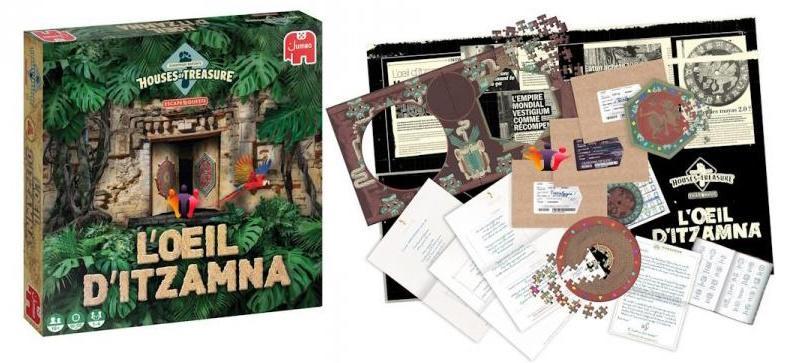
Hello everyone !
Today we are going to talk about the eye of Itzamna!
Follow in the footsteps of the great explorers for 90 to 120 minutes for 1 to 4 players in the heart of the temple!
Jonathan Eaton, billionaire owner of Vestigium Industries, combines running the world's largest company with adventures in temples and mazes.
He leaves everyone perplexed when he announces his retirement.
And even more so when he explains how he will choose his successor: like a modern-day Willy Wonka, he challenges you and your friends to participate in the competition of the century. The winner will receive all Vestigium shares and will be the richest person in the world.
Are you up for it?
Go to your House of Treasures and visit the legendary temple of Itzamna, a Mayan god with great powers.
Search your way through the temple and find the jewel that is the Eye of Itzamna.
Have you completed the quest? Meet for new adventures to replay your game on the site indicated on the game box.
Good day and good game ;)
On 08/03/2024
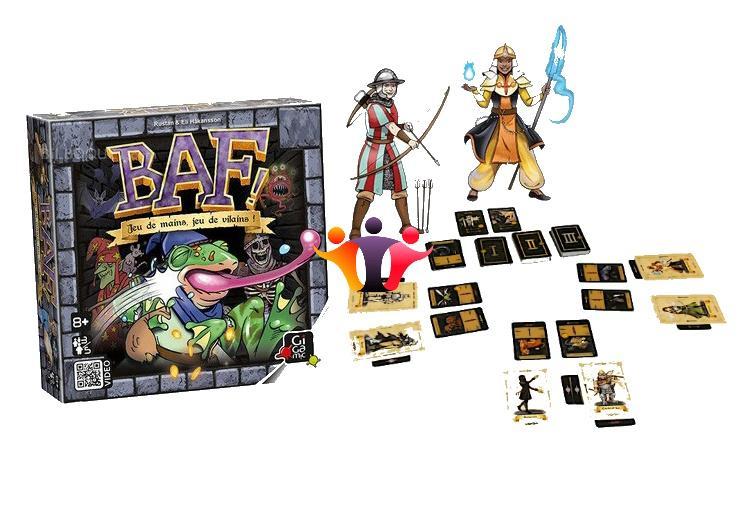
Hello everyone !
Today we are going to talk about Baf!
Brave heroes, from 3 to 5 players for 20 minutes, defeat the monsters to win!
In Baf, players are adventurers rushing through a perilous dungeon to root out evil, earning coins, and upgrading their abilities along the way. After three levels (with three monster towers in each level), they face the Dungeon Lord and the Dragon.
Each player has two heroes, one for their right hand and one for their left hand.
Players simultaneously reveal two dungeon maps each and quickly get their hands on the maps they want their heroes to fight.
If you win, you claim the card as loot or gear that increases your hero's abilities.
Equipment cards are placed partially below your hero card, with the ability symbol sticking out.
This way, the four different types of abilities – Melee, Ranged, Magic, and Stealth – are built in one direction each, starting from your hero.
For particularly strong monsters, your heroes can combine their power by hitting the monster with both of your hands.
Each player controls 2 brave heroes who have joined a party of adventurers.
They go together to explore a dangerous dungeon on 3 floors.
At each round reveal the monsters of the turn then quickly slap them to get rid of them and strip them of their powers and treasures.
But don't get the wrong hand because each one represents a hero with his strengths and weaknesses!
It might just be the monster slapping you!
Good day and good game ;)
On 01/03/2024
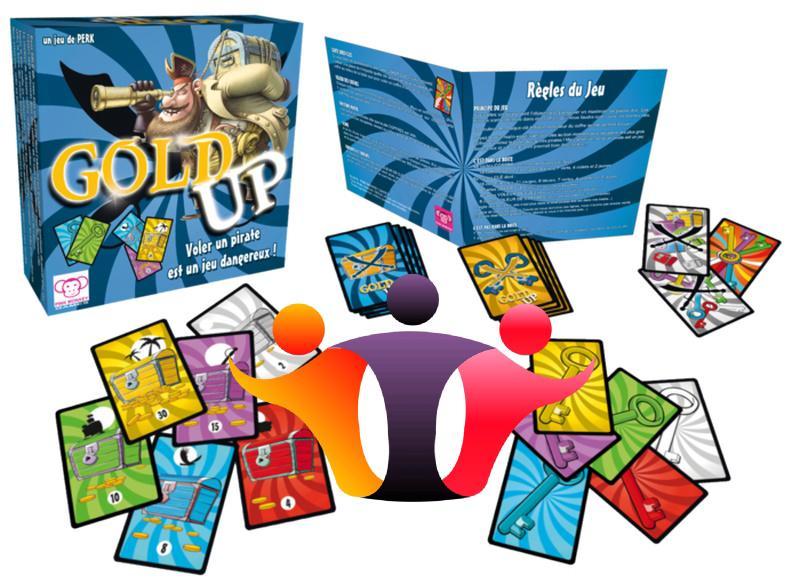
Hello everyone !
Today we are going to talk about Gold Up!
Moussaillons, from 2 to 10 players for 15 minutes, find the treasures!
In Gold Up, you are a pirate whose objective is to collect as many gold coins as possible.
These treasures are locked in chests that you will need to open with the right keys.
The color of each chest indicates the color of the key that opens it.
Be the smartest by using your keys at the right time to recover the biggest chests or steal the loot of other pirates using the special cards!
But be careful, robbing a pirate is a dangerous game and his revenge could be terrible...
Collect one of the 7 sets of chests using the correct keys.
Use the Joker key to open any chest.
Steal your opponents' keys using the Key Thief card.
Steal your opponents' chests using the Chest Thief card.
Arrange the chests in 3,2,1,2,3 on the table then distribute 5 key cards to each player.
Collect the chests of one of the 7 series using the corresponding color keys or joker keys that replace any color.
Steal keys or chests from other pirates with special cards, but be careful not to get them stolen back.
Once there are no more chests in the center of the table, the point values of each chest won by the players are counted.
Whoever has the highest value of gold coins wins the game.
On board, sailors!
Good day and good game ;)
Just activate the English subtitles.
On 23/02/2024
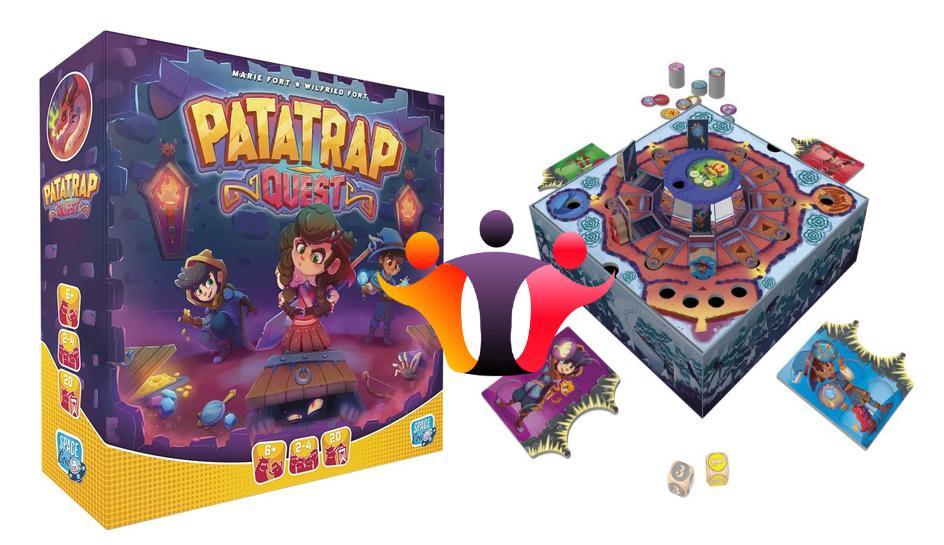
Hello everyone !
Today we are going to talk about Patatrap Quest!
Go on a quest, for 2 to 4 players for 10 minutes, and find the objects to defeat the big bosses!
For a very, very long time, the castle of Patatrap has been regularly invaded by all sorts of threatening and more or less evil creatures.
This is how the order of the intrepid was created, bringing together all the adventurers and adventurers of the region ready to defend the castle of Patatrap and its fabulous Tower with 1000 mirrors!
In turn, each player must move their Character token on the trapdoors of the game board. Use the mirrors to see the contents of the trapdoors.
The goal?
Collect useful equipment to fight the final Big Bad!
The first player who manages to land three blows wins the game. But watch out for trapped hatches, you'll have to remember their location...
Finally, unless the elf, the ghost or even the thief decides to get involved and make a mess.
A real dungeon crawler for children! Includes 5 different endlessly replayable adventures.
Do you dare to face Sheuloub the spider, Michel the werewolf, Elvys the vampire, Smok the dragon or even Babakazoo the cursed king?
To win Patatrap Quest, you must be the first player to successfully attack the "Big Bad" in the castle three times.
The castle consists of a wall of mirrors surrounding a central pillar. On a turn, roll the dice, then move a distance equal to the face of the die or the sum of the faces of the die.
When you land on a space in the castle, your character lowers a lever and whatever is depicted under that lever is then visible in the mirror.
Sometimes you need to scavenge gear, sometimes you need to trade boards, and sometimes you do something else.
When you have the right gear and can access the stairway to the top of the pillar, you can take on the Big Bad.
Draw the topmost token from its stack, then look at it secretly. If you can discard the represented object, you recover this token; otherwise, you're kicked out of the castle and have to start moving in again.
The first player to collect three tokens wins.
Patatrap Quest includes five Big Bads, each with its own stack of chips.
Good day and good game ;)
On 16/02/2024
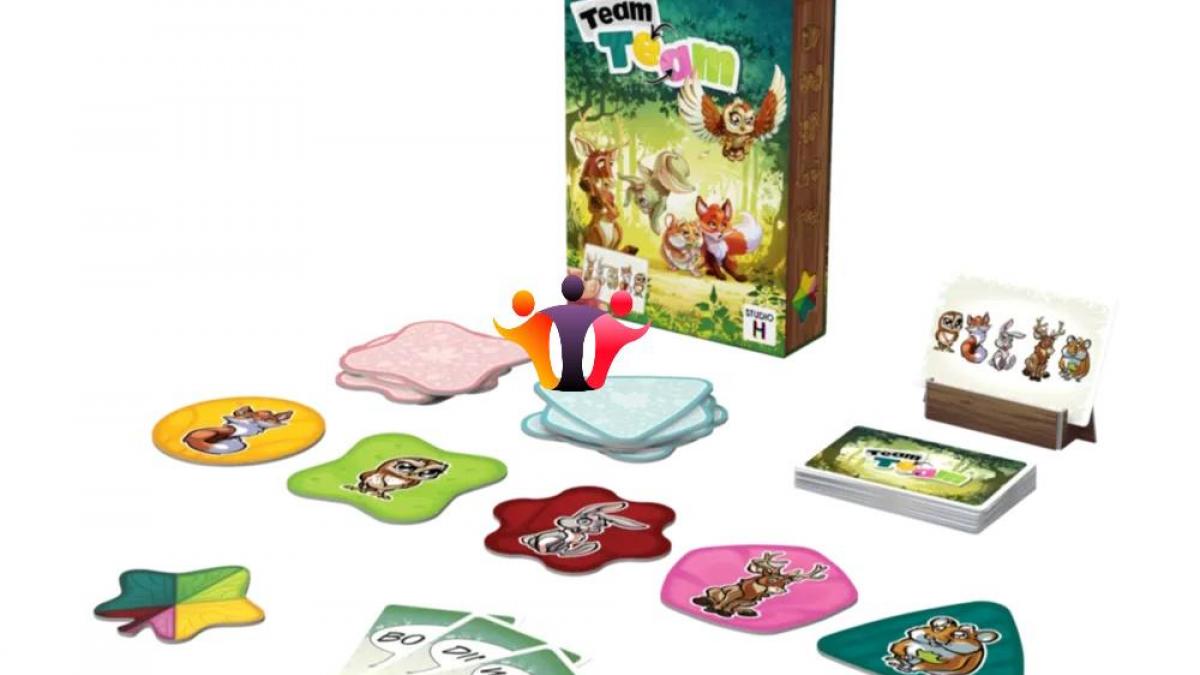
Hello everyone !
Today we are going to talk about Team Team!
Together, from 2 to 6 players for 10 to 20 minutes, find which animal is where!
As you might guess from the name, in Team Team you play as a team, with each team consisting of a speaker and a builder.
Each builder has a set of five tiles, with the tiles featuring five shapes, five colors, and five animals; each team's tiles have a different layout of these features.
Each builder lays his tiles in a row in front of him, and he wishes to arrange these tiles according to a pattern known only to the speaker, the pattern being the same for all teams.
At the start of a round, one of the speakers reveals a sound card, like "Woof!" or "Bong!", then they place a pattern card on a screen that is only visible through the speakers.
The pattern can be 3-5 animals in a row, 3-5 shapes in a row, or 3-5 colors in a row. The game then begins. Each builder begins by placing a finger on two different tiles, then their interlocutor:
Make the sound once - Bong! - if the builder has to finger different tiles.
Make the sound twice - Bong! Bof! — whether the builder should swap the finger tiles.
Make the sound three times - Bong! Bof! Bof! — if all the tiles are laid out correctly.
At this point, the builder slaps the multicolored tile in the center of the table.
If that team's tile layout is correct - and with only 3-4 tiles depicted on a template card, the tiles must be in the correct order and adjacent to each other - then they claim the template card as a point.
If they are incorrect, each other team scores a point.
The first team to score 3 points wins.
Good day and good game ;)
Just activate the English subtitles.
On 09/02/2024

Hello everyone !
Today we are going to talk about Just Desserts!
To your desserts, from 2 to 5 players for 25 minutes, to place perfect orders!
It's Dessert Night!
The guests are here, and they are hungry!
Serve them their favorite sweets in this delicious dessert distribution game.
Become the best server of the evening by ensuring that all guests get their perfect desserts!
The guests are here, and they're hungry, so try to be the best waiter in this cafe by making sure all the guests get their perfect desserts!
In this card game, each player starts with a hand of three dessert cards while three guest cards are placed in the center of the table; each dessert card shows 1-3 tastes it satisfies, such as chocolate, fruit or pastry, while guest cards show what they crave as well as what they refuse to eat.
You take turns drawing a dessert card, adding a guest card to the table from the draw pile, then performing one of three actions:
- Serve (and claim) one or two guests by discarding one or more dessert cards to give them what they want (while avoiding what they don't want); if you give a guest their favorite item, you receive a tip with an additional dessert menu.
- Draw another dessert card.
- Lay down as many dessert cards as you want, then draw as many cards from the deck.
At the end of your turn, discard guests from the table so that only one guest from each "suit" is still waiting to be served - but the guest heading for the door (top of the discard pile) can still be claimed by any server.
If at any time you have served three guests of the same costume or five guests of different costumes, then you have won!
Just desserts includes game variations that let you steal guests from another server by sending more candy, force other servers to each drop a guest, and throw a surprise party to claim a guest out of turn.
Good day and good game ;)
On 02/02/2024
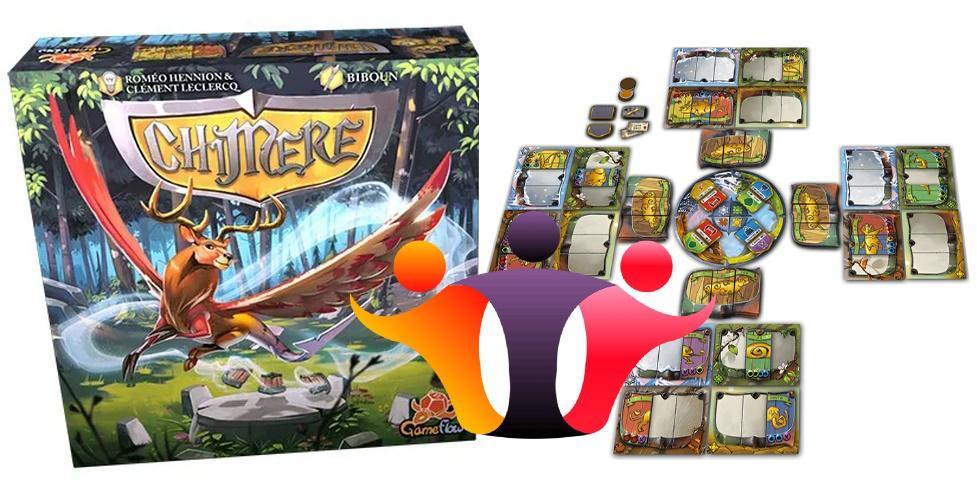
Hello everyone !
Today we are going to talk about Chimera!
Create your chimeras, from 2 to 5 players for 30 minutes to 45 minutes, and score the most points!
In Chimera, each player embodies a magician at the court of a King who has decided to entrust his Kingdom to the best Court Magician.
Each magician now has the task of convincing the king that he is the best magician in the court.
To do this, they organize a big magic tournament with various competitions.
For each competition, players must craft a fabulous creature made up of a mix of three real animals.
These chimeras then compete in various trials to determine the best magician.
Three-ingredient creatures are created simultaneously by all players drawing from the three decks of creatures in front of them, placing the cards face down on one of the four contest areas in front of them.
Once players have chosen their three ingredient creatures for each of the four contests, they can trade ingredient creature pieces between their four different contest tiles.
Contests can include Mud Wrestling, Funniest Creature, First Blood Battle, Potato Sack Race, and Cutest Creature.
Only four are chosen from the available contest play, and only the first and second place players in each contest receive points.
The first player to complete their selections for all four contests can declare they are done, putting a 30 second time limit for all other players to complete their choices.
Voting takes place between players to see who has the best creature featured in each contest.
Three rounds are played with the aforementioned stages, with creature and contest cards being reshuffled and redrawn.
Each round lasts approximately 10-15 minutes, for a total of 30-45 minutes per game.
1- Look for the natures of animals most suitable for competitions.
2- Merge your animals to create your chimeras.
3- Optimize your creations to win as many competitions as possible.
Good day and good game ;)
On 26/01/2024
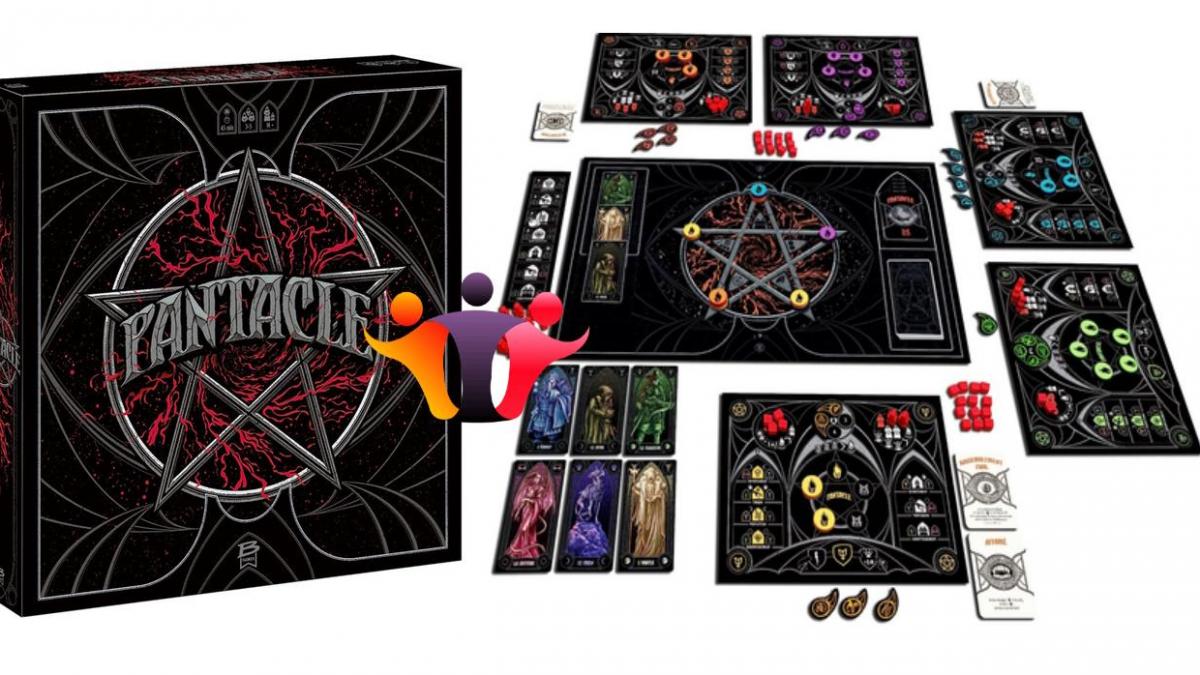
Hello everyone !
Today we are going to talk about Pantacle!
Light the 5 fires, from 3 to 5 players for 45 to 60 minutes, thanks to your adepts!
Play as a wizard and be the first to light the 5 Pantacle fires!
Each player must gather enough resources (Influence (cubes), Adepts (meeples), Powers (tokens)) to light the flames of the PANTACLE one by one.
These resources can only be obtained by requesting favors from the Guardians of the PANTACLE.
There are 7 types of favors that provide either resources or powers whose effects will aid your progress. Be careful though!
If another player has the correct set of cards in hand, they can counter your request and bribe you for the favor.
To ignite a flame on the PANTACLE, players must regularly sacrifice accumulated resources.
The more the players progress, the more the PANTACLE resists and the more the game becomes complex.
Indeed, a player who lights a flame receives a reward (resource, power) but also a curse, despite the sacrifice of resources.
To do this, seek the guardians of Pantacle who will bring you the necessary powers, influence and followers.
But beware of your opponents because, if one of them has the right combination of cards in hand, they can thwart you and steal the benefit offered by the guardians.
Guardians can suspend a curse for a while, but will other players let them?
1. Ask the Guardians of the Pantacle to acquire influence, powers or followers that you will place on your player board.
2. When you have enough followers, power and influence, sacrifice them to light one of your flames on the Pantacle.
3. The difficulty increases for each flame lit: you will receive a curse that you can cancel by requesting the Guardians or by meeting its criteria.
4. Beware of your opponents. If they have the right combination of cards, they will be able to counter you when you call on the Guardians and steal the benefit of your solicitation.
The first player to light 5 fires wins the game!
Good day and good game ;)
On 19/01/2024
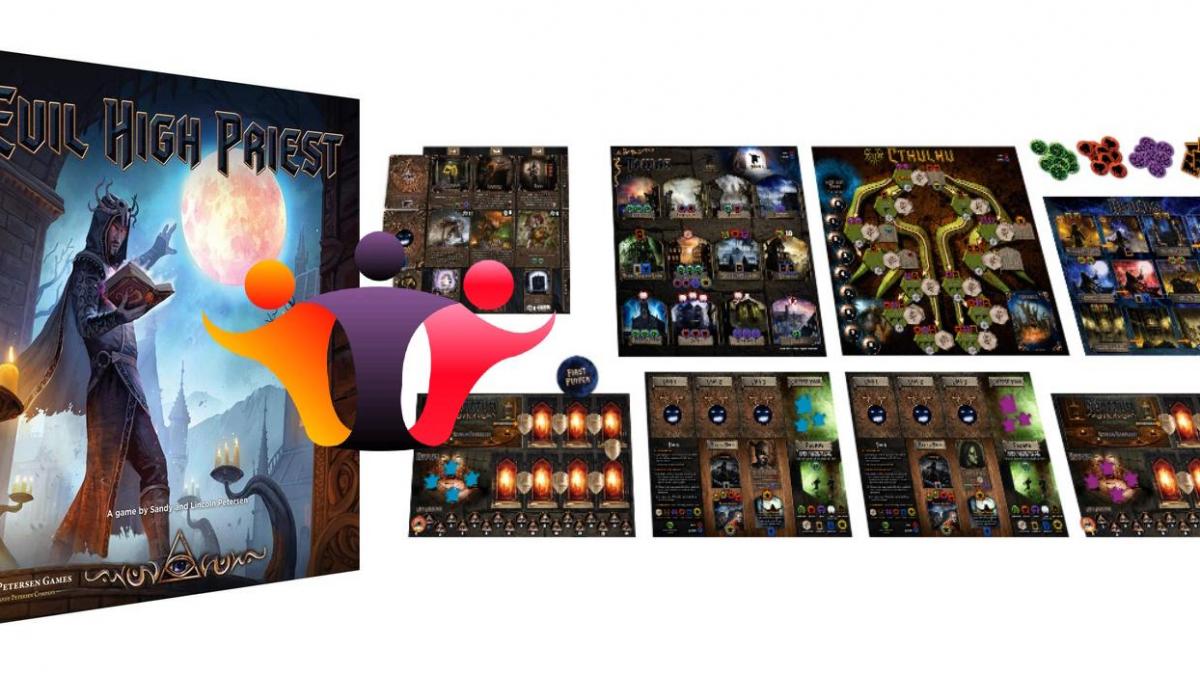
Hello everyone !
Today we are going to talk about Evil High Priest!
Recruit in the Lovecraftian universe, from 2 to 5 players for 40 to 90 minutes, and win the most victory points!
Evil High Priest is a worker-placement game in which the players take the part of priests of a Lovecraftian entity. All players worship the same Great Old One, but they are emphatically not allies.
When they awaken their Great Old One, he will decide which among them is the best (based on VPs) and appoint that priest, and that priest only, to be the High Priest, who wins.
The game contains cards, cardboard tokens, and multiple different boards - each player has an inner sanctum, plus a priest board to manage his sect. In addition there is a town board, representing Lovecraft country; a ritual board, representing magic spells; and a cult board, representing the Great Old One you seek to release.
The game is performed in Action phases. the players take turns moving their cultists to activate various sites on the different boards, gathering resources, summoning monsters, shattering Elder Signs, and launching investigator raids (which attack all players). When all players run out of cultists, the Action phase ends, and players recover their cultists, freeing up the board sites for the next Action phase.
Victory is determined when the last Elder Sign blocking your Great Old One is shattered, and at this point everyone totes up points. Different resources are worth different amounts, but the most valuable are the Elder Signs.
Driving the game are the player's need to recruit more cultists & gather more resources, balanced against his need to shatter Elder Signs and protect himself against the deadly investigator raids.
Unusual among worker placement games, the cult board can be swapped out between games, for a different experience.
The Cthulhu cult board does not play the same as the Black Goat cult board, and they require different tactics and planning.
Good day and good game ;)
On 12/01/2024
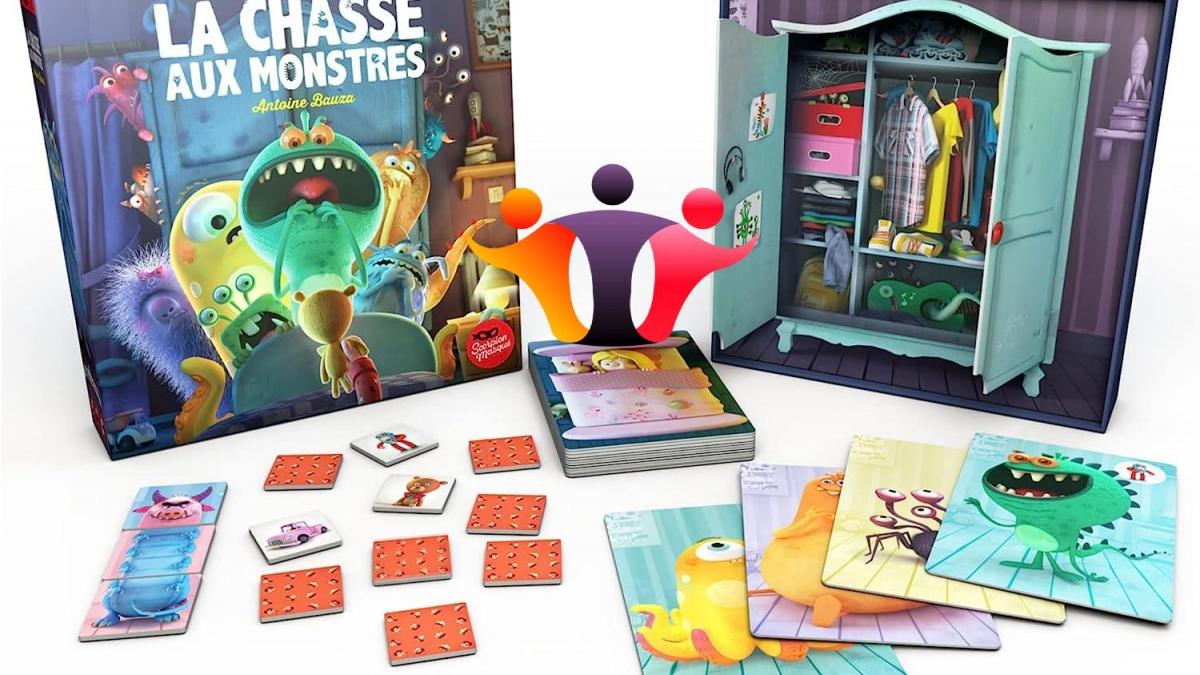
Hello everyone !
Today we are going to talk about Monster Chase!
Go on a monster hunt, from 1 to 6 players from 10 minutes, by finding what scares them!
Monster Hunt is a cooperative memory game for players ages 3-7.
In the game, monsters come out from under the bed and try to surround it.
Each monster is only afraid of one toy that will banish it to the closet among the ten available to find.
If the players manage to send all the monsters to the closet before they can close the circle around the bed, they win!
Otherwise, the monsters are declared the winner.
In game terms, face down cards are placed on the table with tiles and then placed around those cards.
To start, a card is revealed that represents a monster and the toy it is afraid of.
In turn order, each player must now find the toy that scares that monster, with the toy hidden in the face-down tiles.
If players make three mistakes while searching for this toy, a new monster spawns with a different toy needed to scare it away.
Once all the monsters are out, you only have three chances to win by getting rid of all the monsters.
The rules offer different levels of difficulty to adapt to the player's experience and/or maturity, such as a tile that shuffles other tiles and a tile that instantly spawns a new monster.
Good day and good game ;)
On 05/01/2024
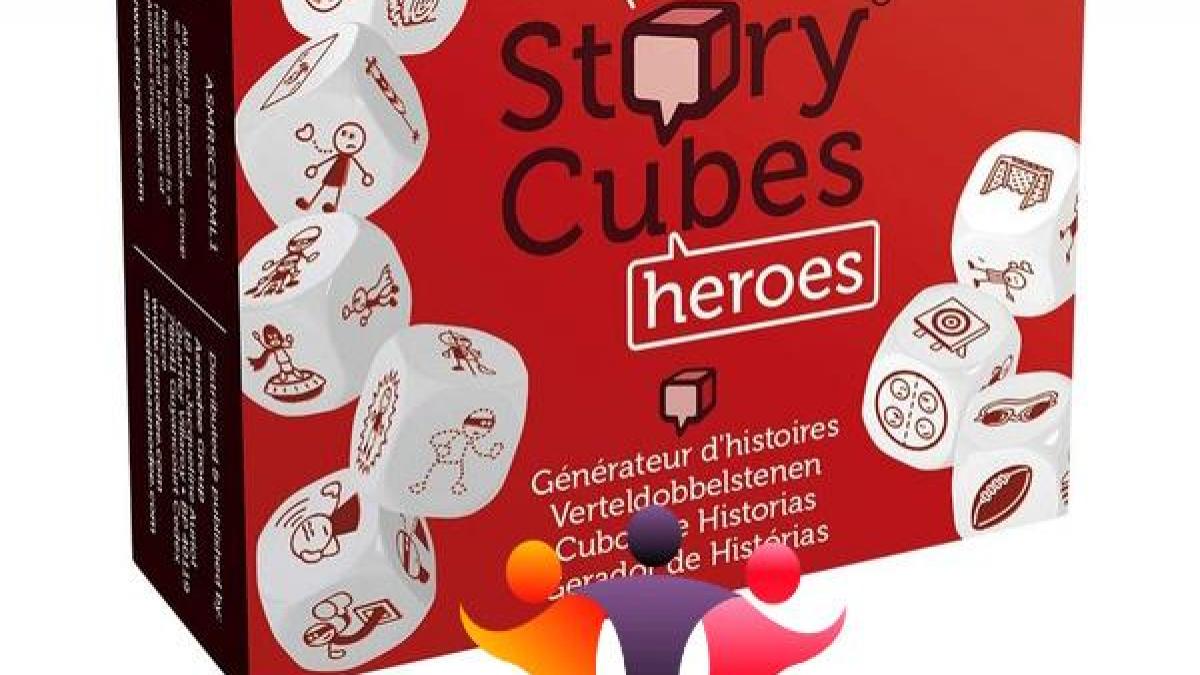
2 words game Story cubes heroes
Hello everyone !
Today we are going to talk about Story cubes!
Sharpen your mind and imagination, from 1 to 12 players from 20 minutes, by creating original stories!
Story Cubes is a game where you have 9 dice to create stories.
54 images that allow you to create different stories in each game.
You can play either simultaneously and create a story all together or choose to roll the dice each in turn and create a story with the 9 images of the turn.
With the 9 cubes you can generate 9 random images, then use them to invent a story that begins with "Once upon a time..." and use the 9 elements as part of the story.
Whether you play alone or with others, the game allows you to develop and express your narrative creativity.
The game can be played as an improvisational game where each player contributes a part of the story, picking up where the last one left off.
One can earn reward points for fluency and originality in story creation, inventiveness, imagination, drama and humor.
It's up to you to set your points allocation criteria according to your centers of interest, with more or less serious criteria, to enjoy the game as you wish.
So get started and give free rein to your imagination to have a good time with family or friends.
Good day and good game ;)
On 29/12/2023
